



Exhibition Tour and Artists Talk (Magnus Eriksson and Geraldine Juárez)
Saturday 03 May 2014, 2pm
Exhibition tour led by Magnus Eriksson and Geraldine Juárez followed by a live walk-through of the Piratbyrån archive and talk about some overlooked gems from their history at Furtherfield Commons. Expect to learn some Swedish while we are at it!
SEE IMAGES FROM THE PRIVATE VIEW
Contact: info@furtherfield.org
Curated by Rachel Falconer & Furtherfield
EXHIBITION TRAILER – Piracy as Friendship
@Furtherfield “Don’t contact future. Future will contact you!”
“For the last sixty years, capitalism has been running a pretty tight ship in the West. But in increasing numbers, pirates are hacking into the hull and the holes are starting to appear. Privately owned property, ideas, and privileges are leaking into the public domain beyond anyone’s control.” – Matt Mason, The Pirate’s Dilemma
Piratbyrån and Friends traces the stories of cultural sharing and affinity-building among the activities and values of the members of Piratbyrån (The Bureau of Piracy). This Swedish artist/activist group was established in 2003 to promote the free sharing of information, culture and intellectual property. The exhibition presents screenings, installations and artworks by founding and more recent members, keen to tell the story of the group on their own terms. It features newly commissioned work by artists Geraldine Juarez and Evan Roth, and a new networked audio collaboration which mediates their rich archive and foregrounds the role of piracy as an agent of innovative disruption and cultural transmission.

“The specific character of friendship as a form of social relationship is that it does not presume a permanent interaction. Friendships are a type of serial solidarity. The story of friendship is a story of meetings.” Viktor Misiano – The Institutionalization of Friendship.
Piratbyrån have always resisted clear definition. Created on the Internet as a loose friendship group with a shared commitment to media and piracy in the shifting ecologies of digital copyright law, Piratbyrån operated through a number of different identities. From the #discobeddienti IRC chatroom, to the infamous Pirate Bay, to the determinedly analogue SX23 bus trip to Manifesta 7, and their subsequent disbandment in 2010, Piratbyrån consciously cultivated an air of mystery and intrigue around their many activities.
Piratbyrån have always had a particular commitment to the value of friendship as a shelter for culture and a space to understand, imagine and experiment as a community from the edges of the Internet.
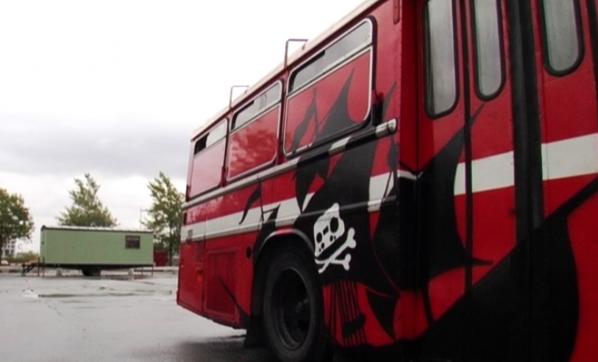
The exhibition features newly commissioned sculptures and installations by artists James Cauty, Geraldine Juárez and Evan Roth and a screening programme that includes Steal This Film by Jamie King and Piratbyrån and Friends by Geraldine Juarez.
Tapecasts (2013-2014) – Piratbyrån and Friends
SK23 Suit (2008) – Lina Persdotter Carlsson / Piratbyrån
S23m Manifesta Bus Trip (2008) – Piratbyrån & Simon Klose
S23x Belgrade Bus trip (2008) – Piratbyrån
Polymarchs posters (1980-1990) – Jaime Ruelas
Sharing is Caring Map (2008) – Sara Wolfert / Mathias Tervo / Piratbyrån
Kopimi Totem (2014) – Evan Roth
Torrent Tent (2014) – Geraldine Juárez
Riot Chat (2014) – Palle Thorsson
Smiley Riot Shield 2 (Second Edition) and PB2 (2014) – James Cauty
Piratbyrån (The Bureau for Piracy) was started by a bunch of hacking, coding, reading, listening, philosophising, clubbing, rioting, carding, chatting, loving, slacking people in 2003 as an antidote to Hollywood’s representatives in Sweden – Antipiratbyrån.
In 2007 – after having kickstarted the Swedish debate over file-sharing, which by the time had become a major issue in the previous years national election and after having created The Pirate Bay as a side-project that became the world largest file-sharing system – the people from Piratbyrån had grown tired of the file-sharing debate and its endless repetitions of for-or-against, legal-or-illegal, payment-or-gratis. At the last day of April in a Walpurgis fire on the top of the highest mountain in Stockholm the masked members burned the remaining copies of a book on file-sharing they had published some years earlier and declared the debate dead. The video documentation of this ritual, set to the soundtrack of KLF’s “What Time is Love”, found its way to the Indian Raqs Media Collective group who was just about to curate the next Manifesta biennial in Bolzano, Italy.
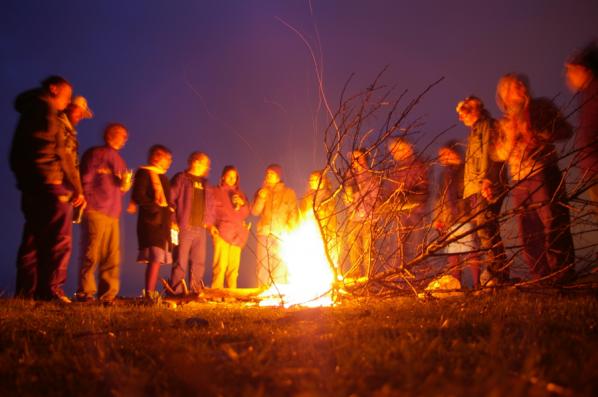
The loose network of Piratbyrån, now loaded with 7000 Euros of art budget and a sizable amount of cash from selling Pirate Bay t-shirts, decided to purchase, renovate and decorate a 1970s city bus, stack it with 23 people, and head down south.

The ongoing relation with the bus – named S23m/x/k respectively for each trip – would later make an exodus from the exhibition in Italy to head across Eastern Europe and end up at the trial against Pirate Bay. It became one of the most significant undertakings of Piratbyrån and shaped their thoughts on the tensions between digital abundance and crowded space, collective decisions and freedom of choice, and that which can be copied and that which can’t. The bus became a line of flight from the collective subject that had been built, a subject which was very associated with The Pirate Bay and also with Swedish politics, including the Pirate Party.
While nothing was really the same after the bus had returned, Piratbyrån formally lasted until 2009, when the tragic death of one of the founding members – Ibi Kopimi Botani – defined the end of an era. The Internet had already transitioned to another phase and it is not until now, and enough time has passed, that we as a culture are ready to reflect on what exactly happened during those years.
Piratbyrån always had an implicit friendship with the KLF. They share the same historical web of connections and share a similar trajectory, but their activities are shifted in time by roughly a decade. The only contact between the two is a response from Bill Drummond when Piratbyrån sent a link to the documentation of the Walpurgis ritual. It read:
> Thank you for your email.
> I have just read the text at the link.
> I enjoyed it and understood it.
It is probably good that they didn’t exist at the same time because the gap in time gives the relation an infinite unresolvable tension of unfulfilled connectivity and unlimited possibilities.
James Cauty
For Piratbyrån, James Cauty’s personal work resonates with the themes of abundance and rarity, presence and absence, functionality and waste, control and chaos, and draws on the same symbolic language that mixes clarity with suggestion. There is also a similar urge to *stir things up* and *stick ones nose where it doesn’t belong*.
Evan Roth
Speaking of stirring things up, FATLAB was for Piratbyrån another one of those instantly recognisable friends that had never met; the art group that Piratbyrån never became, the “the unsolicited viral marketing wing of the open-source movement”, the graffiti crew of the World Wide Web. FATLAB was born when the file-sharing debate was buried and the new web 2.0 era transformed the web.
Evan Roth, co-founder of FATLAB, has made a piece for the exhibition that in a subtle but direct way captures the concept of KOPIMI; how meetings and connections leave traces and makes you a carrier of ideas and information, sometimes without you even recognising it.
Jaime Ruelas & Polymarchs
The soundsystem collective Polymarchs and their illustrator Jaime Ruelas, probably happily unaware of the existence of Piratbyrån, embodies a scene in Mexico where piracy has always been a way of life and a mode of existence. They have materialised, expressed and lived what was only hinted at in glowing screens up in Sweden. Having outlasted all of the above mentioned collectives and managed to stick together for decades, they also highlight both the potential strength and – as a contrast – the fragility of so called “confidential projects”; those moments when friendships turn into expressive units and the borders between the intimate and the public are blurred.
Geraldine Juárez
Last but not least, Geraldine Juárez is the reason this exhibition came together at all. She began to read the Swedish-language blogs of Piratbyrån members through Google translate – whose mistranslations made them sound like they came from the near future instead of the near past, until she finally came into contact with Piratbyrån by translating updates from the trial – or Spectrial, as it was known – into Spanish. Now she returns the favor of time-travelling by re-awakening Piratbyrån one last time, to allow their archive to again live up, their ideas to be carried over to others and perhaps even some sense made from what happened, although these things can only be interpreted, misunderstood and re-appropriated – never explained.
Inside the tent that she has crafted for the exhibition – a torrent for piracy as the last shelter of culture – there will be a collection of tapes prepared and circulated by Piratbyrån and friends, perhaps giving some seed for thoughts and guidance in the process of excavating the archive of Piratbyrån.
About co-curator Rachel Falconer
Rachel Falconer is a curator, writer and producer working at the intersections of technology, the media and contemporary art. She currently holds the position of Head of Art and Technology at SPACE and runs the art and technology programme at The White Building and SPACE MediaLab. She is Co-Editor at Furtherfield and a founding member of the collective Hardcore Software.
Her curatorial practice is hybrid and interdisciplinary in approach and her current activity and research focuses on the pathologies surrounding social spaces and human behaviours engaged with networks and new technologies.
Furtherfield Gallery
McKenzie Pavilion, Finsbury Park
London N4 2NQ
T: +44 (0)20 8802 2827
E: info@furtherfield.org
Furtherfield Gallery is supported by Haringey Council and Arts Council England
The artist and curator Art Clay was born in New York and lives in Basel. He is a specialist in the performance of self created works with the use of intermedia and has appeared at international festivals, on radio and television television in Europe, Asia and North America. His recent output focuses on large media based performative works and spectacles using mobile phone devices. He has received prizes for performance, theatre, new media art, music composition and curation. As an educator, he has taught media and interactive arts at various art schools and universities in Asia, Europe and North America including the University of the Arts in Zurich. He is the initiator and Artistic Director of the ‘Digital Art Weeks International’ and the Virtuale Switzerland.
Eva Kekou: Could you tell us about your work and what inspires you?
Arthur Clay: The question about inspiration has been posed to me before and most often in the moment when people first see the program that the Digital Art Weeks (DAW) is offering. As an artist I am very much inspired by the every day. I think it is important to be aware of the things around you and by so doing, my artwork seems to have more of a present day dialogue and the events I curate more to do what is actually going on in the society around me. So basically, everything and nothing and all the things in between inspire me. There are no rules, but with a lot of effort to try and come closer to things might be the one I apply the most.
On the one hand, I am a practicing artist and most of this work is concerned with sound. On the other hand, I believe that curation is an art in itself and requires a high level of creativity. It is easier for me to make an artwork in comparison to harmonizing a group of artworks. The two meet in the fact that I grounded the DAW projects in order to provide a platform for my own work and that of others, who think in like minded ways.
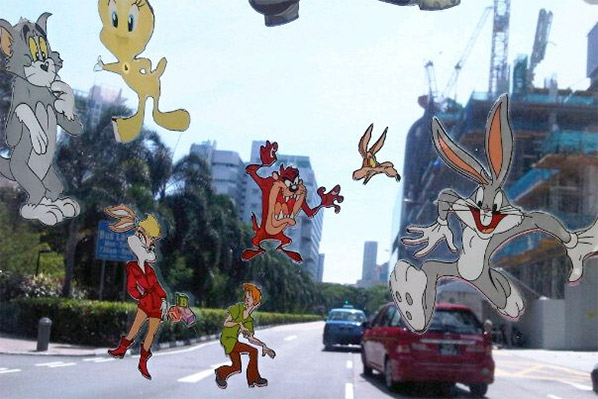
EK: You were the curator for the Augmented Reality exhibit “Window Zoos & Views” in collaboration with the participation of the School of Digital Media and Infocomm Techology from Singapore Polytechnic. On the project site, it mentions that the main element of the project was inspired by an image of a car driving down Singapore’s legendary Orchard Road. Could you tell us a bit more about this and the project?
AC: As DAW Director, I am confronted with the same situation each time we bring the festival: Representation and integration. By representation is meant that we have institutions both public and private that act as stakeholders and in turn expect a high level of visibility; talking about integration is much more complex, because there are many levels of integration that must be addressed. First off, the festival structure demands that we integrate local artists into the program along with the international artists participating. Integration of local artists can also mean or entail a high level of knowledge and skill transfer. We do all this during what we like to call the “Exploratory Phase”, which is basically entails dropping the DAW team into a unfamiliar city and making every effort to make it familiar. This includes becoming aware of the general culture the festival will address, how digital that culture is, the art and non art spaces that will become the stage of the festival, and of course trying to find out who is doing what in terms of arts and technology.
To get back to your question about the image of the car driving down the street, the most important element of integration is becoming aware of what is going on in the world of things in which the festival is to be presented. The car we are talking about was a car whose windshield was plastered with cartoon stickers. So, imagine you’re self-sitting at the wheel of that car driving down Singapore’s Orchard Road. It is a really surreal experience; the stickers take on a kind virtual elelment as it floats down Orchard road. The image sparked my imaginations and the AR Parade project was born, which was a very important part of the “Window Zoos and Views” exhibit. Basically, the AR Parade mimicked the effect of the stickers on the car window, but instead of a car windshield, we used an iPhone app to view the images. It was very cool, popular on the street and got a lot of clicks.
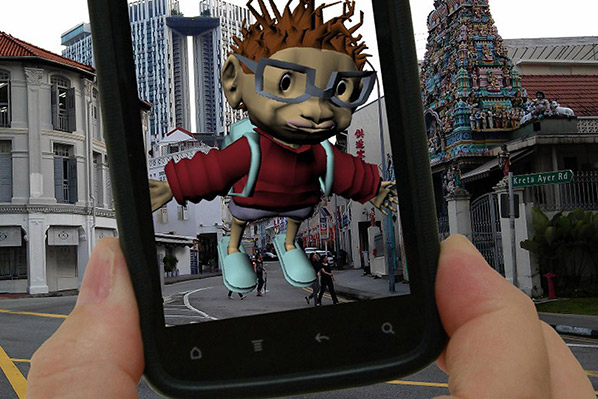

EK: There were various artists in the festival showing Augmented Reality art as installations. This included artists such as Tamiko Thiel (DEU), John Cleater (USA), Will Pappenheimer (USA), Lily & Honglei (CHN), Marc Skwarek (USA), Lalie S. Pascual (CHE), John Craig Freeman (USA), and Curious Minds (CHE). It must of have taken a lot of time and energy to organize this, especially the technological aspects of the project. How difficult was it to set all of this up?
AC: In one word: impossible. It is new area of technology, a new approach to curating art, and above all you are dealing with a non-art public – basically anyone who is on the street. That is a big challenge. Add to it the new type of management skills that such an international project work requires and I think you are close to the impossible that I am referring to. For such exhibitions, “Management 2.0” skills are a necessity. The artists, the tech people, and the curators and admins meet and work solely in virtual space. So there are no walls, no tables, and there is no going for coffee together after the meeting. It is a different world from all sides.

Another interesting aspect of this work is that you have to develop a feel for the city and develop a dialogue with it. For the Hong Kong show we did for SIGGRAPH Asia, Monika Rut and I spent about a week working on site, visiting the different areas of the city to check things out and to get a feeling for which works should go where and why. We travel with a lot of special equipment so that we can make tests on site and produce a mock up of the exhibition and test how the experience of viewing the exhibit will be. It is very inspiring but exhausting work and the dialog between Monika and I helped greatly in making all the decisions. Basically, we get to know the cities we are working in quite well and the kick back is, you get to know where the best coffee houses and local restaurants are.
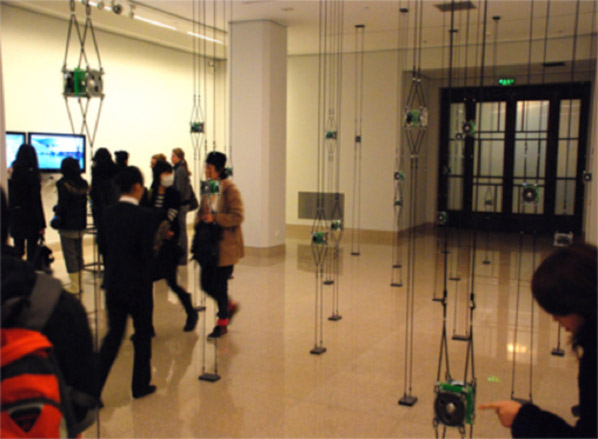
EK: Why hold the DAW in Asia, and what kind of differences do you experience culturally when working in Asia compared to working in Europe?
AC: The DAW is at home in Asia and much of our curating has to do with having visitors get pro-active. This means that it is not just about looking at an artwork, it also entails actually touching the artworks in many cases. In Asia, the museum visitors are not that schooled in museum etiquette. They like to touch things and this is great for the kind of work we like to do. Things break, but it is kind of a “I Like” thing for us.
The other aspect to consider is that you have a language barrier, because no one is going to understand anything if it is not translated. Here, it is also important to know that the approach Europeans take in terms of explaining artworks, does not really come over so well in Asia. Things are often inspired by poetics of nature in Asia and are much less conceptual than works coming from Europa.
Last but not least, the role of size also plays a large part in Asian arts. When a dynasty was at its peek, it produced very large artworks, monuments etc. So size is historically a sign of wealth and prosperity in Asia. When a dynasty fell, they produced much smaller works. So the bigger the better, so to say. For a European artist this is completely meaningless, however, bigger artworks have more visibility. So when you are curating group exhibits in Asia that artists from diverse countries, it is a challenge to keep balance in terms of impact of the works.
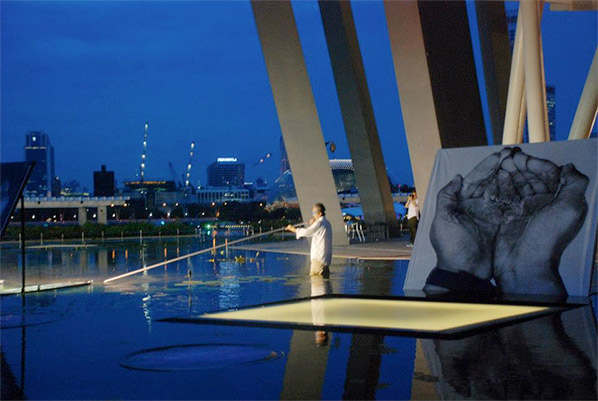
EK: Getting back to There DAW AR Float Parade, which was the first of its kind and celebrated as the coming age for Augmented Reality art. Could you tell us more about this aspect of the festival’s project and how it turned out?
AC: Knowledge transfer plays a major role in getting a project like the AR Parade to work. The DAW has an “OutReach Program”. This is a program that invites creative leaders from around the world to hold workshops before or during the festival. The contents of the AR Parade in Singapore were the results of a workshop with the AR artist John Craig Freeman and the Curious Minds group. John Craig dealt with the technical details and the bootstrapping a group of twenty-five creative industry students from the Singapore Polytechnic. The members of the Curious Minds art group hung around, integrated the group into the DAW, taught the students about public interaction, and came up with how to go about actually making the AR Parade happen and come to life.
The proof of a good project for me is when it takes on its own life on after its initial presentation. After the Singapore DAW, the AR parade went to Hong Kong and in 2015 it will be shown marching down the Bahnhofstrasse in Zurich as part of the Virtuale Switzerland festival – the world’s first festival “virtual biennale” that focuses solely on virtual artwork. For this we want to go a bit deeper into the creative industry world and see if we can act as modern alchemists and pick up on the float parade from New York and turn Miss Kitty into an artwork by shifting context from the real to the virtual.

Live- Performance “Beads are the Breath of the Landbridge “ with 1st Nations artists, Peter Morin. (DAW Singapore 2013)
EK: What is your view regarding the social contexts of the DAW?
AC: Basically, we are concerned about things and we make an effort to improve things that are within our reach to improve. For the festival in Taipei that will take place in 2015, we are really trying to make people aware of the role of creativity in general. Artists are highly creative people and the world really needs good ideas as well as a more social approach. We try to provide an answer to the question: “How is what we do of benefit to the society in which we are operating?” We think this should be more a question that businesses should be asking themselves. The future needs fewer companies who are “profit first, prosperity second” and more social entrepreneurships that embrace social needs as part of their business model.
EK: Could you tell us what themes and aims we can expect from of the DAW project in the future?
AC: We are off to Seoul, South Korea in 2014 and the theme there is “Creativity and Convergence”, which is a hot topic in Asia, because the government feels that innovation is intimately connected to being creative and thinking out of the box. I think they’re thinking of what makes the West tick and in an odd and ironic way to imitate – which is not exactly creative, but then again I have lot of respect for Asia and admire the work ethic of Asian people. So I think they will do well by addressing these themes. In 2015, we are off to Taipei and the theme (working title) there is “ImagiNation” and here we are trying to run a kind of “Skills-Festival” and platform creative businesses and the approaches that they have taken. It is a new approach and if you think about what Beuys said, “Everyone is an artists”, we might stretch it a bit and also say “everything is art.” At least this is the start and interestingly enough we are working with groups from the labor department in Taiwan, with knowledge transfer departments of universities, and with spin off and start up companies from Switzerland. It is very exciting and really what the DAW is about: creating a platform for research and experiments in social-cultural context.
Digital Art Weeks International
The DAW INTERNATIONAL’s is concerned in general with the bridge between the arts and sciences in cultural context with the application of digital technology in specific. Consisting of symposia, workshops and cultural events, the DAW program offers insight into current research and innovations in art and technology as well as illustrating resulting synergies, making artists aware of impulses in technology and scientists aware of the possibilities of application of technology in the arts.
The Virtuale Switzerland
The Virtuale Switzerland is a biennale for virtual arts. It focuses on the use of public space and mobile communication technologies, inventing “playful” new strategies to coax the public into the festival as “real” visitors with a unique experience of the virtual. The Virtuale Switzerland encompasses Artworks using Augmented Reality, Urban or Location Based Gaming, and Digital Heritage applications. It is interdisciplinary in nature, bridging areas such as art and technology, digital heritage and tourism, as well as digital culture and art mediation.
The end of boom and bust ended with the credit crunch. Following the global financial crisis of 2008, the Eurozone crisis has produced technocracy and poverty rather than democracy and wealth. Reactions to these failures of monetary policy are informed by technology as never before, from austerity being imposed thanks to an Excel spreadsheet bug to the rise of the anti-statist cryptographic currency of Bitcoin.
Against this backdrop of monetary failure and technological critique, _MON3Y AS AN 3RRROR | MON3Y.US is an ambitious online survey of net art depictions and critiques of money and its institutions curated by the pseudonymous curator “Vasily Zaitsev”. As well as the work from 70 or so artists invited to participate an open call for work increased the number of pieces in the show in total to around 200. I only consider the invited artists here, but the work in the open call section is well worth looking at as well.
The show web site has a simple HTML interface, starting with a single image and a pull-down menu of other works. Disable your pop-up blocker and you’re ready to start.
Miron Tee’s “Shame” is the image that fronts the show, an image of a dollar modified to show George Washington peering out nervously from behind the oval frame in the center.
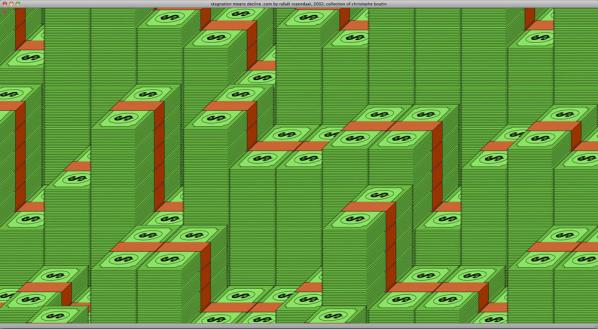
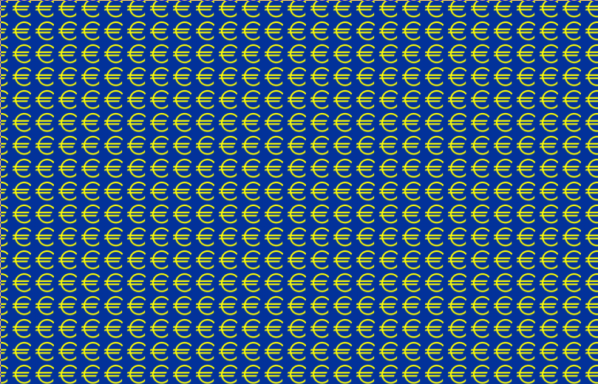
Dominik Podsiadly’s “Joy to ide” starts the pull-down menu with a flowing grid of Euro signs on a blue background to the sound of “Ode To Joy” playing backwards. It’s an all-over, closed temporal loop of the kind that animated GIFs exemplify and encourage, the Euro falling forever.
Nuria Güell’s “How to expropriate money from the banks” is a more direct action based work of culture jamming explaining presented in a well laid out document in the style of HSBC’s First Direct brand.
Paolo Cirio’s “Loophole for All” makes offshore tax havens, those loopholes in taxation regimes that allow corporations and the super-rich to avoid repaying society, available to everyone through a web site interface.
Rafaël Rozendaal’s “Stagnation Means Decline” is a screenful of geometric pixel-art dollar bill stacks that fill the screen with their edges only to be obscured by new columns like an economic game of Life.
Filipe Matos’s “Crash” is an undulating animated monochrome concrete poetry American flag with the stars made from the letters of “me” and the stripes as “you”.
Adam Ferriss’s “paper$hredder” is a Vimeo video clip of American dollar bills speeding by faster and faster until they dissolve into a blur.
Aaron Koblin + Takashi Kawashima’s “Ten Thousand Cents” is a composite image of a hundred dollar bill crowdsourced by paying people a cent to paint each piece through Amazon’s Mechanical Turk service.
Maximilian Roganov’s “When the Mao was small, he worked for CIA” is a looped animated GIF colour 3D scan of a dollar bill, polygonally glitched or possibly crumpled over time.
Dave Greber’s “Self Portrait With Dog” video is aptly titled, apparently taking place as the custom graphic on a Visa Mastercard.
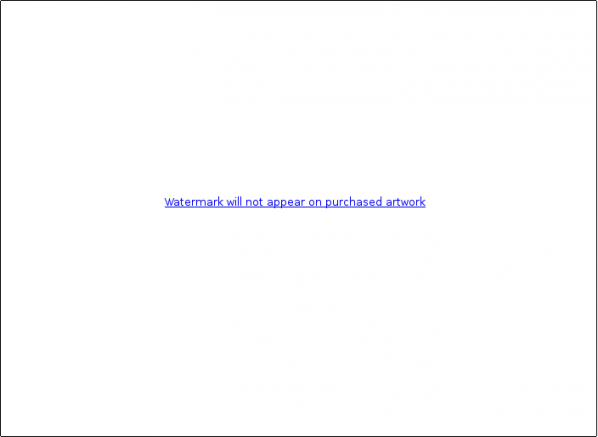
Agente Doble | UAFC’s “Watermark will not appear on purchased artwork” is a million dollar blank artwork if you email them and purchase it, otherwise it’s just a url on a blank web page.
JUST DO IT’s “Fifty Euros Inside/Fifty Euros Outside” are animated GIF loops of fifty Euro notes pulsating as if to sound waves on an oscilloscope.
Mitch Posada’s “$$$” is a Flash video of Silicon Graphics-era-style VR models of skeletons exploding and morphing into their constituent polygons while texture mapped with Deutschmarks.
Emilio Vavarella’s “Money Complex” is a tube map-style world map with banknote-collage continents and a key for numeric labels that can be zoomed in on by moving the mouse to reveal their often incongruous labels. It’s one of the more complex works in the show art historically and conceptually.
Lorna Mills & Yoshi Sodeoka’s “Money2” is a Vimeo video loop collage of roughly extracted elements from videos of commodity fetishism, fire and death.
Fabien Zocco’s “Cloud” is a generative composition of black dollar signs scattered up over a yellow background over time like a plume of smoke.
Jasper Elings’s “Territory” is an animated GIF loop of a dollar bill flag blowing in the roughly simulated wind on a white background. It’s not the only such piece in the show.
Robert B. Lisek’s “FuckinGooglExperiment” is online statistical analysis code that tries to correlate the change in Google’s stock price with changes in their PR strategy. It also uses the excellent Fluxus livecoding environment.
Alfredo Salazar Caro | TMVRTX’s “How to make money on internet remix” is a tightly tiled video loop of a rotating stack of dollar bills in a lava-lite-like flow of colour psychedelia.
Anthony Antonellis’s “How to make money on the internet” is simply that rendered block of spinning virtual hundred dollar bills, plucked from the era of RenderWare and VRML.
Gustavo Romano’s “Pieza Privada #1” is another piece of net art for sale at a specific price, with a carefully described contract and application form.
Tom Galle’s “One Million Dollars For iPhone” is an app available on the iTunes Store that allows you to count a virtual million dollar wad on your iPhone.
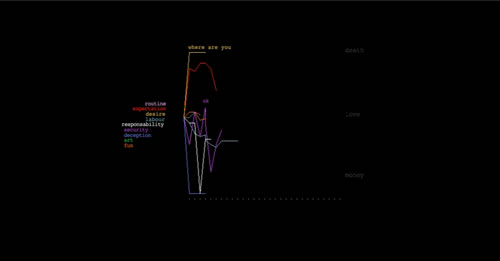
Geraldine Juarez’s “Love Not Money” tracks the associations of various words with “death”, “love” and “money”. I had to Google this one: it’s a Processing visualisation of a personal stock market tracking the artist’s conceptual assets over six weeks. I love it.
Nick Kegeyan’s “C.R.E.A.M. (Cash Romney Eat A Lot of Money)” is simple, direct and effective video burst of an American news interview subject morphing into a cloud of falling texture mapped dollar bills.
Dafna Ganani’s “Apple Dollar Explosion” is another descriptively titled piece, a Maya-looking apple texture mapped with a dollar bill spinning against a grey background then exploding into its constituent polygons.
Haydi Roket’s “$” takes a dollar bill portrait and literally deconstructs it by pixelating it in increasingly primitive ways, first as 4-bit grey patterns, then in monochrome ANSI characters, alternating to inverse video and changing the contrast to give a flickering effect.
Jennifer Chan’s “Infinite Debt” is a video of a twenty Euro not being dipped in batter and fried mixed in with a collage of clipart images and video on the cynical economics of contemporary art and consumerism.
Frère Reinert’s “Money as a waste of time” is a deliberate excercise in futility; a blurred, zoomed in silent video of the MacOS X SBOD on a white backdrop.
Cesar Escudero’s “Captura de pantalla 2013-03-08 a las 21.46.23” is a Mac OS X desktop image of a gas masked protester who appears to be reaching for a folder named “$$$$$$$”.
Jefta Hoekendijk’s “Money Is Data” is an animated GIF loop of a glitchily texture mapped virtual fifty Euro note in artificial colours.
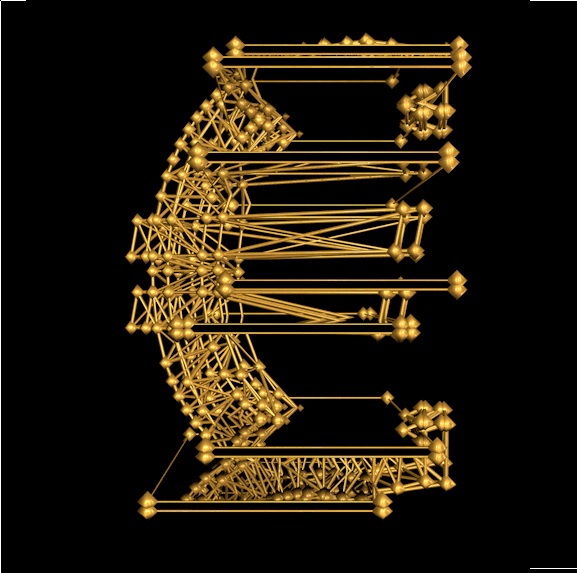
V5MT’s “¥€$ or N0T” is a rap video or Designers republic album cover-style animation of monumental metal morphing currency symbols made from struts and spheres like newton’s cradles or molecular diagrams.
Addie Wagenknecht’s “How To Make $$$$$” is a grid of money counterfeiting video tutorials, which are apparently a genre. Playing all at the same time they become an all-over aesthetic rather than incitement to a crime.
Gusti Fink’s “infinite loop of money drowning in water oil” is a slow, monumental simulation of a platinum visa card sliding into dark liquid that the camera pans over as if it were a sinking ship.
Marco Cadioli’s “You are here” shows globe and landscape maps constructed of dollar bills, with a pin or map icon to show your place in the economy.
Keigo Hara’s “Making Of Fake Bills” is more halftoned (or possibly shape grammared) dollar bills.
Jan Robert Leegte’s “Currency Graph” shows European flag yellow bars over a European flag blue gradient background. It’s a mutated and abstracted evocation of news information graphics aesthetics in CSS and JavaScript.
Ellectra Radikal’s “Disolved €uro” is a flickering autotraced, find edged and glitched animated zoom into a hundred Euro note that renders it spatial and architectural.
Paul Hertz’s “5,000,000$” it the purest glitch art piece in the show, rows of corrupted and miscoloured banknote imagery that looks like nothing so much as classic street art.
Aoto Oouchi’s “It’s all good” is an uncanny New Aesthetic 3d rendering of liquid or possibly mirrored texture mapped banknotes pouring from a wall.
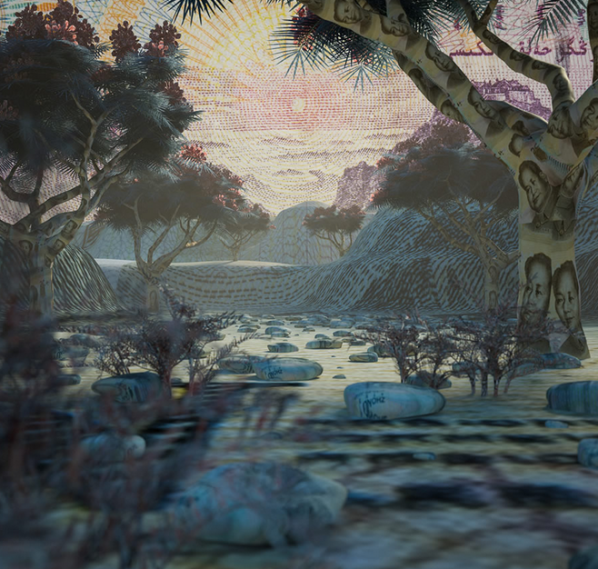
Kim Laughton’s “Landscape” is a rendered and collaged landscape of banknotes, resembling nineteenth century engravings of dramatic landscapes thanks to the inconography and texture of its source material.
Andrey Keske’s “Tell Me What You Want” is a search engine-style text box prompt that shows the economic coercion inherent in neoliberal use of technology by only allowing you to finish one word beginning with “M”.
A Bill Miller’s “3xpl0d3m0n3y” combines a grainy analogue glitch aesthetic explosion of a dollar bill into waveform stripes into a black space of drifting Matrix-green dollar signs.
Martin Kohout’s “Watching $100 Note Unveiling Video” has a ChatRoulette look, with the unseen unveiling causing a small smile to break out on the depicted viewer’s otherwise affectless face.
Marc Stumpel’s “pH0r 7|-|3 L0\/3 0Ph /\/\0|\|3’/” is a glitched and colourised monochrome television popular music performance from the age of mass media. Again I had to Google it but the song is ‘For the love of money’ by The O’Jays.
Benjamin Berg’s “$(0x24)” (the hexadecimal number that represents the dollar sign in ASCII) is a colourful and stripy glitch animation that resembles test cards, 8 and 16 bit graphics, and even woodcut as it breaks down.
LaTurbo Avedon’s “$$$$$$$$$$$$$$$$$$$$$” is an ambient modern html5 animtion of the avatar-artist reclining on money texture-mapped couches floating up and down a Google image search page for the word “millions”.
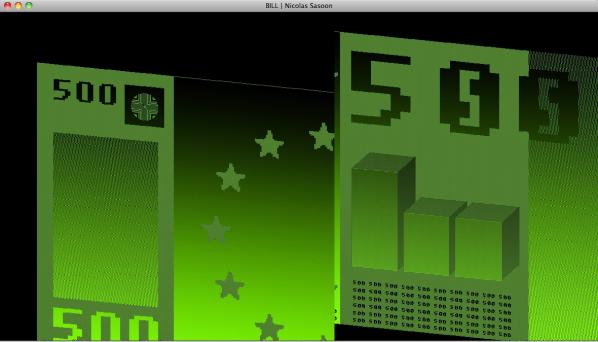
Nicolas Sassoon’s “BILL” is a flickering green screen terminal or slow scan TV-style rendering of a 500 Euro note that plays with the visual language of digital images: the letters and stars are highly pixellated but the backdrop to them is a smooth gradient.
Curt Cloninger’s “i want KANDY” loops images of a dancing sniper camouflaged figure montaged with dollar bills and fruit over a more slowly changing background collage of the american flag, a dollar bill, and fruit making a post MTV-styleguide image of the military-economic-entertainment complex.
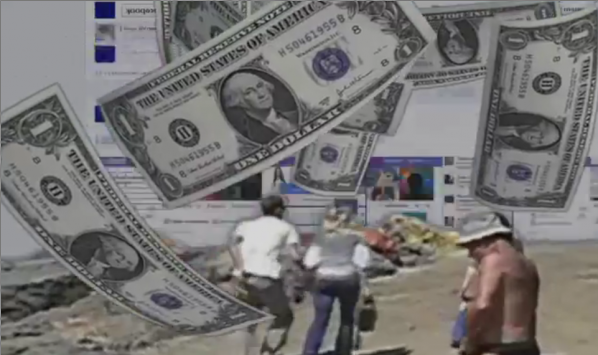
Systaime’s “ʞooqǝɔɐɟ Dollars” video portrays a world where curvily rendered dollar bills rain over an amateur video of tourists at a beach with a sky of quickly cycling Facebook pages.
Erica Lapadat-Janzen’s “Money Troubles” is a PhotoShop Pop Dada montage of exploitatively normative female beauty and monetary and drug excess that subverts the imagery of the fashion pages.
Milos Rajkovic’s “Mind Wheel” is a wonderfully Gilliamesque collaged animation depicting a mental wage labourer.
Émilie Brout & Maxime Marion’s “Cutting Grass” depicts the pointless and trivial labour that video games such as “The Legend Of Zelda force players to engage in for unrealistic rewards such as gold coins and rubies so they can get on with their quest.
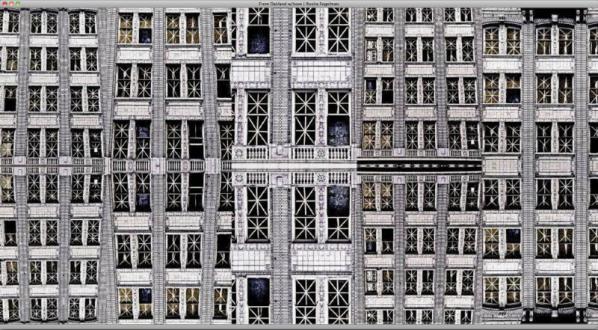
Rozita Fogelman’s “From Oakland w/Love” is a point-and-click kaleidoscopic archtitectural portrait of gentrified Bay Area architecture.
Georges Jacotey’s “am I enough political now” is a Chatroulettish video selfie of an augmented reality Euro flag and symbol drawing and dancing session.
Δεριζαματζορ Προμπλεμ Ιναυστραλια’s “Major Problem” is a rendering of a stack of dollar bills as seen through heat haze or under water, rippling and undulating against a white background.
Lars Hulst’s “0 €uro” is a rendering of a zero Euro note.
Nick Briz’s “a return to secularism” is a video documentary of twenty dollar bills being printed with the words “a return to secularism” flashing over it, framed by a repeated loop of the words “in God we trust” being crossed out on a dollar bill where they were added in the 1950s.
Jon Cates’s “MØN3¥-Δ$-3ɌɌɌØɌ” is a Classic Mac monochrome bitmap or fax aesthetic PDF essay for the show and an exposure of the print on demand economics of that essay in the same style.
León David Cobo’s “Conversation With Machine” has a 1990s broadcast graphic feel, showing the soundwaves of the feedback of a conversation with Siri asking it for money in Euro blue and yellow.
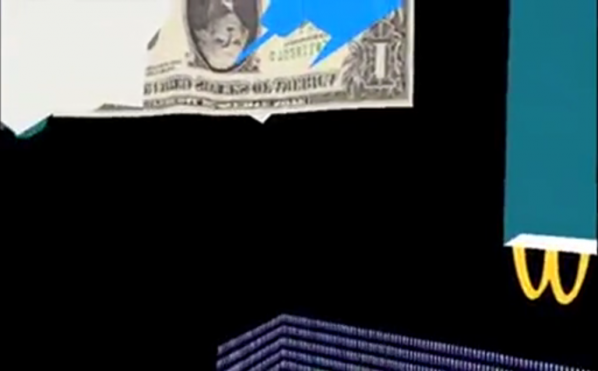
Guayayo Coco’s “Money | GLıɫcʜ ᴬᴺᴰ GLıɫɫɛʀ” is a video of a journey through a VRML-style virtual environment of discrete polygonal objects texture mapped with dollar bills, corporate logos and more abstract patterns with a radio channel-surfing soundtrack.
Vince Mckelvie’s “MONEY” is a reactive interactive deconstruction of a hundred dollar bill into a grid that reacts to the viewers’ mouse movement, revealing pulsating colours behind. It’s a good example of how suitable html5 is for this kind of thing.
Ciro Múseres’s “YOU HAVE WON” is a classic net.art style HTML bomb of overlaid text and links with content from financial web sites such as Barclays, Halifax and Santander that continuously adds and removes layers in different shades red, black, blue and green text to make new compositions.
Adam Braffman’s “Money Loading” is an animated GIF of the frame of a 100 dollar bill with a “Loading…” speech bubble in the centre. It makes the show’s themes of absent and delayed wealth more obviously explicit.
Rollin Leonard’s “Portrait of a NetArtist” is an two-frame animated GIF of the artist naked in the bath with bundles of fake hundred dollar bills with which they are lighting their cigar.
Thomas Cheneseau’s “100€ sequence” is a grid of glitched sections of a hundred Euro note that moires with colour as you scroll it. There’s a link to the facebook album that constitutes the actual work, and it works much better as a clickable album than as a static single image.
Yemima Fink’s “This is not money” is an abstract postmodernist collage of graphical quotations from the counterfeit-resisting elements of banknotes that is both witty and a very effective defamiliarisation of the iconography of banknotes and the power that they represent.
Mathieu St-Pierre’s “Untitiled” is a glitched jpeg of a dollar bill that in its straightforward application of glitch aesthetics makes the most direct link between them and the economic “glitch” of 2008.

Kamilia Kard’s “Amazon VIP girls” is the lone tumblr in the show, with an aesthetic that is either post-internet or pre-Google depending on how old you are applied to the supposedly perfect clothing models used by web sites.
José Irion Neto’s “Untitled” is a glitched banknote that turns JPEG artefacts into Klimt patterns.
There are definite historical trends and formal themes within the included work. Polygonal, texture-mapped, 90s-style VR-style objects that spin or explode. Net art and functional web sites that track or create financial and legal entities and transactions. Looped animations of textures, rendered flags, or video detournements. The imagery of accumulation, consumption, and destruction, always ironically. Imagery and symbols presented in simple loops fast or slow for contemplation. Graphs and maps of real and imagined economic signifiers.
In terms of genre, _MON3Y AS AN 3RRROR | MON3Y.US includes classic VR and video art, more modern GIF loops, textual and institutional net.art, glitch art, even some New Aesthetic. The language of computer graphics, texture mapping and polygons, allows the imagery of banknotes to be defamiliarised and deconstructed. Less often, personal experience and iconography displace the cultural imagery of wealth, consumption and debt.
This historical, formal and genre coverage of the variety of artworks included in the show comprehensively illustrates the chosen theme of “money and error”. This creates its own genre and lineage for the included artworks, which gain by comparison to their newly identified peers. They also contribute to the social and economic critique of the show. It’s a very successful balancing act, which the simple interface and presentational strategy of the show’s curation are key to achieving.
_MON3Y AS AN 3RRROR | MON3Y.US is an almost overwhelmingly successful in its comprehensive review of net art’s critical depiction of and engagement with money. By taking a technologically simple but historically, conceptually and logistically ambitious approach to net.curation for net.art it demonstrates the effectiveness and lasting value of net art’s contributions in this area and the power of online thematic curation to draw together and contextualise this value without giving in to the often perceived need for offline institutional underwriting.
Featured image: Sam Meech, Punchcard Economy, 2013. Photo courtesy of FACT.
The new exhibition “Time & Motion” at FACT in Liverpool, UK, takes the pulse of punchcard protocol and creative capital in our own “Modern Times”.
The exhibition Time & Motion: Redefining Working Life at FACT Liverpool is a collaboration between FACT and the Creative Exchange at the Royal College of Art – an initiative which looks at how arts and humanities researchers can work with industry to effect digital innovation. Rachel Falconer reviews the exhibition in the context of the paradoxical dynamics of cognitive capital and the changing landscape of the labour market.
Now self-employed,
Concerned (but powerless),
An empowered and informed member of society
(Pragmatism not idealism),
Will not cry in public,
Less chance of illness,
Tires that grip in the wet
(Shot of baby strapped in back seat),
A good memory,
Still cries at a good film,
Still kisses with saliva,
No longer empty and frantic like a cat tied to a stick,
That’s driven into frozen winter shit
(The ability to laugh at weakness),
Calm,
Fitter,
Healthier and more productive
A pig in a cage on antibiotics.
Fitter Happier, Radiohead.
The frantic quest for the elusive Shangri-La of work/life balance is a neurotic luxury afforded only to the always-on, hyper-connected generation of precariously unstable home office workers[1] in our hypercapitalist society. The working rhythms of this emergent class of “precariat” [2] are far removed from the forensically prescribed scientific management resulting from the time and motion studies associated with Taylorism at the beginning of the last century. This shift in working patterns generated by the digital revolution is the primary focus of the exhibition Time and Motion, Redefining Working Life currently at FACT, Liverpool. From an archival, filmic view of the automated, (Western) industrial factory labourer to contemporary portraits of the global information worker’s state of perpetual imbalance and non-stop, hyper-connectedness [3] the participating artists expose the – often contradictory – ecologies of labour, consumption, and the conditions in which they operate. The exhibition also marks the collaboration between FACT and Creative Exchange at the Royal College of Art – an initiative which looks at how arts and humanities researchers can work with industry to effect digital innovation and confront contemporary modes of production.
Taking the archival stimulus of time and motion measurement as its title and industrial work patterns as a starting point, the exhibition Time & Motion is the latest in a series of exhibitions and symposia addressing immaterial labour and new working patterns in the age of globalisation and creative capital.[4] Rather than following the well-trodden path of casting the figure of the artist as digital labourer, or attempting to portray an expansive, post-colonial view of nomadic, labouring diasporas, Time and Motion reflects a more subversive and fragmented approach to the politics of work, rest and play in the global information economy.
Sam Meech’s Punchcard Economy is at once a homage to the textile industry and a recognition of the contemporary precariat. With more than a symbolic nod to northern England’s textile heritage, Punchcard Economy consists of a machine-knitted reinterpretation of the Robert Owen’s 8-8-8 ideal work/life balance.[5] The piece was produced on a domestic knitting machine using a combination of digital imaging tools and traditional punchcard systems. During a residency at FACT last year, Meech collected punchcards from visitors detailing their working hours. This data was then translated into a knitting pattern which was used to generate the final work – a banner depicting the contemporary working day. Any hours worked outside the eight-hour day appear as a glitch within the fabric. This banner – historically a symbol of the working class and trade unions – also denotes the fragmentation and blurring of national class structures in the era of globalisation.
The move towards a flexible, open labour market has not eroded the class system completely, but a more fragmented global class struggle has emerged. The “working class”, “workers”, “proletariat” are terms that have been embedded in our (Western) culture for centuries, and used as badges of honour by some, and terms of derision by others. By incorporating a large cross-section of working society under one banner, Meech has literally – in stitching different socio-economic groups together into the very fabric of the working day – rendered the once potent archaic class signifiers as little more than evocative labels.[6]

“75 Watt” by artist Cohen Van Balen and choreographer Alexander Whitley also riffs on the trope of the long fought for 8 hour working day. Deriving its title from a quote from Marks’ Standard Handbook for Mechanical Engineers: “A labourer over the course of an 8-hour day can sustain an average output of about 75 watts”, the film is a subversive ballet of the complex and often skewed relationships between production, consumption and distribution in the post-industrial age. The film features a group of Chinese labourers working an assembly line, (playing on the stereotypical “Made in China” trope). The object they produce, however, has no logical use. The purpose of the exercise is simply to choreograph the combined movements performed by the labourers in the manufacturing process. The work examines the nature of mass-manufacturing on differnt levels; from the geo-political context of hyper-fragmented labour to the bio-political condition of the human body on the assembly line. Echoing the Taylorist ideal, here we see engineering logic taken to its conceptual extreme; through the scientific management of every single movement we witness the passage of factory labourer to a man-machine.
By shifting the purpose of the labourer’s actions from the efficient production of objects to the performance of choreographed acts, mechanical movement is reinterpreted into dance. The artists ask: “What is the value of this artefact that only exists to support the performance of its own creation? And as the product dictates the movement, does it become the subject, rendering the worker the object”?
This operatic construction line also points towards the ultimate failure of scientific management. Taylorism was always dictated by the needs of capitalist exploitation, but in its pure form it proved to be inefficient in drawing on workers’ talent and potential. In time the bourgeoisie recognised the inadequacies in Taylorism, and Taylorist methodology was mostly withdrawn by the 1930s. However, this was not the end of time and motion measurement. More recent management theories include Theory X and Theory Y introduced by Douglas McGregor in the 1960s.[7] Contemporary Taylorism takes the form of the Lean practices introduced into major departments of the British civil service (including HMRC, DWP, MOJ, and MOD). Workers incorporate “efficiency savings” as an integral part of their job, and work priorities are monitored by the soft panoptic gaze of non-hierarchical “collaborative practice”. Here,workers time their work processes, identify forms of waste, and propose changes in work practices. This “bottom-up” approach goes hand in hand with the new language of management – as managers morph into “leaders”. As efficiency savings are made from workers’ suggestions, the “leaders” try to enforce impossible targets, and decide whose post is next to be eliminated – hence the creation of the precariat. As part of the precariousness of employment, workers not only worry about losing their jobs, but also have to propose measures which, in the name of efficiency, might put them out of work. Added to this the increasing automation of work and the burgeoning AI scene, where does human cognition stand in all of this?
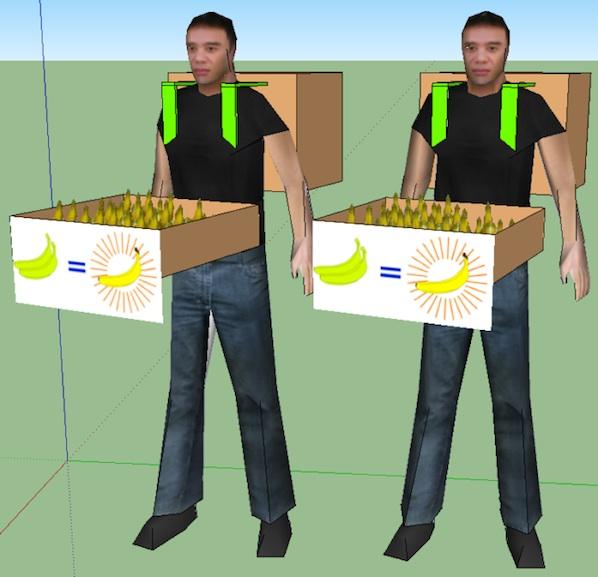

Inari Wishiki’s set of ludicrious alternative employment models (such as Banana Multiplier), are in reminiscent of the subversive, performative models of the Fluxus movement. Inari’s online work Recruit Agency for People Who Don’t Want To Work dramatizes this staging of an alternative labour market. The website includes documentation of a series of performances by the artist exploring the premise that with the proliferation and development of technology, we as humans have lost our place in the world of work, and yet still need to appear to be “useful” in order to earn a living.
Recruit Agency For People Who Don’t Want To Work is a set of systems which allow people to engage in the act of commerce while abandoning “all the meaningless rituals of having to be useful in order to earn money”. In INARI TRADING CARD, the artist documents the way in which “essential” workers function as a social infrastructure. He observes that “money was naturally following those workers according to their essential motions, unlike that of workers who seek after money”. These set of performances are an ironic counterpoint to the hyper-efficiency promoted by neo-Taylorism, and point towards the informal norms that are in tension with the industrial time norms still permeating social analysis, legislation and policymaking in the globalization era.
In his text “The Value of Time Spent” in the accompanying catalogue to the exhibition, Mike Stubbs supports this strategy of “design for disassembly” and novel values of exchange. Stubbs maintains that these alternative ecologies of exchange are necessary in order to allow us to question how we spend our time, and for us to lay bare the new patterns of professional fulfilment and social relations inherent to our hyper-mediated society.
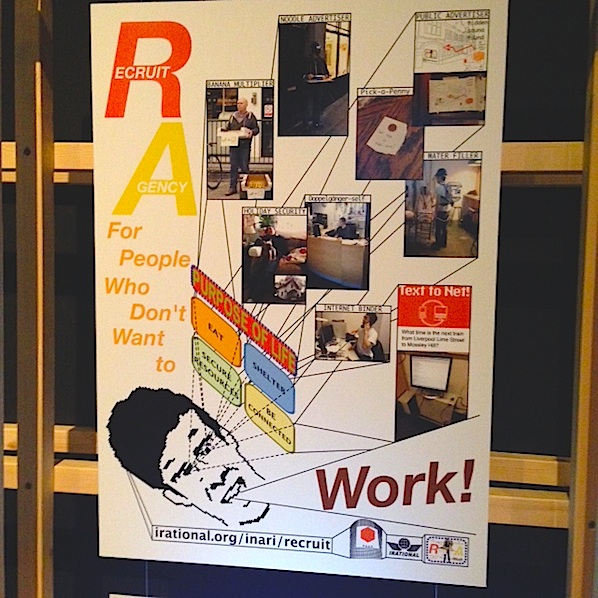
The classic distinction between the workplace and the home was forged in the industrial age, and when today’s labour market regulations, labour law and social security systems were constructed, the norm was a fixed workplace. This model has now fragmented and crumbled and the term social factory, popularized by Tiziana Terranova and others, is applied to describe this shift “from a society where production takes place predominantly in the closed site of the factory to one where it is the whole of society that it is turned into a factory – a productive site”.[8] The production is one of value, where the collective efforts of intelligence and creativity are networked, controlled and exploited. Labour takes place everywhere, and the discipline or control over labour is universally exercised. But policies are still based on a presumption that it makes sense to draw sharp distinctions between the workplace and home – and between workplace and public space. In a tertiary market society, this model is obsolete, leaving the information worker increasingly pressurized and isolated.

One of the recurring themes in Time & Motion is this hybrid and compromised locus and infrastructure of the work place. Harun Faroki’s moving image work A New Product presents an insider’s view of the paradoxical construction of so called “fluid” working environments. He describes his new film as: “Scenes from meetings within a company which advises corporations how to design their offices — and the work done there. The film shows that words are not just tools, they have become an object of speculation.” In this work, he stages the brainstorming sessions of a business consultancy specialising in the design of workspaces, offices and new concepts for mobile work hubs. The resulting seductive imagery of the ideal workspace is an exercise in brand development pastiche rendered as pseudo video game.
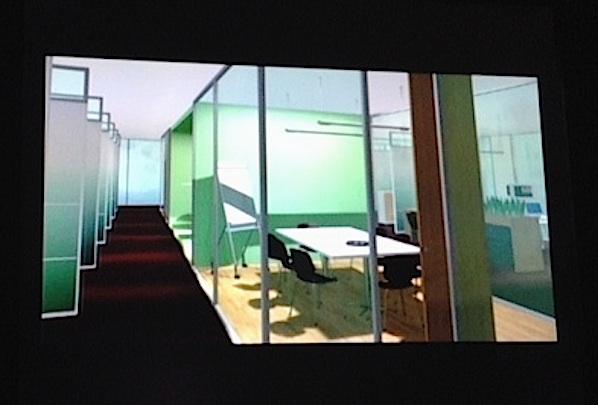
Time & Motion also stages a co-working space, developed by the RCA CX team, which weaves together venue, audience, workspace and digital space – presenting the entrance space of the gallery space into a live research ‘lab’. Visitors are encouraged to participate in the research, interaction and interventions, and workshops, salon discussions, and hacking and making sessions are woven into the experimental fabric of the exhibition.
The ‘CX Co-Working Space’ features three design interventions. The first, Hybrid Lives, features video work by Karen Ingham and an interactive installation responding to data traffic, dressed with ‘co-working furniture’. Where Do You Go To? is a wall-mounted moving freize showing the output from an app, co-designed with a group from the BBC, with the mission to connect remote workers through exchanging, Snap-chat-like (pre-hack) images of desks and workspaces. According to Ben Dalton, one of the main developers, this sharing of ‘desk context’ helps form a synergy of ‘headspace’ between remote workers.

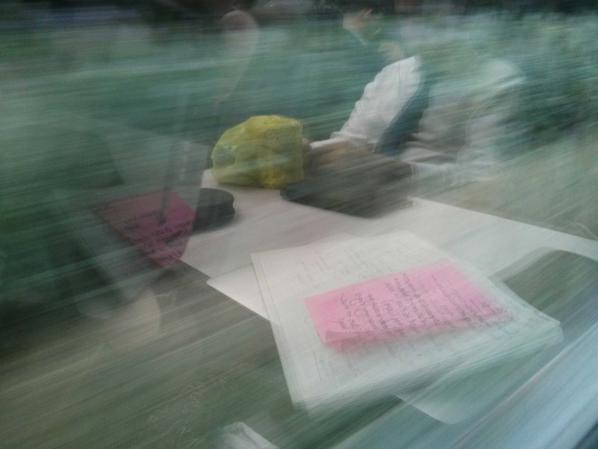
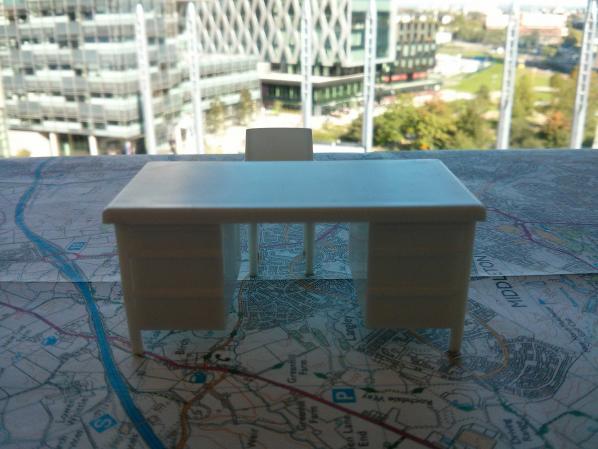
Taking its cue from Frances Cairncross’s 1995 “The Death of Distance”, where the compelling vision that, over time, the communications revolution would release us from geographic locations, the project illustrates how digital space has redefined our working lives. However, for all its good intentions, this gesture towards remote solidarity seems to be muddying the new principles and rhythms of work with Taylorist and later Fordist ideals of panoptic surveillance and somehow stands in direct opposition to the emancipatory rhetoric of convergence culture.
Time and Motion focuses primarily on a particular demographic of labourer (generally the global information worker), and paints the picture of a tertiary lifestyle which involves multitasking without control over a narrative of time use, and habitual fractured thinking – where non-stop interactivity (a digital version of Taylorist motion) is crack cocaine for the drones. For this category of workers, the workplace is everyplace – diffuse, unfamiliar, a zone of insecurity. We are left with a “thin democracy” in which people are disengaged from political activity except when jolted into consciousness by a shocking event or celebrity meltdown witnessed virally on Youtube during office hours. As more work and labour takes place outside the pre-determined workplace – in the hybrid environments of cafes, trains and across the domestic landscape – the very idea of a work/life balance seems like an alien ideal to aspire to.In an open tertiary society, the industrial model of time, and the bureaucratic time management of factories and office blocks, breaks down. There is no stable time structure and we are increasingly losing our grip on our own time. Time and Motion at FACT interrogates the impact of this fragmentation on the aesthetic forms of contemporary art, and contemplates how artists might offer a critique of our neo-Taylorist predicament.
Read and learn how to solve a Rubiks Cube with the layer-by-layer method. It can be learned in an hour.
Featured image: Screenshot of Apodemy by Katerina Athanasopoulou
Eva Kekou interviews Katerina Athanasopoulou about her film Apodemy commissioned by The Onassis Cultural Center on the theme of Emigration for Visual Dialogues 2012, and her hybrid art practice of live action, animation and film. In 2013 Athanasoppulou won the Lumen Prize, described by the Guardian as “The World’s Pre-eminent Digital Art Prize”. She works as an Animation Director, collaborates with other artists and companies, and is an Animation Lecturer at the London College of Communication.
What is your background and what brought you to London?
I studied Painting at the School of Fine Arts of Aristotle University in Thessaloniki. My work involved large canvases painted in a serendipitous way, building layers, erasing and restarting, seeing where my lines were going to take me. I was frustrated by the stillness of the final piece, longing to recreate the gesture in time that had created it. At the same time, I was passionate for cinema and animation so I tried it out in my own computer at home. In a way, I discovered animation for myself, as there was no film nor digital element in my course. That meant that there was no right and wrong way to go and it was such a joy to be producing moving images, to be able to finally paint in time! My first films were digital cutouts and manipulated live action. The big change came when I arrived in London in 2000 to do an Animation MA at the RCA, where suddenly completely new creative possibilities appeared. Short film festivals were also a source of great inspiration, places to meet like-minded filmmakers and watch films all day long.
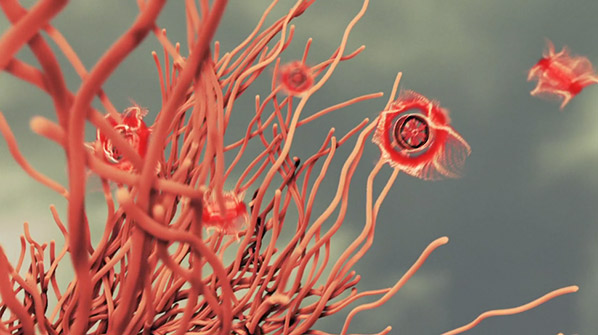
What’s the effect of English education in your work and in the way you appreciate art?
When I became a student in the UK, I was at the same time delighted and terrified by the informality of the teacher-student relationship, like addressing your tutor by their first name. I was really impressed by the enthusiasm for research and for the creative journey itself. Process becomes a major part of the work and that frees you from concentrating only on the outcome. I saw how Animation can be enlisted in very different ways, from a more commercial manner to very left-field experimental practices so that was an exciting new point of view for me. At the same time, the early 2000s were a time of conflict between analogue and digital practices – which of course has not quite gone. As an educator myself, I love the intensity of the way that students debate their work, so the English system of education still very much inspires me.
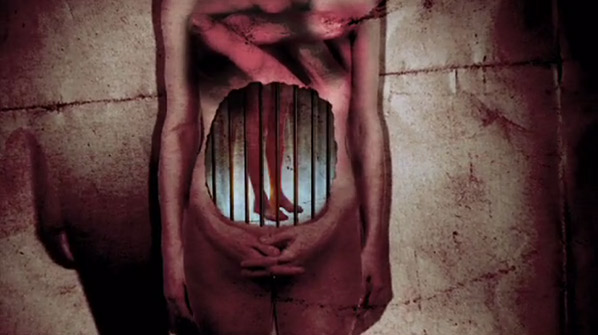
What was your creative practice up to the Lumen Prize.
Since 2002 I have been making short experimental films that have been screened in film festivals and galleries, my process being one of playfulness and embracing chance. I like to try out different ways of creating moving images, and I try to make each film follow a different road, even though it’s very tempting – and at times fruitful – to revisit old concepts. In the last three years I have developed a big interest in Architecture and how that can be depicted in time, through 3D, 2D and live action. Animation for me is Alchemy, I combine elements together, in textured space and time and see what happens. These experiments some times involve diving into live action that I have captured on location, and other times are about creating that space digitally.
Animation Installation is a field I’m fascinated by at the moment, devising ways of materialising the digital element, of making it even more about light and shadow. My latest film, Triptych 1, was made especially for the facade of the Museum of Contemporary Art in Zagreb and reimagines it as built of interconnecting corridors.
Talk to us about the theoretical and philosophical background of Apodemy.
Apodemy was commissioned by the Onassis Foundation (Stegi) on the theme of Emigration and the Economic Crisis. It was to be part of an Art Show in an old archaeological park in Athens, called Plato’s Academy Park, where the philosopher is believed to have taught. The title of the Installation was Visual Dialogues so I was drawn to Plato’s Dialogues where I discovered the metaphor of the human soul as a birdcage. I was very keen to instil in the work philosophical elements related to the space itself. With migratory birds being one of my initial ideas about the piece, the solution of a travelling birdcage in an abandoned half-finished city became apparent. The marble arms were part of Plato’s birdcage metaphor, where he describes how, as we grow up we fill our mind/birdcage with ideas/birds. When we need to recall something, we put our hand in the cage and grab a bird. I imagined those hands to be aggressive, so they became statue fragments carried by cranes that eventually mar the trolley cage’s journey. Theo Aggelopoulos inspired me with his images of a Lenin statue traversing the river and of a single arm, floating accusingly yet innocently. In times of political upheaval we like to break down our past heroes, in an attempt to cleanse ourselves of mistakes. Only that sometimes those past leaders still come back to haunt us.
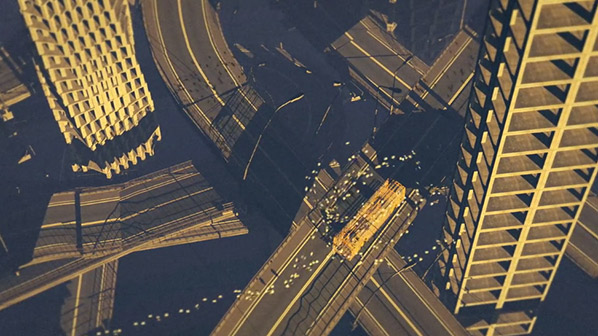
What techniques did you use?
I designed the city on the computer in 3D and then started to drive cameras inside it, discovering it on the road, like I was exploring a real landscape. The film was built like a documentary, following the migration journey of a cage that is also a trolleybus, the yellow kind that I was riding in Athens when – in the late nineties – everything was promising.The construction industry ground to a halt when the crisis took hold so, today, many buildings remain unfinished and look like birdcages themselves. After the City was built, I started making the birds and the bus. Then I moved it inside the city, following a broken road which eventually leads to the fall. The entire film developed through trial and error, it was my first 3D film and I had limited time and resources. But restriction breeds creativity and, in the two months that I had to complete it, I tried to make a film designed in a minimal but impactful way.
What does the Lumen Prize mean to you and how can such a recognition make a difference in your work and life?
Winning the Lumen Prize was a great honour, especially amongst so many great works from entirely different platforms. The prize revolves around fine digital art and encompasses film, installations, interactive work, print, sculpture, collage. Amongst such a plethora of forms, it meant a lot that Apodemy was awarded, both in terms of my digital animation practice, but also as it’s a film that’s about the collapse of my country of origin. The Lumen Prize show has already been to New York and will also be part of the Digital Symposium at Chelsea College of Art and Design in March, as well as in Hong Kong in June. It’s wonderful that Lumen is propelling the film further forwards, and it’s been great to meet some of the other artists involved. Seeing the works by Nicolas Feldmyer, Kalos&Klio, Margarita Koulikourdi, Vasileios Chlorokostas and others has been very inspiring.
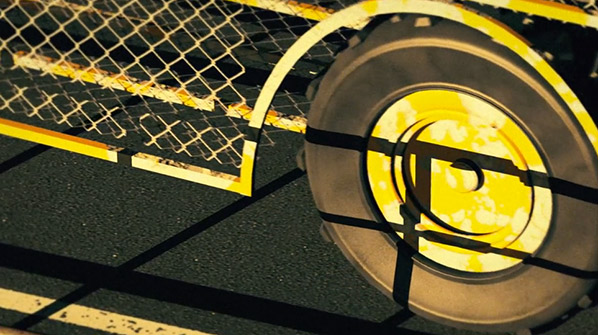
What draws you to animation?
Through cinema, we immerse ourselves in different waters, achieving a kind of immortality. One could argue that also happens whilst reading, or listening to music – yet somehow film combines literature and poetry and music too and almost all the senses get involved. What’s more interesting for me is the connection between moving image and the imagined: it’s almost like we dream other people’s visions and we physically try to make that disconnection from reality by favouring watching films in dark rooms. The cinema I’m interested in is one of spectacle, that transforms reality into a surreal play, that explores light and shadow and looks for monsters under the bed. At the same time, I’m currently very curious about taking animation off the screen and applying it in space, by projecting rooms, objects, corners. For me, there’s no greater magic than instilling life in the inanimate and create moving worlds that don’t depend on cameras and actors – what’s in your head can be made real, a real that’s still beautifully elusive and chimeric, that doesn’t contain all the answers but asks exciting questions.
What are your future plans?
I have been working on an experimental narrative of an obsessive mother that cocoons her children, which may work as a single screen work or perhaps as an installation that includes a film. I’m also researching the Architecture of Melancholy, which lies somewhere between cabinets of curiosities and abandoned homes. I always have several experiments on the go, it’s really about finding the right time and opportunity to commit to a project. As delightful as animation is, it takes time to complete, but it also means that ideas may have time to mature and not be rushed. As long as my ideas keep me entangled, I’m happy.
See Katerina Athanasopoulou’s work online at kineticat.co.uk
Marc Garrett reviews Stefan Szczelkun’s book Agit Disco. He is an artist and author interested in culture and democracy. In the early Seventies he was fortunate to be part of the Scratch Orchestra and has since been involved with a series of artists collectives. His doctoral research into the Exploding Cinema collective was completed at the RCA in 2002. Recently his collaborative project Agit Disco was published as a Mute book in 2012. He has been on the Mute magazine editorial board since 2009, and currently working on photographic and performance projects.
“Just cause we can’t see the bars
Don’t mean we ain’t in prison.”
Kate Tempest (2009) [1]
The subtle and not so subtle domination by market interests of cultural production and dialogue denies us all access to a wide spectrum of creative expression, especially those that engage in subjects that conflict with the agendas of those in power. Agit Disco by Stefan Szczelkun combats this contemporary trend by focusing on music, politics, DIY culture, and freedom of expression. In doing so he starts to redress the lack of representation across the board for those in grass roots culture and working class lives, whose freedoms to have a voice in society are so commonly restricted.
The future does not look good for those who value cultural and social diversity; who look for a variety of activist histories and experiences to be seen and represented on their own terms. The UK government is changing university regulations so that private companies can become universities. This means tutors will end up replacing educational courses once devised with the public good in mind with modules designed for maximum profit. Luke Martell, a critic of the marketisation and privatisation of education and lecturer of Sociology at the University of Sussex, says “This will lead to a different content to education. Critical thinking is being replaced by conformity to cash. Money-spinning management and business courses are expanding and lower-income adult education is being closed down.” [2] (Martell 2013) Already, most researchers, academics and those in professional fields of practice mainly work within insider frameworks, “there is a qualitative difference between the conditions of people living in marginalized communities and those in middle-class suburbia.” [3] (Smith 2012)
The knock on effect of an unquestioning culture of compliance with the ‘free market’ is enormous. How ironic it is that the term ‘free market’ is attributed with so much value and (a presumed) logic when in actuality it constrains people’s freedoms and makes those who are already rich even richer. Because the politicians are not effected by the results personally, and because it also serves their interests, they have handed over their social responsibilities to these market systems. The neoliberal defaults that caused the financial crisis are untouched by our democratic processes. These out of reach, distant power systems are fixed towards property bias and occupy and govern our everyday experiences. How does freedom of expression fit into this and on whose terms?
“The more our physical and online experiences and spaces are occupied by the state and corporations rather than people’s own rooted needs, the more we become tied up in situations that reflect officially prescribed contexts, and not our own.”[4] (Garrett 2013)
Agit Disco offers a breath of fresh air, in the fug of the developing marketisation of everything. It presents grounded examples of difference that contrast with the dominating view of entertainment systems. Published through Mute Books in 2012, it features 23 playlists put forward by 23 different writers, artist and activists. It began as a set of mixed CDs and images, each chapter includes annotations and illustrations. Its contributors are Sian Addicott, Louise Carolin, Peter Conlin, Mel Croucher, Martin Dixon, John Eden, Sarah Falloon, Simon Ford, Peter Haining, Stewart Home, Tom Jennings, DJ Krautpleaser, Roger McKinley, Micheline Mason, Tracey Moberly, Luca Paci, Room 13 – Lochyside Scotland, Howard Slater, Johnny Spencer, Stefan Szczelkun, Andy T, Neil Transpontine, and Tom Vague.
Mostly from working class backgrounds the contributors were invited to focus on politics and music, and share memories relating to what the tunes meant to them at the time. In the preface Szczelkun states, his selection of contributors comes from his own worldview and personal contacts. Anthony Iles, in his introduction says most who have contributed “are closely associated with anti-authoritarian politics and DIY culture.”[5] (Iles 2012) Contributors offer insights into the connections between their music and the politics of the time. Louise Carolin says, “When I was a teenager in the ‘80s I lived through one of the golden ages of British chart pop, listening to music that was by turns, political, danceable, challenging and entertaining. I attended CND rallies, marched against South African Apartheid, ran the feminist group at school and went to GLC-funded music festivals.”[6] (Carolin 2011)
What adds depth to Louise’s story, as with the rest of the contributions is that many readers feel connected with these histories, and I am one of them. It highlights an indigenous, working class culture and their personal struggles in a period when neoliberalism was in its early stages of world domination. To say that these are merely anecdotal or subjective would completely miss the point. It calls for an awareness and understanding about people giving an account for themselves in relation to music, politics and their social contexts on their own terms.
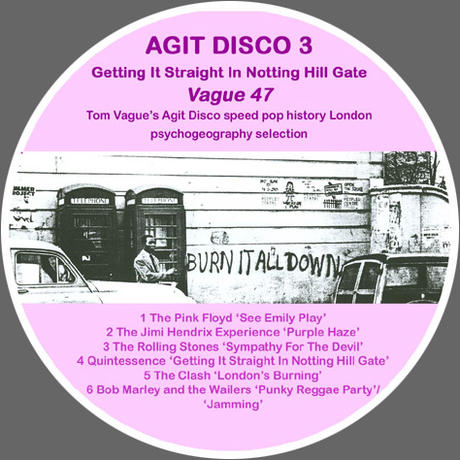
Just as it is important to ask contextual and critical questions of why a particular artwork is being shown at a certain venue or seen in an art magazine. It is also necessary to observe who published Agit Disco and why? It is no coincidence that it’s a Mute publication, Szczelkun has been on its editorial board since 2009, and has written various articles, reviews and interviews for Mute.
Agit Disco resonates with Mute’s dedication to DIY culture. Indeed, Mute has an excellent history in independent publishing alongside its DIY methods of production. Mute’s earliest incarnation used Financial Times’ pink paper, broadsheet printing cast offs. Later on a traditional magazine format. From 2005 onwards it moved onto its online site, and developed a publishing platform that allowed the publication of its POD (Print On Demand) magazine. [7] The design and production of Mute and its platforms have come a long way enabling a pamphlet-like production and distribution, echoing Thomas Paine’s own DIY releases of the Rights of Man.[8]
DIY Culture (and its distribution channels) offer a vital alternative to mainstream frameworks and their dominating hegemonies as a way to route around the restrictions to content, freedom of thought and free exchange. We have to contend with networked surveillance strategies initiated by corporations and state secret services. Censorship exists in many forms and recently there has been a rise of self censorship by workers and academics worried about losing their jobs if bosses see their interactions on Facebook or similar Web 2.0 social networks.[9] And the worrying antics of Britain’s GCHQ, in collaboration with America’s National Security Agency (NSA), targeting organisations such as the United Nations development programme, the UN’s children’s charity Unicef [10] reveal a greater investment in the surveillance of everyone, and the downgrading of privacy and fundamental human rights.
The credo that Anyone Can Do It reached a mass of individuals and groups not content with their assigned cultural roles as disaffected consumers watching the world go by. Like the Situationists, Punk was not merely reflecting or reinterpreting the world it was also about transforming it at an everyday level. Sadie Plant states that with the “emergence of punk in the late 70s […] lay the possibility of a threatening political response to the vacant superficiality of contemporary society.” [11] From this, a whole generation of diverse artists emerged; and through their practices they critiqued the very society they lived in, questioning authority and the authenticity of established politics, language, art, history, music and film.
Has the process of appropriating people’s civilian personas, and then replacing their social contexts with a corporate role as consumer created a more selfish world, lacking compassion for others and less interest for societal and ethical change? Ubermorgan discussed in a recent interview with Stevphen Shukaitis that people are in a state of ‘mediality’. “What we refer to as reality very often is just mediality, and also because that’s how human nature often prefers to observe reality, you know, via some media.” [12] Perhaps our constant interactions through different interfaces of proprietorial frameworks distances ourselves to what is important. In the 21st Century demonstrations and civil disobedience are policed intensively, and even though much of contemporary activism exists on-line. The frontline, or the heart of politics is still mainly a physical matter; it is still in our streets, our homes, our bodies, in our neighbourhoods and communities.
As Oxblood Ruffin a Canadian hacker and member of the hacker group Cult of the Dead Cow (cDc) and the founder/director of Hacktivismo, said “I know from personal experience that there is a big difference between street and on-line protest. I have been chased down the street by a baton-wielding police officer on horseback. Believe me, it takes a lot less courage to sit in front of the computer.” [13]
So Agit Disco reminds us that music is a vital way of both bringing people together in a space, story telling and communicating with each other, sharing what is happening with people’s lives. It is usually at the moment of censorship that we then realise how essential this freedom of expression stuff really is. For instance, nine months after Islamic militants had taken over in northern Mali they announced that all music is banned. “It’s hard to imagine, in a country that produced such internationally renowned music as Ali Farka Touré’s blues, Rokia Traoré’s soulful vocals and the Afro-pop traditions of Salif Keita. […] The armed militants sent death threats to local musicians; many were forced into exile. Live music venues were shut down, and militants set fire to guitars and drum kits. The world famous Festival in the Desert was moved to Burkina Faso, and then postponed because of the security risk.” [14] (Fernandes 2013)
In her article The Mixtape of the Revolution, Fernandes says that in Africa many rappers are “speaking boldly and openly about a political reality that was not being otherwise acknowledged, rappers hit a nerve, and their music served as a call to arms for the budding protest movements.”[15] Regarding Egypt, the rapper Mohamed el Deeb in an interview with Fernandes said, “shallow pop music and love songs got heavy airplay on the radio, but when the revolution broke out, people woke up and refused to accept shallow music with no substance.” [16] Music, politics and grass roots dissent are concrete expressions and an essential part of our collective freedoms. Alongside this, independent publishing as an alternative voice to the marketed franchises that dominate our gaze, sight, ears and minds, are needed more than ever. Yet, independent voices are being silenced and whittled down by wars, oppression and the neoliberal created financial crisis and its resulting austerity cuts.
What is to become of us if we lose our skills of discernment and slump into a homogenous consumer class, to define ourselves solely through marketed stereotypes and ideologies?
Agit Disco offers a festival of dance and dialogue for independent minded individuals and groups around the upturned burning car in the barricade against the coming zombie apocalypse.
It has been fun listening to all of the playlist contributions provided in Agit Disco. Below is my own Agit Disco playlist. You are welcome to add your own playlist in the comments section below (with links)…
Damien Dempsey – ‘Dublin Town’ (2000)
http://www.youtube.com/watch?v=brhO8pqTNHU
Asian Dub Foundation – ‘Modern Apprentice’ (2000)
http://www.youtube.com/watch?v=zgtWhjaOgQ4
Dan Le Sac & Scroobius Pip – ‘Great Britain’ (2010)
http://www.youtube.com/watch?v=YeV2cExvnMI
Kirsty MacColl – ‘Fifteen Minutes’ (2005)
http://www.youtube.com/watch?v=MSQrH3JUQ2s
Jeffrey Lewis – ‘Do They Owe Us A Living?’ (2007)
http://www.youtube.com/watch?v=jWU-W0SzVE0
The Pop Group – ‘Forces of oppression’ (1979)
http://www.youtube.com/watch?v=Txzmbu6o-gg
Kieron Means – ‘I Worry For This World’ (2005)
https://play.spotify.com/track/6AI2QujkrP6B2nfIUK55lY
Robyn Archer – ‘Ballad on Approving of the World’ (1984)
https://play.spotify.com/album/3hNQY8q9sO3M0R6es2d3ka
Robyn Hitchcock – ‘Point it at Gran’ (1986)
http://www.youtube.com/watch?v=_HFkimK9FAU
Sound of Rum – ‘End Times’ (2011)
http://www.youtube.com/watch?v=9dWPe7Au68A
Silver bullet – ’20 Seconds to comply (final conflict)’ (1990)
http://www.youtube.com/watch?v=24b6pYGT9MM
Maze – ‘Color Blind (Featuring Frankie Beverly)’ (1977)
http://www.youtube.com/watch?v=COY4gKLwV2I
Akala – ‘Bullshit’ (2006)
http://www.youtube.com/watch?v=mxpxpQ7j8Sg
Sarah Jones – ‘Your Revolution’ DJ Vadim (2000)
http://www.youtube.com/watch?v=E62SZ1CmBOI
Julian Cope – ‘Soldier Blue’ (1991)
http://www.youtube.com/watch?v=8dGOr-JpOmI
June Tabor – ‘A place called England’ (2009)
https://play.spotify.com/track/3YB6sSlLfB8kmMrrm5COKX
For over 17 years, Furtherfield has been working in practices that bridge arts, technology, and social change. Over these years, we have been involved in many great projects and collaborated with and supported various talented people. Our artistic endeavours include net art, media art, hacking, art activism, hacktivism and co-curating. We have always believed it is essential that the individuals at the heart of Furtherfield practice in arts and technology and are engaged in critical enquiry. For us, art is not just about running a gallery or critiquing art for art’s sake. The meaning of art is in perpetual flux, and we examine its changing relationship with the human condition. Furtherfield’s role and direction as an arts collective is shaped by the affinities we identify among diverse independent thinkers, individuals and groups who have questions to ask in their work about the culture.
Here I present a selection of Furtherfield projects and exhibitions featured in the public gallery space we have run in Finsbury Park in North London for the last two years. I set out some landmarks on the journey we have experienced with others and end my presentation with news of another recently opened space (also in the park) called the Furtherfield Commons.
Running themes in this presentation include how Furtherfield has lived through and actively challenged the disruptions of neoliberalism. The original title for this presentation was ‘Artistic Survival in the 21st Century in the Age of Neoliberalism’. The intention was to stress the importance of active and open discussion about the contemporary context with others. The spectre of neoliberalism has paralleled Furtherfield’s existence, affecting the social conditions, ideas and intentions that shape the context of our work: collaborators, community and audience. Its effects act directly upon ourselves as individuals and around us: economically, culturally, politically, locally, nationally and globally. Neoliberalism’s panoptic encroachment on everyday life has informed Furtherfield’s motives and strategies.
In contrast with most galleries and institutions that engage with art, we have stayed alert to its influence as part of a shared dialogue. The patriarch, neoliberalism, de-regulated market systems, corporate corruption and bad government; each implement the circumstances where we, everyday people, are only useful as material to be colonized. This makes us all indigenous peoples struggle under the might of the wealthy few. Hacking around and through this impasse is essential if we maintain human integrity and control over our social contexts and ultimately survive as a species.
“The insights of American anarchist ecologist Murray Bookchin into environmental crisis hinge on a social conception of ecology that problematises the role of domination in culture. His ideas become increasingly relevant to those working with digital technologies in the post-industrial information age, as big business develops new tools and techniques to exploit our sociality across high-speed networks (digital and physical). According to Bookchin, our fragile ecological state is bound up with a social pathology. Hierarchical systems and class relationships so thoroughly permeate contemporary human society that the idea of dominating the environment (to extract natural resources or to minimise disruption to our daily schedules of work and leisure) seems perfectly natural despite the catastrophic consequences for future life on earth (Bookchin 1991). Strategies for economic, technical and social innovation that focus on establishing ever more efficient and productive systems of control and growth, deployed by fewer, more centralised agents, have been shown to be both unjust and environmentally unsustainable (Jackson 2009). Humanity needs new social and material renewal strategies to develop more diverse and lively ecologies of ideas, occupations and values.” [1] (Catlow 2012)
It is no longer critical, innovative, experimental, avant-garde, visionary, evolutionary, or imaginative to ignore these large issues of the day. Suppose we, as an arts organization, shy away from what other people are experiencing in their daily lives and do not examine, represent and respect their stories. In that case, we rightly should be considered part of an irrelevant elite and seen as saying nothing to most people. Thankfully, many artists and thinkers take on these human themes in their work in various ways, on the Internet and in physical spaces. So much so, this has introduced a dilemma for the mainstream art world regarding its relevance and whether it is contemporary.
Furtherfield has experienced, in recent years, a large-scale shift of direction in art across the board. And this shift has been ignored (until recently) by mainstream art culture within its official frameworks. However, we need not only to thank the artists, critical thinkers, hackers and independent groups like ours for making these cultural changes, although all have played a big role. It is also due to an audience hungry for art that reflects and incorporates their social contexts, questions, dialogues, thoughts and experiences. This presentation provides evidence of this change in art culture, and its insights flow from the fact that we have been part of its materialization. This is grounded knowledge based on real experience. Whether it is a singular movement or multifarious is not necessarily important. But, what is important is that these artistic and cultural shifts are bigger than mainstream art culture’s controlling power systems. This is only the beginning, and it will not go away. It is an extraordinary swing of consciousness in art practice forging other ways of seeing, being, thinking, making and becoming.
Furtherfield is proud to have stuck with this experimental and visionary culture of diversity and multiplicity. We have learned much by tuning into this wild, independent and continuously transformative world. On top of this, new tendencies are coming to the fore, such as re-evaluations and ideas examining a critical subjectivity that echo what Donna Haraway proposed as ‘Situated Knowledge’ and what the Vienna-based art’s collective Monochrom call ‘Context Hacking’. Like the DADA and the Situationist artists did in their time, many artists today are re-examining current states of agency beyond the usually well-promoted, proprietorial art brands, controlling hegemonies and dominating mainstream art systems.
Most Art Says Nothing To Most People.
“The more our physical and online experiences and spaces are occupied by the state and corporations rather than people’s own rooted needs, the more we become tied up in situations that reflect officially prescribed contexts, and not our own.” [2]
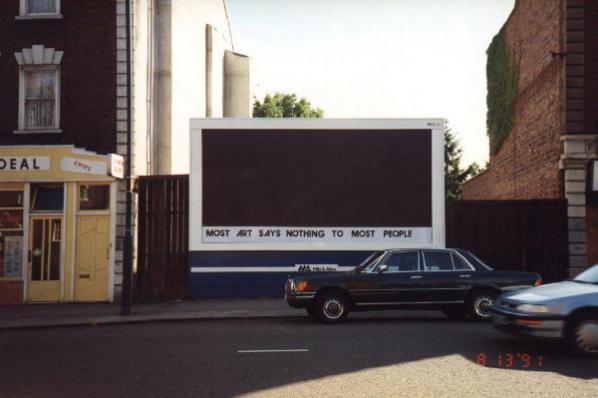
To start things off, I want to refer to a past work that Heath Bunting (co-founder of irational.org) and I were involved with in 1991. The above image is a large paste-up displayed on billboards around Bristol in the UK. At the time, as well as being part of other street art projects, pirate radio and BBS boards, Heath and I and others were members of the art activist collective Advertising Art. The street art we made critiqued presumed ownership of art culture by the dominating elites. The words “Most Art Says Nothing To Most People” have remained an inner mantra ever since.
Furtherfield is inspired by ideas that reach for a grassroots form of enlightenment and nurture progressive ideas and practices of social and cultural emancipation. The Oxford English Dictionary describes Emancipation as “the fact or process of being set free from legal, social, or political restrictions; liberation: the social and political emancipation of women and the freeing of someone from slavery.”
“Kant thought that Enlightenment only becomes possible when we are able to reason and to communicate outside of the confines of private institutions, including the state.” [3] (Hind 2010)

Well, a start would be getting organised and building something valuable with others.
As usual, it is up to those people who know that something is not working and those feeling the brunt of the issues affecting them who end up trying to change the conditions. It is unlikely that this pattern of behaviour will change.
To expect or even wish those who rule and those serving them to change, challenge their behaviours and seriously critique their actions is as likely as winning the National Lottery, perhaps even less.
Art critic Julian Stallabrass proposes that there needs to be an analysis of the operation of the art world and its relation to neoliberalism. [4]

In the above publication, Gregory Sholette argues “that imagination and creativity in the art world thrives in the non-commercial sector, shut off from prestigious galleries and champagne receptions. This broader creative culture feeds the mainstream with new forms and styles that can be commodified and utilized to sustain the few elite artists admitted into the elite. […] Art is big business: a few artists command huge sums of money, and the vast majority are ignored, yet these marginalized artists remain essential to the mainstream cultural economy serving as its missing creative mass. At the same time, a rising sense of oppositional agency is developing within these invisible folds of cultural productivity. Selectively surveying structures of visibility and invisibility, resentment and resistance […] when the excluded are made visible when they demand visibility, it is always ultimately a matter of politics and rethinking history.” [5] (Sholette 2013)
Drawing upon Sholette’s inspirational, unambiguous and comprehensive critique of mainstream art culture in the US. I want to consider examples closer to home blocking artistic and social emancipation avenues that also need an urgent critique. And this blockage resides within media art culture (or whatever we call it now) itself. Recently, I read a paper about ‘Post-Media’ – said to “unleash new forms of collective expression and experience” [6]- which featured in its text-only established names. Furtherfield is native to ‘Post-Media’ processes, a concept that theorists in media art culture are just beginning to grasp. This is because they tend to rely on particular theoretical canons and the defaults of institutional hierarchies to validate their concepts. Also, most of the work they include in their research is shown in established institutions and conferences. They assume that because a particular artwork or practice is accepted within the curatorial remits of a conference theme, the art shown represents what is happening, thus more valid than other works and groups not included. This is a big mistake. It only reinforces the conditions of a systemic, institutionalised, privileged elite and enforces a hierarchy that will reinforce the same myopic syndromes of mainstream art culture. The extra irony here is that many supposedly insightful art historians and theorists advocate a decentralised, networked culture in their writings or as a relational context. However, many do not support or create alternative structures with others. The real problem is how they acquire their knowledge. Presently the insular and hermetically sealed dialectical restraints and continual reliance on central hubs as official reference is distancing them from the actual culture they propose to be part of.
“We must allow all human creativity to be as free as free software” [7] (Steiner, 2008)
Furtherfield comes from a cultural hacking background and has incorporated into its practice ideas of hacking not only with technology but also in everyday life. Furtherfield is one big social hack. Hack Value advocates an art practice and cultural agency where the art includes the mechanics of society as part of its medium and social contexts with deeper resonances and a critical look at the (art) systems in place. It disrupts and discovers fresh ways of looking and thinking about art, life and being. Reclaiming artistic and human contexts beyond the conditions controlled by elites.
Hack Value can be a playful disruption. It is also maintenance for the imagination, a call for a sense of wonder beyond the tedium of living in a consumer, dominated culture. It examines crossovers between different fields and practices concerning their achievements and approaches in hacking rather than as specific genres. Some are political, and some are participatory. This includes works that use digital networks, physical environments, and printed matter. What binds these examples together is not only the adventures they initiate when experimenting with other ways of seeing, being and thinking. They also share common intentions to loosen the restrictions, distractions and interactions dominating the cultural interfaces, facades and structures in our everyday surroundings. This relates to our relationship with food, tourism, museums, galleries, our dealings with technology, belief systems and community ethics.
Donna Haraway proposes a kind of critical subjectivity in the form of Situated Knowledges.
“We seek not the knowledges ruled by phallogocentrism (nostalgia for the presence of the one true world) and disembodied vision. We seek those ruled by partial sight and limited voice – not partiality for its own sake but, rather, for the sake of the connections and the unexpected openings situated knowledges make possible. Situated knowledges are about communities, not isolated individuals.” [8] (Haraway 1996)
Furtherfield had run [HTTP], London’s first public gallery for networked media art, since 2004 from an industrial warehouse in Haringey. In 2012 the gallery moved to a public location at the McKenzie Pavilion in the heart of Finsbury Park, North London.
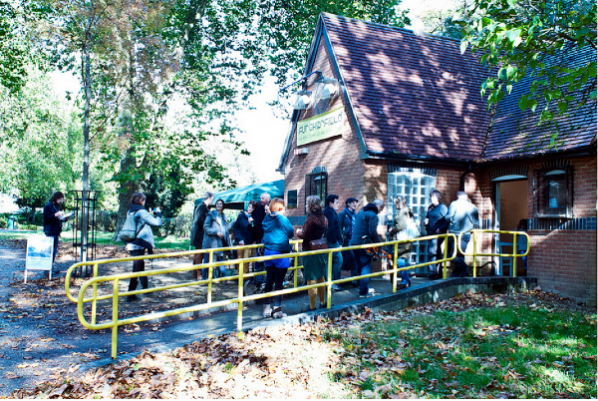
However, we are not just a gallery; we are a network connecting beyond a central hub.
“It is our contention that by engaging with these kinds of projects, the artists, viewers and participants involved become less efficient users and consumers of given informational and material domains as they turn their efforts to new playful forms of exchange. These projects make real decentralised, growth-resistant infrastructures in which alternative worlds start to be articulated and produced as participants share and exchange new knowledge and subjective experiences provoked by the work.” [9] (Garrett & Catlow, 2013)
The park setting informs our approach to curating exhibitions in a place with a strong local identity, a public green space set aside from the urban environment for leisure and enjoyment by a highly multicultural population.
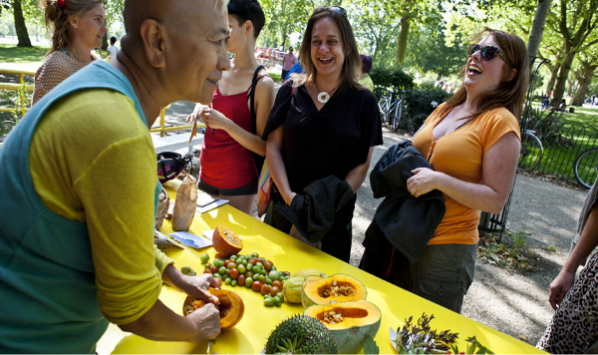
We are simultaneously connected to a network of international critical artists, technologists, thinkers and activists through our online platforms, communities, and wider networked art culture. We get all kinds of visitors from all backgrounds, including those who do not normally visit art spaces. We are not interested in pushing the mythology of high art above other equally significant art practices. Being accessible has nothing to do with dumbing down. It concerns making an effort to examine deeper connections between people and the social themes affecting theirs and our lives. We don’t avoid big issues and controversies and constantly engage in a parallel dialogue between these online communities and those meeting us in the park.
We feature works incorporating local people’s contributions, bringing them closer to the art and engagement of social dialogue. For instance, London Wall, N4 by Thomson and Craighead, reflected a collective stream of consciousness of people all around Finsbury Park, gathering their Tweets to print out and paste onto the gallery walls. By retweeting the images of the tweet posters, we gathered many of the original authors in the gallery to see their words physically located among others made in the vicinity.
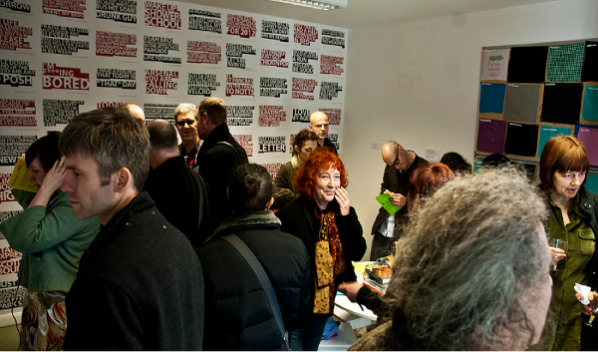
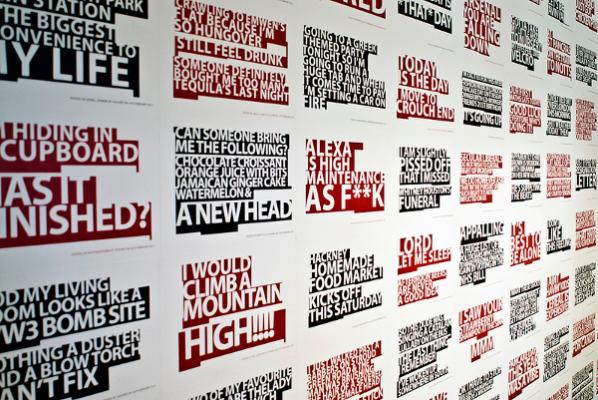
Crow_Sourcing by Andy Deck invited people to tweet animal expressions from around the world – illuminating the link between the formation of human language and our relationships with other wild webs of animal life. Gallery visitors illustrated their animal idioms, drawing directly onto the gallery walls, inspired by the ducks, crows, squirrels and dogs that inhabit the park.
We feature works dealing with networked and pervasive technologies’ human and social effects. Web 2.0 Suicide Machine by moddr_ proposed an improvement to our ‘real’ lives by providing a one-click service to remove yourself, your data, and your profile information forever from Facebook, Twitter and MySpace, replacing your icon (again, forever) with a logo depicting a noose. They also reflect on new forms of exposure and vulnerabilities they give rise to, such as Kay’s Blog, by Liz Sterry, which replicated in physical space the unkempt bedroom of an 18-year-old Canadian girl based only on her blog posts, to eerie effect. The intention is to reach people in a way that has people question their relationship with those technologies. This does not mean promoting technology as a solution to art culture but exploiting it to connect with others and critique technologies simultaneously.
Below: Selection of images from original slide presentation – exhibitions & events.
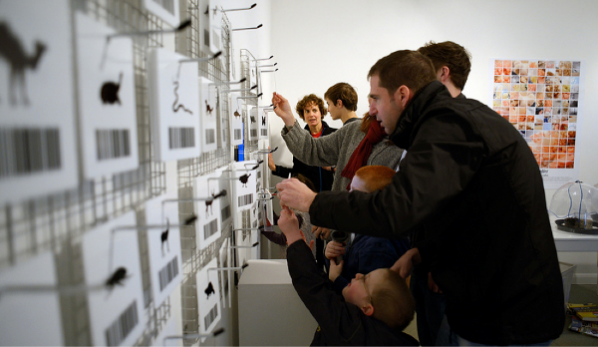

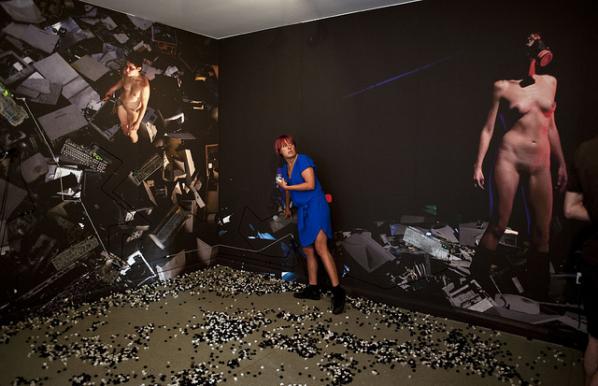
On the 23rd of November, we opened our second space in the park, ‘The Furtherfield Commons’. It kicked off with The Dynamic Site: Finsbury Park Futures, an exhibition by students from the Writtle School of Design (WSD) featuring ideas and visions for future life in Finsbury Park, coinciding with the launch.
This new lab space for experimental arts, technology and community explores ways to establish commons in the 21st Century. It draws upon influences from the 1700s when everyday people in England, such as Gerrard Winstanley and collaborators, forged a movement known as the Diggers, the True Levellers, to reclaim and claim common land from the gentry for grassroots, peer community interests. Through various workshops, residencies, events & talks, we will explore what this might mean to people locally and in connection with our international networks. These include free software works, critical approaches to gardening, gaming and other hands-on practices where people can claim direct influence in their everyday environments in the physical world, to initiate new skills and social change on their terms. From what we have learned from our years working with digital networks, we intend to apply tactical skills and practices into everyday life.
Furtherfield is a network across different time zones, platforms & places – online & physical, existing as various decentralised entities. A culture where people interact: to create, discuss, critique, review, share information, collaborate, build new artworks & alternative environments (technological, ecological, social or both), examine & try out value systems. “A rhizome has no beginning or end; it is always in the middle, between things, interbeing, intermezzo.” (Brian Massumi 1987)
DADA, Situationism, punk, Occupy, hacktivism, networks, Peer 2 Peer Culture, feminism, D.I.Y, DIWO, Free Software Movement, independent music labels, independent thinkers, people we work with, artists, activism, grassroots culture, community…
This comprises technological and physical forms of hacking. It also includes aspects and actions of agency-generation, skill, craft, disruption, self-education, social change, activism, aesthetics, re-contextualizing, claiming or reclaiming territories, independence, emancipation, relearning, rediscovering, play, joy, being imaginative, criticalness, challenging borders, breaking into and opening up closed systems, changing a context or situation, highlighting an issue, finding ways around problems, changing defaults, and restructuring things – Claiming social contexts & artistic legacies with others!
This text is a re-edited slide presentation first shown at the ICA, London, UK, on 16th November 2013 (Duration 25 min). Intermediality: Exploring Relationships in Art. Speakers Katrina Sluis, Peter Ride, Sean Cubitt & Marc Garrett.
http://www.ica.org.uk/39077/Talks/Intermediality-Exploring-Relationships-in-Art.html
Transdisciplinary Community (TDC) Leicester UK 27th Nov 2013 (45 min). Institute of Creative Technologies. De Montfort University.
Two projects Gregory Sholette is currently involved in:
It’s the Political Economy, Stupid. Curated by Oliver Ressler & Gregory Sholette
http://gallery400.uic.edu/exhibitions/its-the-political-economy-stupid
Matt Greco & Greg Sholette | Saadiyat Island Workers Quarters Collectable, 2013
http://bit.ly/1eSI5kX
—————————————————–
All exhibitions, events & projects at Furtherfield – http://www.furtherfield.org/programmes/exhibitions
Featured image: Kilmainham Gaol, Dublin, Ireland (Image Credit: Laura Forlano, July 2012)
He looks around to make sure no one is watching him and sets the phone down next to the boxes of cheese. The little silver telephone fits the spot strangely well. It looks as though it has always been sitting there. Having left Shirakawa’s hand, it is now part of the 7-Eleven. –Haruki Murakami, After Dark
Murakami’s novel After Dark (2007) which refers to both the mobile phone as well as the retail environment of the 7-Eleven seems a fitting place to begin a review of a new media art project that uses communication technology to explore and inhabit the space of shopping malls. Digital technologies have enabled the emergence of new forms of participatory art, design and creative practices that inhabit urban, communal and personal spaces in a variety of interesting ways. In June 2012, as part of the Midsummer Festival in Cork, Ireland, the German group Ligna, which consists of media theorists and radio artists, created a radio ballet entitled The First International of Shopping Malls. The ballet was part of a series of events called Parallel Cities that was curated by Lola Arias and Stefan Kaegi.
The First International of Shopping Malls builds on over a decade of new media art that has transformed and appropriated city spaces. For example, in 2003, the Chaos Computer Club’s Project Blinkenlights took, as its canvas, the façade of the former East German Department of Education in order to create a massive urban game board and visual display by programming the lights in each of the windows. Similarly, at the neighborhood level, in 2011, Timo Arnal created, Immaterials: Light Painting WiFi, a project that used Arduino-boards equipped with sensors to illustrate the shape of wireless networks on the streets of Oslo. Finally, at the level of the body, Mark Shepard’s Sentient City Survival Kit included an umbrella outfitted with infrared LEDs that are only visible to surveillance cameras.

One of the factors that has made it possible to use communication technologies to create interactive art of this nature is the decline in the cost of interfaces such as urban screens, devices including radio transmitters/receivers and portable computers, as well as sensors and LEDs. These technologies (as well as their invisible properties) offer artists, designers and programmers new materials with which to work. In addition, as art and design move outside of established institutions such as museums and galleries, city spaces and other non-traditional spaces become attractive settings for public and participatory projects.
These projects challenge the separation of physical from digital, global from local, private from public, and individual from community, which are relevant to the understanding of the way in which digital technologies are enabling hybrid spaces of creativity, curation and innovation. These hybrid spaces are the locus of emergent forms of organizing (Humphreys, 2008), new modes of citizen engagement (Foth, 2008; Foth, Forlano, Gibbs, & Satchell, 2011) and novel ways of experiencing urban space (Ito, 2003). Specifically, terms such as net locality (Gordon & Silva, 2011), code/space (Kitchin & Dodge, 2011), situated technologies (Shepard, 2011), and codescapes (Forlano, 2009) have been introduced in order to better articulate the ways in which digital interfaces, artifacts and networks have been integrated into urban space.
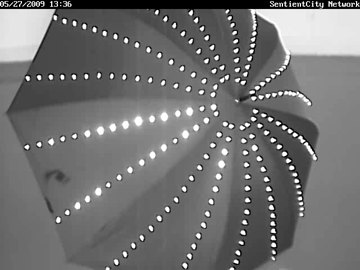
For the The First International of Shopping Malls, the artists built on the pervasive presence of earbuds and headsets among urban dwellers in order to take participants on a one-hour journey through a typical suburban shopping mall. About 25 participants were given a radio headset tuned to a specific station along with instructions about how to interact with the people, objects and spaces that they encounter as they navigate the mall. The artists created stories that gave voice, quite literally, to the architecture and the objects within the mall. The artists describe the shopping mall as, “a utopian place. It’s like a whole city is assembled in an idealised form below a glass roof. The goods displayed in shop windows sit there and patiently await their future owners.”
According to the curators of Parallel Cities, the suburban shopping mall, which is typically thought of merely as a functional space is an “observation station for urban life” that is “instantly recognizable” anywhere in the world. The First International of Shopping Malls appropriates this functional and commercial setting for the purpose of critique, reflection and participation — using the geography of radio receivers to demarcate the boundaries of the project. For example, if one wandered too far away from the transmitter on one side of the mall or moved to a different level of the mall, one would suffer from static interruptions and lose reception, thereby temporarily disappearing from the network of participants, which was constituted by people and their radio receivers (along with other devices and objects that they carried on their person).
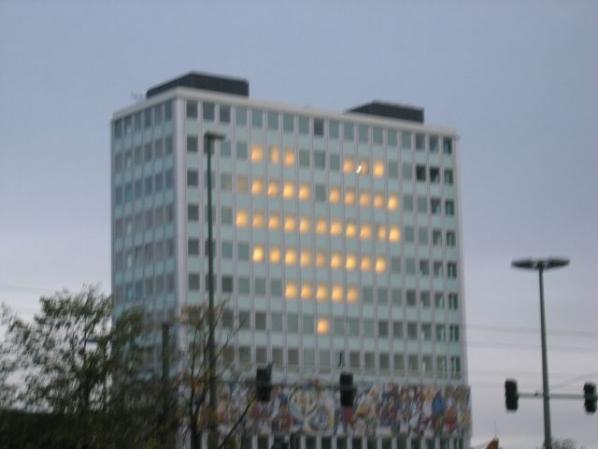
One of the objectives of Parallel Cities is to render personal, local and contextual that which has been designed for anonymous groups of strangers. In addition to the shopping mall, they include hotels, factories, train stations, rooftops and libraries in their project. In The First International of Shopping Malls, participants alternate between their individual and collective experiences of the radio-ballet. For example, while many of the activities that participants are encouraged to conduct in the mall can be done independently (such as walking quickly or slowly), at key points, participants are asked to follow a stranger around the mall mimicking their body language or join a group of other participants in a flash mob-like cluster for a few strides and then quickly disperse. Unlike a typical museum setting, which allows individuals to form relationships with specific artworks, or theatrical settings, which allow for the formation of a communal experience, this project allowed, people participate in temporary assemblages that traverse the terrain of the mall.
At one point, participants are asked to reimagine the space of the shopping mall with an alternative purpose in mind. We scribble our ideas on small, white, square slips of paper and, upon spotting other participants, discretely exchanged them without speaking. “Coworking space,” I had scrawled hastily, only to find that the participant with whom I’d exchanged slips had the exact same vision for the mall. In this way, the project challenged participants to engage in a dialogue and critique about the resources available in the mall without speaking a word aloud to one another.
Digital technologies have enabled new forms of surveillance and control. In the case of The First International of Shopping Malls, at the beginning of the broadcast, participants are given a brief history of the architecture of the shopping mall. The artists reference the similarity between Bentham’s panopticon, which was designed for the surveillance of prisoners, and the typical design of a suburban mall. This includes the oval structure of the inner walkways as well as the multiple levels, which can be observed at one time.
Because the artists had not gotten permission from the mall, participants were specifically asked not to mention the venue of the event using social media, which would have put an abrupt end to the project. In our case, towards the end of the hour-long event, the mall security became aware that something unusual was going on. This is because our coordinated behavior—walking quickly and slowly, joining together and breaking apart, jumping, exchanging notes—was noticeably bizarre. This caused several security guards to cluster together, wondering what was going on and, perhaps, questioning the location of the transmitter. We had been told specifically not to acknowledge any recognition of the event’s facilitator. While uneasy about the possibility of being confronted by the security guard, I was temped to capture photos of the congregating guards and succeeded in my own act of sousveillance.
Another unique feature of the event was the way in which the architecture and objects were animated in the space of the mall. Specifically, participants were asked to gaze at a window display, enter a store, and pick up an object, all the while listening to a fictional dialogue with the object itself. For example, through the narration on the headset, an object such as a hat would seem to call out “Choose me,” and, meanwhile, another object such as a scarf would seem to clamor for attention saying, “No, choose me.” In this way, the artists were able to bring to life the sentiments, social lives and working conditions of the objects themselves in order to create greater awareness about consumer culture.
In summary, The First International of Shopping Malls, uses radio technology to move artistic practice outside of traditional venues and appropriates commercial space for public participation. While the interaction between the artists and the participants is primarily one-way (the participation itself is not being captured or recorded and there is no way for the participants to talk back to the artists), the project relies on the participants to create the project. While this approach uses technology to go beyond traditional artistic practice, one might imagine ways in which the project might be made even more interactive and participatory using mobile devices to document and record different instantiations of the event. Furthermore, using radio technology, which demarcated the physical boundaries of the event, the artists were able to create a kind of community of practice (Lave & Wenger, 1991) within the space of the shopping mall that was engaged in a critique of consumer culture.
Use the Rubik’s Cube simulator if you don’t have a real puzzle to play with. Set a random scramble and try to figure out the solution!
“None but those who have experienced them can conceive of the enticements of science.” Mary Shelley, Frankenstein.
Rachel Falconer writes about the cyberfeminist art collective subRosa, a group using science, technology, and social activism to explore and critique the political traction of information and bio technologies on women’s bodies, lives and work.
Following a recent interview with the founding members of the collective, Hyla Willis and Faith Wilding, this article presents subRosa’s trans-disciplinary, performative practice and questions what it means to claim a feminist position in the mutating economies of biotechnology and techno-science.

The technological redesigning and reconfiguration of bodies and environments, enacted through the economies of the biotech industry, is an emerging feature of contemporary life. As these new ‘bits of life’ enter the biotech network, there is a slippage in our mental model of what constitutes the body, and more specifically, ‘life’ itself. As radically new biological entities are generated through the processes of molecular genetic engineering, stem cell cultivation, cloning, and transgenics, bio-artists and bio-hackers co-opt the laboratory as a site of critical cultural practice and knowledge exchange. Human embryos, trans-species and plants are constructed, commodified, and distributed across the biotech industry, forming the raw materials for bio-art, DIY biologists and open science culture.[1] These corporeal products and practices exist within new and alien categories, transgressing the physical and cognitive boundaries set by biopunk science fiction and edging towards the possibility of a destiny driven by genetics and life sciences. With the eternal rhetoric of a high-tech humanity, and the threat of Michel Foucault’s[2] biopolitics constantly on the horizon, today Harraway’s[3] myth of the cyborg exists in the form of corporeal commodities travelling through the global biotech industry. Scientific research centres stock, farm, and redistribute biological resources, (often harvested from the female scientists themselves). Cells, seeds, sperm, eggs, organs and tissues float on the biotech market like pork belly and gold. Seeds are patented, and other agro-industrial elements are remediated and distributed as bits of operational data across the biotech network. We/cyborgs[4], are manifested as a set of technologies and scientific protocols, and, as a result, the female body in particular, is reconfigured into a global mash-up of cultural, political and ethical codes.
The increasingly pragmatic realisation of the biotech revolution has provoked a ‘cultural turn’ in science and technology studies in general, and feminist science studies in particular. Carolyn Christov-Bakargiev’s dOCUMENTA (13) proposed an interdisciplinary approach to the role of science for ‘culture at large’. Certainly, by foregrounding the heavy hitters in the field such as Donna Haraway and Vandana Shiva, dOCUMENTA (13) laid claim to addressing the global conflicts of biotechnology. However, the feminist agenda was not specifically addressed, and the key issues of the impact of biotechnologies on feminist subjectivities were only paid minimal lip service. With the exception of Shiva[5], the tone of dOCUMENTA (13) hinted at a positivist, emancipatory take on biotechnology and technoscience without assuming a critical position. There was very little public debate or critical analysis engaging the philosophical, ethical, and political issues of feminism and female subjectivities within the realm of biotechnology.
Notably absent from last year’s dOCUMENTA (13), the activist feminist collective subRosa’s performative, interdisciplinary projects are channelled towards embodying feminist content, practices, and agency, and laying bare the impact of new technologies on women’s sexuality and subjectivities – with a particular emphasis on the conditions of production and reproduction. Through their research-led practice and pedagogical mission, the collective analyse the implications and conditions of the constantly surveyed female body, whilst mapping new possibilities for feminist praxis. subRosa interrogate the conditions of surveillance, private property rights, and other control mechanisms the female body is subjected to by ART(Assisted Reproductive Technologies). The collective’s hybrid, interdisciplinary practice navigates the multiple identities the female body has taken on through techno-scientific development, including: the distributed body, the socially networked body, the cyborg body, the medical body, the citizen body, the soldier body and the gestating body. In contrast to the overarching and pervasive illustration of the technoscientific cultural landscape painted by dOCUMENTA(13), the current members and founders of the collective, Hyla Willis and Faith Wilding, are very clear in their critical intent. The collective choreograph and place themselves within globalized bio-scenarios in order to question the potential for resistance and activism within these constructs.
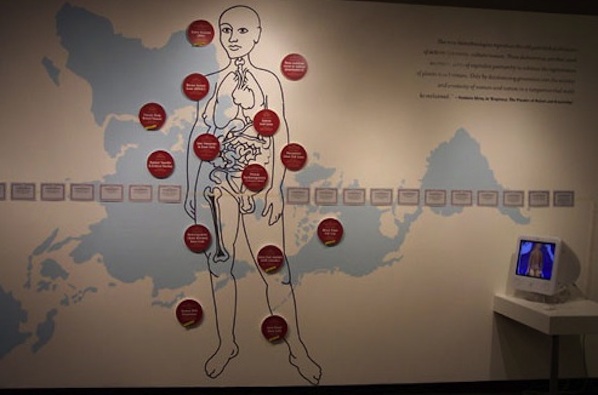
subRosa’s overarching vision to create discursive frameworks where feminist interdisciplinary conversations and experiments can take place, is research-led and takes its cue from the canon of radical feminist art practices. Cell Track: Mapping the Appropriation of Life Materials has featured in a number of exhibitions, most recently in Soft Power. Art and Technologies in the Biopolitical Age, Vitoria-Gasteiz, Spain. This project consists of an installation and website examining the privatization and patenting of human, animal and plant genomes in the context of the history of eugenics. Cell Track highlights the disparity between the bodies that produce stem cells and the corporations that control the products generated from them. Bringing together scientists, cultural practitioners and wider publics in the construct of the gallery space, subRosa generate discourse around the patenting and licensing of DNA sequences, engineered genes, stem cell lines and transgenic organisms. The project’s participatory aim is to set up an activist, feminist embryonic stem cell research lab in order to produce non-patented stem cell lines for distribution to citizen scientists, artists and independent biotechnologists. This environment of shared knowledge production and speculative, alternative, research activity is at the heart of subRosa’s social practice.

Due to the pedagogical nature of subRosa’s activities, the collective’s critical stance towards IVF and ART has proven to be particularly provocative, and their scepticism towards the emancipatory language of ‘choice’ co-opted by ART, has been met with some resistance by other feminist practitioners. However, it is in this very agonism[6] that subRosa wish to become more visible, and they welcome criticism and debate in the public discursive spaces that they create. In a recent interview, Faith Wilding and Hyla Willis both expressed their desire to generate an expanded, and deeper discussion about the wider issues involved in ART in particular and biotechnology’s effect on female identity in general. subRosa’s potential to reach wider publics and audiences is partially determined by the socio-political context of the communities in which they operate. Perhaps in reaction to this, subRosa’s focus is now shifting towards embracing the aforementioned ‘cultural turn’ in science as they address the position of feminist scientists themselves.
The imperative to reclaim feminist discourses and narratives in science is of growing concern to subRosa, as they believe that feminist agency lies in the practice of science itself. By relocating lab-work from the dominant scientific institutions to the public environment of the gallery, subRosa provide the critical space in which new feminist scientific praxis can operate,[7] and new dialogues and discourses can be created. Their conviction that political and critical traction lies in practice as discourse, and the potential of face to face encounters, is demonstrated in their recent project for the Pittsburgh Bienal: Feminist Matter(s): Propositions and Undoings (2011). In this installation, SubRosa take Virginia Woolf’s[8] assertion that ‘tea-table thinking’ provides an effective antidote to the male-driven ‘war-mentality brewed in boardrooms and command centers’ as their main conceit. Redeploying Woolf’s idea toward the rethinking of the traditionally male-dominated discipline of science, Wilding and Willis’ installation brings traces of the science laboratory to the intimacy and hospitality of the kitchen table, and in turn, also situates what is normally a private, feminized space in a more public domain.
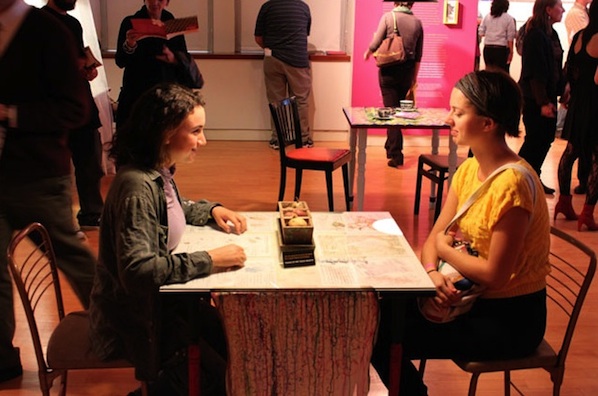
These tables stage a dialogue between one or two visitors in response to the presentation of female figures in science, both the popularly acknowledged and the underexposed. subRosa foreground women scientists past and present and reimagine an alternative, feminized history of science and technology. The installation explores feminism and participatory practices as modes of scientific research, with the aim of generating dialogue and discourse around the questioning of the dominant historical narrative of science. Specially tailored installations reside on each table, evoking lab work while celebrating the history of the women protagonists they play host to – from anarchist painter Remedios Varo to geneticist Barbara McClintock.

subRosa’s pedagogical imperative is at once inclusive and provocative, and their role as facilitators of a discursive space outside the traditional institutions and control structures of science, is where their radical aspirations lie. Pedagogical art practices often teeter on the brink of propaganda, and subRosa are quite comfortable with the propagandistic label. Considering the economic and cultural climate in the USA with regard to the politics of reproduction, their work has been particularly well received in the context of European cultural institutions, whereas in the USA there is greater interest for the work in academic institutional settings. Perhaps this could be symptomatic of the general privileging of discourses around intersex, transgender and queer subjectivities. The dominant bias of the gatekeepers of the artworld to showcase queer practices is evident in the promotion of artists such as Ryan Trecartin and Carlos Motta on the international circuit. Curators have tended to position artists addressing the gendered ‘Other’ within a contemporary queer framework, whilst keeping feminist art practices on the peripheries of 1960s/1970s retrospective nostalgia. This tendency presents a muddying of the waters for contemporary feminist art practices such as subRosa.
This may also be part of a more general tendency to demonize and move away from feminist identities and discourses in wider society. The academic shape shifting from ‘women’s studies’ to ‘gender studies’ to ‘queer studies’ has diminished the feminist conversation and, therefore, the impact and receivership of feminist art practices. This has rendered the popular conception of ‘Queer’ as acceptable and non-aggressive. Furthermore, the term ‘Queer’ and the subsequent morphing into the verb ‘queering’, has been co-opted by transdisciplinary academic discourse, and is now an expansive, all embracing cultural term – a phenomenon that has met with a certain amount of scepticism from the queer community.
This privileging of the expansive ‘othering’ of queer rhetoric has often resulted in feminism being rejected as a radical and out-dated political identity by art practitioners themselves. This ambivalent attitude is perhaps also indicative of the wider feminist debate, in which post-feminism has splintered into fragmented, diluted groups, each policing their own identity politics with little sense of a bigger struggle. However, the collaborative, interdisciplinary environments orchestrated by subRosa signal a return to the indisputably material actuality of the female body. Through their insistence on the possibilities of feminist bench-side practices, and the forensic unpicking of the power/control structures inherent in biotechnology, subRosa expands the feminist lexicon through the empirically re-appropriated organic materiality of the body.
Featured image: PAH graphic resources
Over the last few years there has been a keen interest in discussing the notion of public space; demonstrations, camps, collaborative projects, artistic interventions, community projects, social activism are just a few names that exemplify the different forms of engagement that deal with the complexities of it. Despite their different aims and impact most of these actions have given evidence of the need to re-appropriate the public space; through collective and networked practices individuals, groups and organizations ‘challenge the conventional notion of public and the making of space’[1]. Although the liveness and even virality of these events, projects or actions hinder any prediction about its midterm effects or endurance, the fact is that there is an emerging legacy that is already dismantling certain assumed thoughts about ‘the public’.
The retiree Hüseyin Çetinel’s initiative of painting a public stairway with rainbow hues in his neighbourhood in Istanbul has been the last case involving cultural transformation, virality and social activism. After he painted the local stairs to ‘make people smile’ and ‘not as a form of activism’ the municipal cleaning service painted over the stairs in dull grey provoking a chain reaction that mobilized citizens to paint stairways throughout the city. Local communities and social movements appropriated this beautiful participatory action as a form of protest after Çetinel’s stairway became viral in the social media. This example shows the intricacies of the public space and its expanded performativity. As Gus Hosein Executive Director of Privacy International argues ‘there is a confusion as to what is public space is and how it relates to our personal and private space’ in a social context where the emergence of the use of social media and surveillance as well as the appropriations of the space by private corporations and social movements and individuals are constantly questioning its boundaries[2].
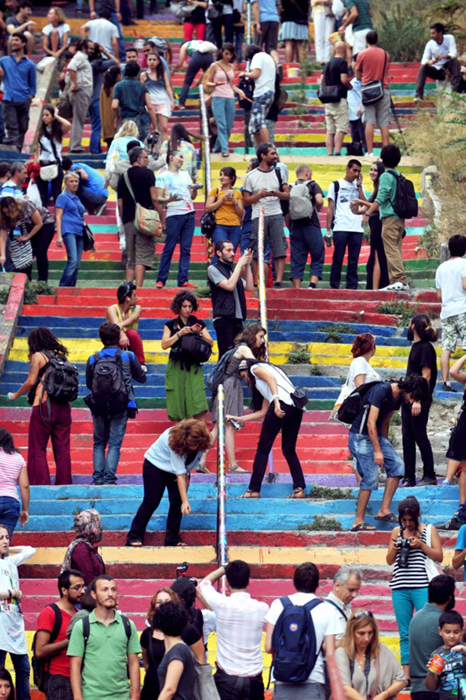
From my point of view, some of these actions that play in-between the social, political and artistic might be considered re-enactments of the public space as they aim to reconstruct the term itself by applying alternative procedures and by generating at the same time transductive pedagogies. However, in order to give a comprehensive understanding of the implications of the public space and its controversies it is essential to rethink the notion of the private space. Traditionally, home has been recognized as the physical private space; home is the main representative of the private sphere that encompasses the domestic and intimate. According to Joanne Hollows, ‘the distinction between the public and the private has been a key means of organizing both space and time’[3] and consequently to promote a clear functional division.
This traditional perspective has been questioned and altered due to some current issues and events that are noticeably interconnected with those of the public space; an increasing number of evictions and homeless peoples, housing policies, escraches[4] in front of the houses of politicians, the appearance of ghost neighbourhoods due to real estate speculation, home as an alternative space for performance practice and community development, among others. Thus, home might be conceived as a container of individuals and actions, as a social product or instrument, as topographical placement or as a relational structure. Home entangles interesting layers of analysis that might serve to establish new relational and yet responsive parameters to understand both the private and public space. Some of the following examples that perform between art, activism and affections corroborate the significance of home; as Blunt and Dowling state ‘home is not separated from public, political worlds but it constituted through them: the domestic is created through the extra-domestic and viceversa’[5].
In Barcelona, the city where I live there have been noticeable factors that have stressed the importance of home as a topic of interest. Probably the most significant case is the increasing number of evictions―over 350.000 in the last four years―as many families cannot afford their rent or mortgage after losing their jobs (the unemployment rate is 26.3%). Beyond the personal implications and devastating effects that evictions have on families, they also indicate that home is not anymore our secure space or refuge; on the contrary, if the individual does not respond to the production and consumption requirements is physically displaced to the streets. Consequently, many citizens are trying to find shelter back again in the public space.
If the 70s Richard Sennett announced the decay of the public space by the emergence of an ‘unbalanced personal life and empty public life’[6], the related problems with housing have provoked the reactivation of the public space at many levels. At the same time, there is an increasing culture of the debt that ties together individuals and financial institutions in long-term relationships. As Hardt and Negri explain ‘Being in debt is becoming today the general condition of social life. It is nearly impossible to live without incurring debts—a student loan for school, a mortgage for the house, a loan for the car, another for doctor bills, and so on. The social safety net has passed from a system of welfare to one of debtfare, as loans become the primary’ means to meet social needs’[7].
These ideas can be exemplified by the actions of PAH (The Platform of People Affected by Mortgage Debt), an activist group of citizens that stops evictions through demonstrations and guerrilla media actions in the streets and that also helps struggling borrowers to negotiate with banks and promotes social housing[8]. This organized group of citizens has been awarded this year the Citizen Award by the European Union for denouncing abusive clauses in the Spanish mortgage law and battling social exclusion. PAH has received the support of the collective Enmedio that generates actions in the midst of art, social activism and media. For example, their photographic campaign ‘We are not numbers’ consisted in the design of a collection of postcards each one containing a portrait of a person that was affected by the mortgage debt by a local bank entity. The postcards were delivered in front of the bank’s main building for people to write a message. The written postcards were then stuck in the front door main door turning numbers into a collage of human struggle. PAH and Enmedio actions become highly effective thanks to their media impact and their virality in the social media. Invisible individuals isolated in their struggle, find alternatives through an assemblage of support that connects the public and private space and that is also mediated by informative and constitutive tools that the virtual space offers. As Paolo Gerbaudo claims ‘social media have been chiefly responsible for the construction of a choreography of assembly as a process of symbolic construction of public space which facilitates and guides the physical assembling of highly dispersed and individualized constituency’[9].
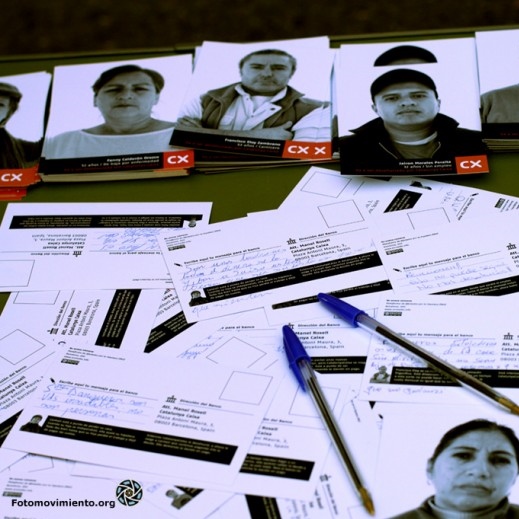
Processes of speculation, gentrification and eviction can be found in many western cities as well as different kinds of collectives and groups working for human rights advocacy. This is also the case of the Brooklyn based collective Not an Alternative has also carried out different guerrilla actions concerned with the problem of housing and eviction such as their series of workshops and media actions of ‘Occupy Real State’ or ‘Occupy Sandy’.
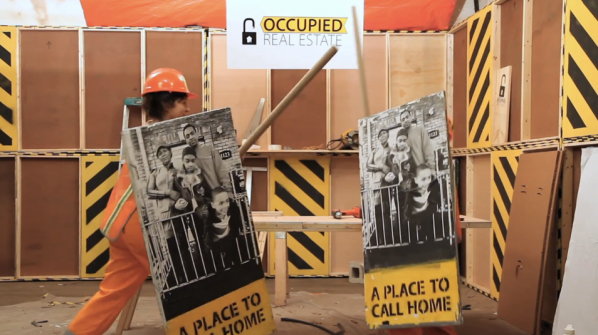
Many of the actions that these collectives promote might be understood as DIY activism as they are based on the empowerment and the development of skills. In this regard, it is interesting to observe how DIY that traditionally has been related to activities in the domestic space serves as a strategy to protect it and to trigger new forms of protest in the public space while enhancing the creation of an expanded family (or at least a sense of togetherness) through the social media.
Despite these actions, the public space is still home for many individuals. In the UK, different associations are concerned about the impact that the implementation of the bedroom tax might have, especially in London where the number of rough sleepers rises every year with an increase of the 62% since 2010-2011. The scenario is not different in many other European cities where beyond these worrying numbers there is also an increasing number of regulations and policies that difficult the life in the public space. As Suzannah Young stresses, ‘homeless people often need to use public space to survive, but are regularly driven off those spaces to satisfy commercial or even state interests’. Public space is often only open to ‘those who engage in permitted behaviour, frequently associated with consumption’[10]. The increasing number of quasi-public spaces―’spaces that are legally private but are a part of the public domain, such as shopping malls, campuses, sports grounds’ and so forth― questions again the boundaries of the private and public space, especially when ‘some EU cities use the criminal justice system to punish people living on the streets for doing things they do in order to survive, such as sleeping, eating and begging’[11]. All these policies have clear implications in the use of space and it is potential possibilities. The fact that the public space becomes home involves the reconsideration of the uses of the public space and the understanding of it through the eyes of the people that fully inhabit it. The London collective The SockMob run the Unseen Tours, alternative city tours guided by a group of homeless. Their embodied knowledge appears as a key aspect to develop these DIY versions of the city while promoting relationships between the homeless and the tour participants.
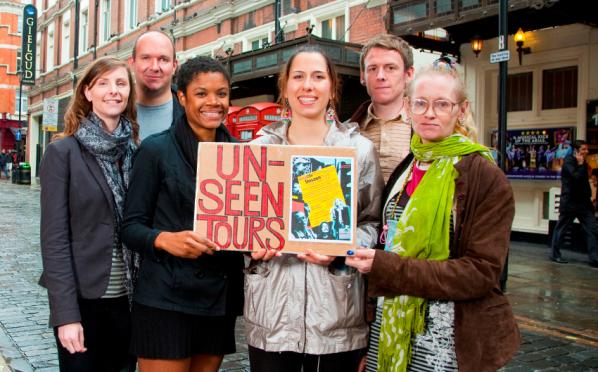
Where is home? In which ways access to spaces gives us opportunities and rights as individuals? In which ways all these site-specific initiatives that often have a transnational reach re-construct the notions of private and public space? How these DIY and media actions are generating new forms of visual arts activism? Despite the fact that these queries might need further analysis, I believe that the qualities of space becomes visible and tangible through these interactive and responsive actions with the spaces. Recently, an international group of activists, visual artists and scholars have published a handbook in which their consider these forms of activism militant research. According to them, ‘militant research involves participation by conviction, where researchers play a role in the actions and share the goals, strategies, and experience of their comrades because of their own committed beliefs and not simply because this conduct is an expedient way to get their data. The outcomes of the research are shaped in a way that can serve as a useful tool for the activist group, either to reflect on structure and process, or to assess the success of particular tactics’[12]. Hence, the idea of some hands-on, the acquisition of skills and the performance of theory appear as key aspects to disentangle and analyse the qualities of the space.
From an artistic perspective home has been crucial in many historical periods of dictatorship to construct an underground scene of the arts; in many of these cases, the evidence of artistic practice appears through testimonials and documentation (photographs, fanzines, recordings, etc.). Again different forms of media help to make the clandestine public, crossing the sphere of the private into the public realm. Thus, the importance of documentation enhances different temporalities of reception and impact in the public realm. In this regard, a differed presentation of the artistic works triggers a reconsideration of the attributes of the spaces too. Currently, homes serve as a basic space for artists to present their work; in the case of music, this is a widely known practice in the US that is becoming more and more common in other countries and other art forms. Homes serve as a personal curatorial space for fine arts artists through the open studio festivals too; artists make their private space open for others as a strategy to show their work publicly. At the same time, in some artistic disciplines self-curation through digital portfolios is becoming increasingly used to showcase artworks. One way or another, home remains often the main space for creativity, production and curation through and expanded DIY conception of their profession.
Home becomes even more crucial in a context marked by the arts cuts and the economic crisis. In this regard, there are initiatives that see an opportunity in the relationship between the public and private space not only to exhibit or perform art but also to trigger a counter-performative form of showing works. This is the case of the domestic festivals that try to challenge the concepts of cultural enterprise and institution by proposing home as a legitimate space of the artistic experience. Friends, neighbours and acquaintances offer a room or a space in their house for artists to perform there (examples can be found in different cities such as Santiago de Chile, Madrid, Berlin, Barcelona, etc.). At the same time, the format wishes to transform the spatial and affective relationships that citizens have with the space, by inverting the spatial dichotomy between the public and the private. Hence, the idea goes beyond to a practical solution to have a space to perform as it also aims to give visibility to performing practices that have not been yet legitimized by the public sphere and they are in danger to remain in a sort of clandestinity (as they are not part of the current cultural market). In this regard, there is also a sense of evicted or homeless art that is trying to produce a social context of experience and articulation beyond the immediate effects of the power that governs at many level the public sphere. These kinds of initiatives generate ‘an activity that undermines the exclusion by letting occur, at the very boundary which separates the public from the “secret”’, an articulation which challenges the prevailing framework of representation and legitimation’[14].
The intersection between art, activism and affections help to explain the multiple and complex questions that configure the notion of home. With these examples I just wanted to stress the importance of home in the discourses that address the concepts of public space/public sphere/publicly. Thus homes ‘are thereby metaphorical gateways to geopolitical contestation that may simultaneously signify the nation, the neighbourhood or just one’s streets’[15]. From a transnational perspective, home seems to pose the crucial questions that connect us with what is happening inside, outside and in-between the spaces and gives us a different perspective to analyse current artistic and social practices that engage with our mode of action, production and identity.
I guess this is all from my home.
Public Screening and Discussion at Furtherfield
Contact: info@furtherfield.org
Visiting Information
THE EVENT HAS LIMITED AVAILABILITY.
PLEASE RSVP TO BOOK YOUR PLACE TO ALESSANDRA
Cornelia Sollfrank will present her latest film Giving What You Don’t Have. It features interviews with individuals Kenneth Goldsmith, Marcell Mars, Sean Dockray, Dmitry Kleiner, discussing with Sollfrank their projects and ideas on peer-to-peer production and distribution as art practice. It includes the projects ubu.com or aaaaarg.org, which combine social, technical and aesthetic innovation; they promote open access to information and knowledge and make creative contributions to the advancement and the reinvention of the idea of the commons.
The post-screening discussion will be led by Cornelia Sollfrank, Joss Hands & Rachel Baker.
On the basis of the interviews of Giving What You Don’t Have, we would like to discuss some of the issues they represent such as new forms of collaborative production, the shift of production from artefacts to the provision of open tools and infrastructures, the development of formats for self-organisation in education and knowledge transfer, (the potential and the limits of) open content licensing as well as the creation of independent ways of distributing cultural goods. An implicit part of Giving What You Don’t Have is a suggested reconceptualization of art under networked conditions.
Cornelia Sollfrank is a postmedia conceptual artist and interdisciplinary researcher and writer. She studied painting at the Academy of Fine Arts in Munich and fine art at the University of Fine Arts of Hamburg (1987-1994). Since 1998 she has taught at various universities and written on issues in the nexus between media, art and politics. In 2011 Sollfrank completed her practice-led interdisciplinary research at Dundee University (UK) and published her PhD thesis with the title Performing the Paradoxes of Intellectual Property. In addition to her work in the artistic and academic fields, Sollfrank gathered experience in the private sector by working as product manager for Philips Media for two years (1995-1996).
Joss Hands‘ research engages the relationship between media, culture and politics. His recent work has explored the role of digital media in direct action, protest and activism, culminating in his book @ is For Activism: Dissent Resistance and Rebellion in a Digital Culture, published by Pluto Press in 2011. His previous research has explored the role of new media in formal democracy and governance as well as its cultural, economic and social impact. He has published in a number of journals such as Information, Communication and Society, Philosophy and Social Criticism and First Monday as well as writing commentary for publications such as Open Democracy, IPPR Journal, The New Left Project, and others.
Rachel Baker is a network artist who collaborated on the influential irational.org. Her art practice explores techniques used in contemporary marketing to gather and distribute data for the purposes of manipulation and propaganda. Networks of all kinds are “sites” for Baker’s public and private distributed art practice, including radio combined with Internet (Net.radio), mobile phones and SMS messaging, and rail networks. She has presented and exhibited work internationally at various new media and electronic art festivals.
Giving What You Don’t Have is an artistic research project commissioned by the Post-Media Lab, Leuphana University.
Furtherfield Gallery
McKenzie Pavilion, Finsbury Park
London N4 2NQ
T: +44 (0)20 8802 2827
E: info@furtherfield.org
Furtherfield Gallery is supported by Haringey Council and Arts Council England.
Richard Stallman[1] the outspoken promoter for the Free Software movement, hates Facebook with a passion. He proposes that we should all leave Facebook and either find or build our own alternatives. The evidence offered by Stallman’s and the Electronic Frontier Foundation’s (EFF), who have been fighting for Internet freedoms since the 90s [2] shows how necessary it is that we understand and are more pro-active in managing the personal data that we give away through our online activities.
When we subscribe to Web 2.0 platforms such as Facebook we are at the mercy of the data brokers. These companies trade in people’s personal data; information which is aggregated by monitoring user actions and interactions across social media. This information can include “names, addresses, phone numbers, details of shopping habits, and personal data such as whether someone owns cats or is divorced.”[3] Fast moving developments in social media, make it difficult to keep up with the effects and consequences of these platforms. This is why the work of groups such as Commodify Inc. is so valuable. They bring imaginative and critical attention to the situation, sharing their knowledge of these daily networked complexities and correcting what they see as its negative effects.
Commodify Inc. is an artist-run Internet startup producing projects to help individuals capitalize on their online monetary potential. Their intention is to correct the imbalance of power in markets where users have no control over the transactions made with their personal data. They have completed various artistic projects and interventions on social media like, Fame Game, Give Me My Data, and Web 2.0 Suicide Machine. The co-founders are Birgit Bachler, Walter Langelaar, Owen Mundy, Tim Schwartz, with additional contributors Joelle Dietrick and Steven Alvarado.
Their new project Commodify.Us, was initiated when Owen Mundy and Tim Schwartz were invited by moddr_ to a residency in their lab in the summer of 2012 – when they were still a part of the WORM collective in Rotterdam. They worked on an initial idea that would succeed previous experiences of their already well-known and respected projects.
Commodify.Us is currently in beta phase. It promises to provide a platform for people to regain control over the commercial exploitation of their own personal data.
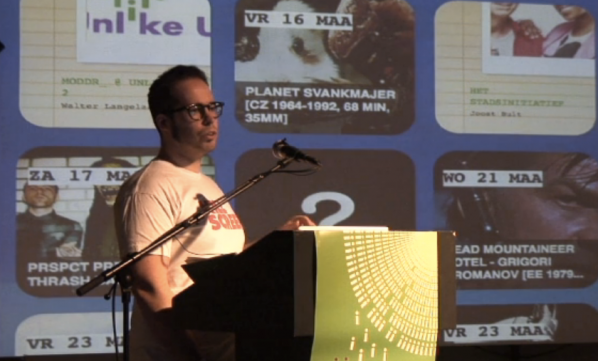
Intrigued by this project I contacted one of the co-founders, Walter Langelaar via email and asked him a few questions about this new platform.
Marc Garrett: Commodify.Us is for people to have greater control over their data. And it works when users export their data from social media websites and upload it to your platform. How will these users gain more control over their data and why is this important?
Walter Langelaar: Commodify.Us provides a platform for you to regain control over the commercial exploitation of your personal data. After exporting your profile data from social media websites and uploading the data to Commodify.Us, you can directly get in contact with interested buyers. On the importance for users I would say that it’s part raising awareness surrounding the monetization of profile data, and part creating a platform where people might work out and discuss how to do this themselves.
MG: It proposes to re-imagine the potential of relational data, creating a casting agency for virtual personas. I’m wondering what this may look like?
WL: We were too. In an early stage of the project we played with the idea that peoples’ various profiles could function like that within an agency; a client would ask for a specific set of qualities and/or characteristics within a set of profiles, and we could provide for this based on the uploads and their licensing options as set by the user. In the end we abandoned this idea for clarity.
MG: Commodify.Us offers people the opportunity to be part of an economy where interested buyers will pay to use the data supplied, unlike existing social media websites. How does this work?
WL: We are gearing up for a launch where the main goal will be to get a critical mass of around, a 1000 profiles. We anticipate that only with this kind of mass or volume will our initiative take hold with the potential buyers we have in mind, and the same goes for the more creative projects that could use the (open) data. Regarding the open profile data and otherwise licensed profiles that allow for reuse, we are researching the idea of ‘Fair Data’ (as in Fair Trade) and how to implement this as a profitable protocol for the end-user.

“Net activists construct tools whose intervention potential can be initiated by users under net conditions. These tools enable activists to develop new strategies in the data space of the Internet because they offer new means: New means afford new ends.”[4] (Dreher)
In his publication Networks Without a Cause: A Critique of Social Media, Geert Lovink lays down the gauntlet and asks us to “collectively unleash our critical capacities to influence technology design and workspaces, otherwise we will disappear into the cloud.” Anna Munster opens her excellent survey, Data Undermining: The Work of Networked Art in an Age of Imperceptibility, by saying “The more data multiplies both quantitatively and qualitatively, the more it requires something more than just visualisation. It also needs to be managed, regulated and interpreted into patterns that are comprehensible to humans.”[5] Commodify.Us goes one step further by allowing users to manage, regulate, repattern and reappropriate their own data using tools that share an essential functionality (if not purpose) with the power tools of Web 2.0.
Those previously seen as rebellious hacktivists are moving into new territories that deal with concepts of service. There has been a significant rise of artists exploring technology to influence mass Internet activity, against the domination of corporations who are data mining and tracking our on-line activities. Another example is TrackMeNot developed by Daniel Howe and Helen Nissenbaum. This is an extension created for the Firefox browser. “It hides users’ actual search trails in a cloud of ‘ghost’ queries, significantly increasing the difficulty of aggregating such data into accurate or identifying user profiles.”[6]
Howe and Nissenbaum mention they are aware their venture is not an immediate solution. However, the more we hear of and join these imaginative strategies “whereby individuals resist surveillance by taking advantage of blind spots inherent in large-scale systems” [7], and the more we adapt our behaviours to adopt these new ‘activist’ services, the more we demonstrate the demand for these new alternatives. And by so doing, we argue for the value of services that we can trust not to steal or manipulate our social contexts for financial and political gain.

A significant value offered by the Commodify.Us platform is the power to manage our own data. The simple act of downloading our own data from Facebook, and then uploading it to Commodify.Us supports us to rethink what all this information is. What once was just abstract data suddenly becomes material that we can manipulate. Alongside this realization arrives the understanding that this material was made by our interactions with all these platforms, and that other people are spying on us and making money out of it all. Once this data material is uploaded onto the Commodify.Us platform, it asks if we want this stuff to be a product under our own terms, or if we wish to make art out of it using their tools.
This is a cultural shift that demonstrates how contemporary Hacktivists are developing software that promises to offer realistic service infrastrucutures. When I interviewed Charlie Gere in 2012[8] he said that these artists “are not part of the restricted economy of exchange, profit, and return that is at the heart of capitalism, and to which everything else ends up being subordinated and subsumed. Thus they find an enclave away from total subsumption not outside of the market, but at its technical core.” For me, this kind of work is of central importance to the contemporary era, and it only occurs where artists cross over into territories where their knowledge of networks directly contributes to the building of alternative structures of social independence.
In conjunction with Shu Lea Cheang and Mark Amerika exhibition, Furtherfield is pleased to host Shu Lea Cheang’s Seeds Underground Party.
In certain parts of the world, the vast farmlands have been colonised by genetically modified crops for our staple foods (i.e. wheat, soybeans, corns). Introduced 30 years ago, the transgenic biotechnology has since been commercialised by the patent-protected corporate sectors. Taking over the wholesale markets, the Herbicide-tolerant and pest-resistant seeds promise higher yields and profits without much ecological concerns. This year, the European Union is about to adopt a new seed policy, which favours the seed industry corporations by making all seeds subject to strict regulation. It is feared that this will hurt organic varieties and prevent seed exchange by seed farmers and savers.
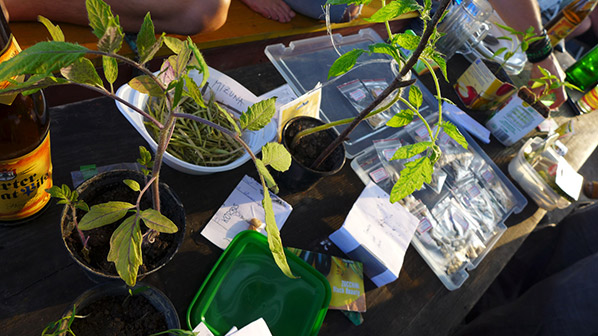
Join us for a seed exchange party where packets of seeds change hands and go underground in the fields around Finsbury Park and beyond.
Bring your self-harvested homegrown seeds of sorts! Sign on to trade seeds, to adopt and germinate, to broadcast and track their distribution. Share some food, drinks and seeds stories while we celebrate the harvest season together in the relaxing setting of Finsbury Park.
+ To join Seeds Underground Party, and trade and track your seeds, please register on http://seedsunderground.net
Click on TRADE and select Furtherfield, London from the “join a seeds underground party” pull down menu.
Seeds Underground holds seed exchange parties where packets of seeds change hands and go underground in the fields across nation borders.
+ More information:
now@seedsunderground.net
www.seedsunderground.net
Furtherfield Gallery
McKenzie Pavilion, Finsbury Park
London N4 2NQ
T: +44 (0)20 8802 2827
E: info@furtherfield.org
Furtherfield Gallery is supported by Haringey Council and Arts Council England
Featured image: Outsider Art
The 55th Venice Biennale has arrived, and with it brings a new state of trends which are pontificated around, with a chuckle, a sense of forced opportunity and the shrugged sigh of ‘well, everyone’s doing this now apparently.’
The trend in question consists in a renewed attention towards Outsider Art (as famously termed by Roger Cardinal), or perhaps more famously the return of Jean Dubuffet’s ‘Art Brut’, under the modern moniker of ‘Folk Art’; the famous definition given to artworks, constructed outside of the critical art world system or outside the world of aesthetic critique. Specifically, Outsider Art denotes a straightforwardness of practice, which deliberately rejects, or remains unaffected by artistic techniques and instead embellishes a bold directness or authentic personal vision. This, we are told, is a renewed return to the interests of authentic practitioners, giving spectators the chance of ‘trying to see more’ in the broadest sense. These are artists who exist without official global branding, nor the ease of stylistic marketing, nor the calculated requirements of visitor numbers.
Outsider artworks (echoing Dubuffet) are aesthetically valuable, precisely insofar as they haven’t been created for the sole purpose of critique, nor for being deliberately market-friendly (the last point is quite contentious). They are what they are. Or at least, ‘what they are’ is grouped around a deviation from the mainstream ‘norm’.
Massimiliano Gioni, the latest curator of the world’s oldest contemporary art exhibition, titled its flagship show “The Encyclopedic Palace” after the self-taught artist Marino Aurtit (1891 – 1980), and his elaborate proposal to build a house of knowledge in Washington D.C. Gioni warned that the Biennale would not trace the familiar ‘who’s who’ of previous festivals (despite having its usual art stars), but will, in part, follow the aesthetic footsteps of the ‘illustrious nobody’ and ‘dilettante’, like Aurtit. Gioni even joked that this biennale, may be exposed as a “thrift-store biennial’ – yet his entire intention is to “break away from this pressure of the new“. True to his word, you wouldn’t exactly find an entire room dedicated to Carl Jung’s Red Book manuscript, or Rudoph Steiner’s blackboard drawings, at major art fairs.
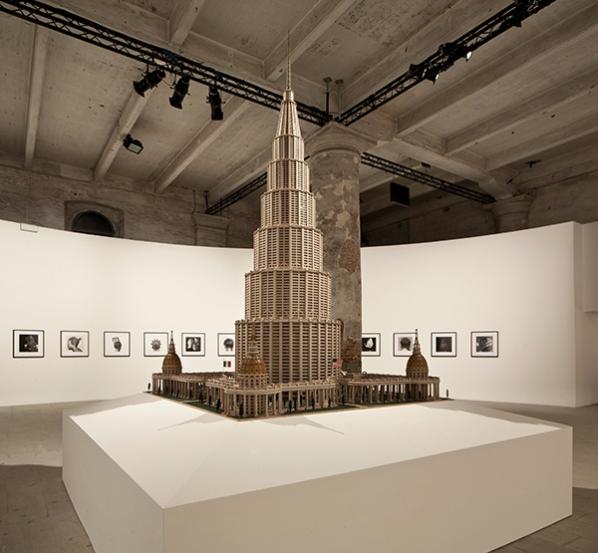
Just last week, the Hayward Gallery has been one of the first public-funded galleries in Europe to host a major event which focuses entirely on Outsider art: “An Alternative Guide to the Universe“. Unlike Gioni’s effort, the entire Hayward gallery is filled with self-taught, yet highly skilled obsession-led projects from the private wing of the aesthetic fringe: the intricate math puzzles of George Widener or the technical drawings of Karl Hans Janke, a schizophrenic inventor who envisioned rockets running on clean energy. There is, like most major art shows these days – lots of ‘stuff’ here – all of it inherently odd and some, self-knowingly disturbing – like the Bostonian bachelor Morton Bartlett, who created his own peculiar family of female dolls, or Eugene von Bruenchenhein’s awkward images of his wife acting in unsettling roles, like a non-deliberate Cindy Sherman series. Speaking of Sherman-seque photographs, Lee Godie’s 20’s style, self-portraits (also showing at the Hayward) are a firm favourite with private collections. Godie, who died penniless in 1994, and lived homeless on the streets of Chicago, sold her photographs on the streets for roughly $30, yet they can now expect to fetch $15,000.
Linking the two exhibitions is the remarkable charity The Museum of Everything, showing the work of Nek Chand at the Hayward and having their own pavilion at the Venice, of the back of previous shows in Moscow and Paris this year. Elsewhere in London, the Wellcome Collection showed off the successful show Souzou, exhibiting Outsider Art from Japan.
But over and above, these recent shows, why have the mainstream become so interested in Outsider Art? Or have they always been interested? Why are curators so fascinated with the darker side of the outsider, the other? Why are Bartlett’s unintentionally disturbing contemporary prints worthy of a 2007 solo show at the Julie Saul Gallery, in New York? The trend could be looked at as a self-realised view of the art world turning in on itself. It has finally realised how insular it has become, and needs to do something more cultural than a retrospective of a modern master here, or a lucrative solo show of some flavour of the month there. It has decided to become more ‘open’. The self-taught, yet sincere visions of mental patients, spiritual mediums, eccentric historians and utopian visionaries have once again reignited the art market’s purview. Certain works, never deliberately constructed for the whims of curators and spectators are now, insatiably lucrative.
The irony of this is… well, beyond irony. There is a deep sense of self-cannibalism at the heart of reclaiming the autobiographical eccentricities of others. As the lucrative self-direction of the art market now casts it’s eye over the purchase of collectable outsider art, and all its naive aesthetic principles, they cannot but be aware of the paradox within the trend itself. The recession-proof art market, self-knowingly creates inequality with one hand, whilst branching out of its self-constructed insular network with the other. Whilst it gobbles up, callow drawings from psychiatric patients and innocent pieces from batchelors for a tidy sum, the market simultaneously disgorges itself with folk, liberal, self-esteem. Clearly this is not an unprecedented trend, but the scale with which outsider art is being collected, exhibited and purchased in the last few months, as well as its public funded backing, certainly brings with it a large dose of incredulous cynicism.
The turn to Outsider Art is, unexpectedly not new and the mainstream art world has a habit of doing this every decade or so. Such aesthetic interest on the ‘darker’ element of outsider art, can be traced back to 1922, when psychiatrist Hans Prinzhorn published ‘Artistry of the Mentally Ill‘, a collection which included ten self taught artists battling with schizophrenia. In 1929, MoMA’s first director Alfred Barr, identified self-taught art as one of the three major movements in modern art, alongside Surrealism and Abstraction. MoMa even organised the show “American Folk Art: The Art of The Common Man in America 1750 – 1900” in 1932. Even the Hayward appears to be repeating itself, as it organised (with Roger Cardinal no less) the show “Outsiders: Artists without Precedent or Tradition” in 1979.
As Jane Kallir wrote 10 years ago, in the article “Outsider Art at a Crosswords” for Raw Vision magazine, the history of Outsider Art is draped in a dialectical contradiction that even Hegel couldn’t have made up. For our purposes, she sums it up perfectly.
“Outsider art is not a game that the artists themselves are allowed to play. An artist is anointed an “outsider” by members of the mainstream who have determined that he or she, for whatever reasons of mental incapacity or biographical circumstance, is incapable of fully comprehending or adhering to mainstream traditions.”
Outsider art suffers from a necessary, yet expected paradox. Once the mainstream embraces its status, it can only become suffocated, and, quoting Kallir again, “[o]nly when the mainstream’s attention is engaged elsewhere can any sort of truly isolate art flourish.” This is why, she argues, previous historical booms of Outsider art, between the two World Wars, eventually petered out. The “insiders” seek to hoover up the “outsiders”, negating the latter, and extending the former – making such dichotomies either useless or pointless. But it’s not as if the mainstream exists without distinctions, it’s just that these distinctions are inanely hypocritical. You know things are bad when even Will Gompertz notices.
Moreover, the historical return to Outsider art does little to characterise what it actually is, rather than characterise what the mainstream wants it to be: and this return is no different. In a hyper-connected epoch, it gets even worse. Who decides when an artist is an outsider? Legitmately, all artists may consider themselves to be outsiders (and especially the fringe of exceptional ‘media arts’ – although we’ve been here before).
As Rosie Jackson writes (no relation), outsider art becomes a ‘convenient cipher’ for everything the mainstream wishes it could ever be: “uncensored, meaningful, compulsive activities hammered out in blood, sweat and tears.” Every historical return to Outsider art retains a basic notion of ‘openness’ and ‘difference’ along some lines, yet such terms also fail to help understand the work ‘as’ work, and instead only understands it as ‘other’, through an insular structure that filters membership on its own terms. This recent interest the posthumous fringe, takes on the basis of carrying a cultural conscience in the art market.
In my eyes, the commercial art market seems to be integrating itself with the broad appeal of cultural capitalism (or capitalism with a conscience). The famous and sweaty pop stalinist, Slavoj Žižek, has previously articulated the logic of cultural capitalism quite well. Even the most unaware consumers in the Western world are acquainted with this modest shift in capitalist values. Corporations embrace the problems of poverty, and so market their products with ‘built in’ commitments for helping out the poorest in the world – the ones who fell over at the start of the ‘global-race’. One would call it capitalism with a human face, but we have gorged out on irony, for too long.
Žižek calls on two particular noteworthy examples; Starbucks Coffee and TOMS Shoes. Go round the corner to a local Starbucks and they will go to great lengths about how you, the consumer are not just ‘buying a coffee’ – instead they are buying coffee with a built-in disclaimer: that a portion of the customer’s money will help the workers who cultivate the coffee-beans and distribute that portion onwards. Similarly the incredibly successful TOMS Shoes, goes one step further with their ‘one for one‘ commitment: when you purchase a relatively cheap pair of TOMS Shoes, a portion of the profits accumulated, help manufacture another pair of shoes which are given to a child in poverty. We get the product, they get the profit, a child without shoes gets some shoes – what’s not to like?

Žižek tentatively retorts that charitable capitalism is, clearly better than the ‘business as usual’ practices of speculation and exploitation, in quasi-abstract way. But, he avers, one cannot fail to see the paradox of this gesture. The consumer is buying, not just the product, but the cultural impact of the company’s ethics. As a result, there is what Žižek calls, a ‘semantic overinvestment or burden‘ in being a consumer here. You don’t just simply buy a product and consume it, your consumerist ethical redemption is included in the price. In a typical Žižekian rejoinder, he borrows from Oscar Wilde’s lucid declaration in ‘The Soul of Man Under Socialism‘ that;
“Just as the worst slave-owners were those who were kind to their slaves, and so prevented the horror of the system being realised by those who suffered from it, and understood by those who contemplated it, so, in the present state of things in England, the people who do most harm are the people who try to do most good.”
Even though the slaves were momentarily protected from brutal oppression, the kind acts of conscience from their masters, masked the reasons behind their inequality, failing to change the inherent systems that determined their slavery in the first place. Rather uncompromisingly, Žižek argues that commodifiable charitable exchange that grounds cultural capitalism, degenerates the unequal situation even further. Capitalism partially modifies its operations to address inequality by marketing products that appeal to consumer conscience, whilst marginally improving the conditions for poor communities: communities which the market has indirectly caused, through profit accumulation in the first place. Instead the only proper ethical act, should be to modify state regulation to such an extent that inequality and descent into poverty become impossible: not a consumerist disclaimer designed to partially help the poorest through a system which self-inflicts the very reasons for poverty (i.e. if Starbucks really wanted to reconfigure its ethical marketing, it should start by paying its expected levels of corporate tax).
This recent focus on outsider art is largely (but not exactly) based on a similar turn of hypocrisy, but instead of appealing to consumerist cultural value, it appeals to the elite’s bloated levels of aesthetic cultural value, not the works or the artists themselves. Instead of modifying and reconstructing the market to regulate and protect the careers of living artists working today and help artists who are marginalised through no fault of their own, the art world twists itself into valuing outsider artworks which keep the attendee’s conscience happy, yet mask its inherently peculiar logic. ‘You are not just appreciating an artwork, you are appreciating a different, alternative way of life.’
If you think I’m joking about how literal this comparison is, you only have to look at the 2011 exhibition, Mindful: which brought together the choice cut of the YBA market, in order to raise funds and awareness about the stigma of mental health. Although the show was not ‘Outsider Art’ as such, it dipped its toe in from both angles; mainsteam artists grappling with issues on mental health and the pragmatic benefit of making art for those who suffer from it. Again, this is not to say that the results of the show, or the work of artists, (outsider or otherwise) are without merit – this is about the latent hypocrisy of providing audiences with cultural and ethical overinvestment, the terms upon which are already decided by mainstream principles. The fact that one of the sponsors was Starbucks, tells you everything you need know.
The conclusion to draw from this, is that the art market’s endorsement of Outsider Art contributes to it’s insularity rather than genuinely addressing the actual structure which contributes to the problems that outsider artists face. Outsider art only remains interesting, or opens up a productive discussion so long as the mainstream finds it lucrative enough to include such a discussion on its own terms. The mainstream artworld finds itself in a curious place then: for whilst it knocks down with its right hand, what it builds with the left, it curiously remains as it is, as it was, and ever present. To paraphrase Wilde, “It is much more easy to have sympathy with outsider artists than it is to have sympathy with thought.”
————————
If you would like to donate money directly to charities who specialise in the exhibition of marginalised artists, you can do so at the following links.
Outside In: an arts agency which provides a platform for artists who find it difficult to access the artworld.
And of course, Furtherfield.
Featured image: Thomson and Craighead, Here (2013)
Visiting Jon Thomson and Alison Craighead’s survey exhibition, Never Odd Or Even, currently on show at Carroll / Fletcher Gallery, I found myself confronted with an enigma. How to assemble a single vision of a body of work, impelled only by the dislocated narratives it offers me? ‘Archaeology’ is derived from the Greek word, arche, meaning ‘beginning’ or ‘origin’. The principle that makes a thing possible, but which in itself may remain elusive, unquantifiable, or utterly impervious to analysis. And so it is we search art for an origin, for an arising revelation, knowing full well that meaning is not something we can pin down. Believing, that the arche of a great work is always just about to take place.
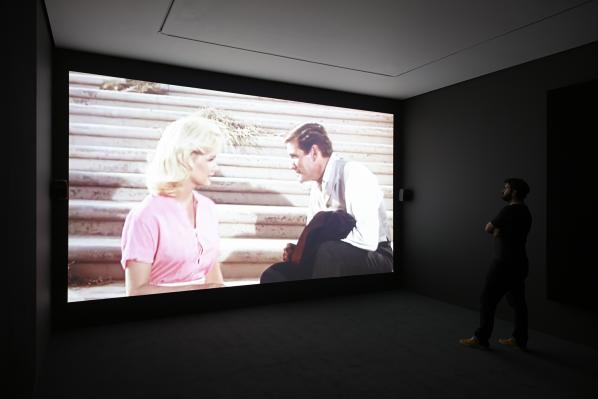
In an essay written especially for the exhibition, David Auerbach foregrounds Thomson and Craighead’s work in the overlap between “the quotidian and the global” characteristic of our hyperconnected contemporary culture. Hinged on “the tantalising impossibility of seeing the entire world at once clearly and distinctly” [1] Never Odd Or Even is an exhibition whose origins are explicitly here and everywhere, both now and anywhen. The Time Machine in Alphabetical Order (2010), a video work projected at the heart of the show, offers a compelling example of this. Transposing the 1960 film (directed by George Pal) into the alphabetical order of each word spoken, narrative time is circumvented, allowing the viewer to revel instead in the logic of the database. The dramatic arcs of individual scenes are replaced by alphabetic frames. Short staccato repetitions of the word ‘a’ or ‘you’ drive the film onwards, and with each new word comes a chance for the database to rewind. Words with greater significance such as ‘laws’, ‘life’, ‘man’ or ‘Morlocks’ cause new clusters of meaning to blossom. Scenes taut with tension and activity under a ‘normal’ viewing feel quiet, slow and tedious next to the repetitive progressions of single words propelled through alphabetic time. In the alphabetic version of the film it is scenes with a heavier focus on dialogue that stand out as pure activity, recurring again and again as the 96 minute 55 second long algorithm has its way with the audience. Regular sites of meaning become backdrop structures, thrusting forward a logic inherent in language which has no apparent bearing on narrative content. The work is reminiscent of Christian Marclay’s The Clock, also produced in 2010. A 24 hour long collage of scenes from cinema in which ‘real time’ is represented or alluded to simultaneously on screen. But whereas The Clock’s emphasis on cinema as a formal history grounds the work in narrative sequence, Thomson and Craighead’s work insists that the ground is infinitely malleable and should be called into question.
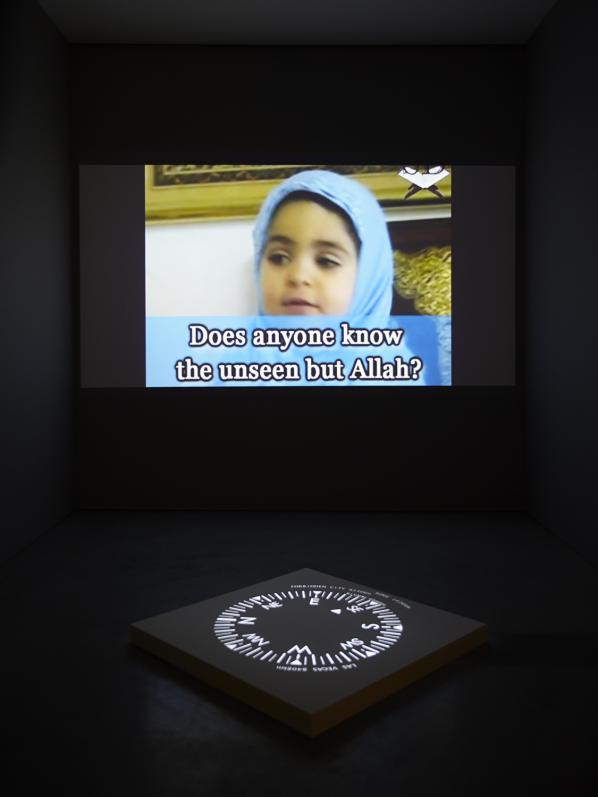
Another work, Belief (2012), depicts the human race as a vast interlinked, self-reflexive system. Its out-stretched nodes ending at webcams pointing to religious mediators, spiritual soliloquists and adamant materialists, all of them searching to define what it means to be in existence. Projected on the floor of the gallery alongside the video a compass points to the location each monologue and interview was filmed, spiralling wildly each time the footage dissolves. Each clip zooms out of a specific house, a town, a city and a continent to a blue Google Earth™ marble haloed by an opaque interface. Far from suggesting a utopian collectivity spawned by the Google machine, Belief once again highlights the mutable structures each of us formalise ourselves through. As David Auerbach suggests, the work intimates the possibility of seeing all human kind at once; a world where all beliefs are represented by the increasingly clever patterns wrought through information technology. Instead, culture, language and information technology are exposed as negligible variables in the human algorithm: the thing we share is that we all believe in something.

Never Odd Or Even features a series of works that play more explicitly with the internet, including London Wall W1W (2013), a regularly updated wall of tweets sent from within a mile of the gallery. This vision of the “quotidian” out of the “global” suffers once you realise that twitter monikers have been replaced with each tweeter’s real name. Far from rooting the ethereal tweets to ‘real’ people and their geographic vicinity the work paradoxically distances Thomson and Craighead from the very thing twitter already has in abundance: personality. In a most appropriate coincidence I found myself confronted with my own tweet, sent some weeks earlier from a nearby library. My moment of procrastination was now a heavily stylised, neutralised interjection into Carroll / Fletcher gallery. Set against a sea of thoughts about the death of Margaret Thatcher, how brilliant cannabis is, or what someone deserved for lunch I felt the opposite of integration in a work. In past instances of London Wall, including one at Furtherfield gallery, tweeters have been contacted directly, allowing them to visit their tweet in its new context. A gesture which as well as bringing to light the personal reality of twitter and tweeters no doubt created a further flux of geotagged internet traffic. Another work, shown in tandem with London Wall W1W, is More Songs of Innocence and of Experience (2012). Here the kitsch backdrop of karaoke is offered as a way to poetically engage with SPAM emails. But rather than invite me in the work felt sculptural, cold and imposing. Blowing carefully on the attached microphone evoked no response.
The perception and technical malleability of time is a central theme of the show. Both, Flipped Clock (2009), a digital wall clock reprogrammed to display alternate configurations of a liquid crystal display, and Trooper (1998), a single channel news report of a violent arrest, looped with increasing rapidity, uproot the viewer from a state of temporal nonchalance. A switch between time and synchronicity, between actual meaning and the human impetus for meaning, plays out in a multi-channel video work Several Interruptions (2009). A series of disparate videos, no doubt gleaned from YouTube, show people holding their breath underwater. Facial expressions blossom from calm to palpable terror as each series of underwater portraits are held in synchrony. As the divers all finally pull up for breath the sequence switches.
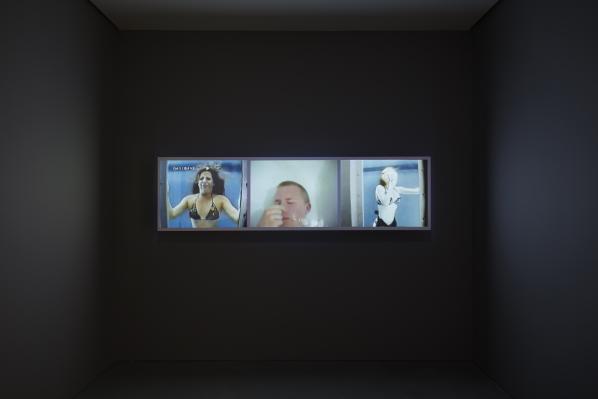
According to David Auerbach, and with echoes from Thomson and Craighead themselves, Never Odd Or Even offers a series of Oulipo inspired experiments, realised with constrained technical, rather than literary, techniques. For my own reading I was drawn to the figure of The Time Traveller, caused so splendidly to judder through time over and over again, whilst never having to repeat the self-same word twice. Mid-way through H.G.Wells’ original novel the protagonist stumbles into a crumbling museum. Sweeping the dust off abandoned relics he ponders his machine’s ability to hasten their decay. It is at this point that the Time Traveller has a revelation. The museum entombs the history of his own future: an ocean of artefacts whose potential to speak died with the civilisation that created them. [2] In Thomson and Craighead’s work the present moment we take for granted becomes malleable in the networks their artworks play with. That moment of arising, that archaeological instant is called into question, because like the Time Traveller, the narratives we tell ourselves are worth nothing if the past and the present arising from it are capable of swapping places. Thomson and Craighead’s work, like the digital present it converses with, begins now, and then again now, and then again now. The arche of our networked society erupting as the simulation of a present that has always already slipped into the past. Of course, as my meditation on The Time Traveller and archaeology suggests, this state of constant renewal is something that art as a form of communication has always been intimately intertwined with. What I was fascinated to read in the works of Never Odd Or Even was a suggestion that the kind of world we are invested in right now is one which, perhaps for the first time, begs us to simulate it anew.
Unmanned mobile devices, better known as drones, are one of the most significant ‘dark technologies’ of the 2010’s, and proceeds to reconfigure sociopolitical relations through the gesture of the remote gaze. Note that I say ‘mobile’, as opposed to ‘aerial’, as drones encompass unmanned land and water-based craft as well, but for our purposes, the flying eye has been the most visible technology in Baudrillard’s mediascape in terms of its use by the CIA in the Afghanistan/Pakistan and African theatres of operation.
To compound matters, the 2012 FAA Reauthorization Act has created a milieu in which estimates are that there could be 10,000 domestic drones in use by 2020 (Bennett & Rubin). Drones are going to be one of the US’s major technology growth markets, with the devices being used in geographic, aerospace, and environmental research as well as military and law enforcement uses.
From this, a strange series of cultural disconnects are emerging as drone images become Tumblr fodder as part of the ‘New Aesthetic’ art movement via James Bridle’s Dronestagram site (Bridle), and drones proliferate through sites like DIYDrones.com and even retailer Costco. What emerges is a complex cultural landscape where a burgeoning remote air force polices the globe in the name of American power, while the images generated by them elicit a perverse visual fascination amongst certain subcultures. Furthermore, only slightly domesticated versions of these technologies are now being flown by techno-enthusiasts and children. What is developing is a complex set of relations that is abstracting power, interaction, and representation.

In March of 2012, a panel of five artists, writers, and designers presented a panel at the media festival South by Southwest entitled, “The New Aesthetic: Seeing Like Digital Devices” (Bridle, et al). In this panel, they stated that the aesthetics of digital vision and representation, created through algorithmically-driven imaging and devices, including generative art, Kinects, and drones, are creating a machine aesthetic signaling a distinct step in the creation of the digital image since its emergence in the 1960’s. The panel expounded upon the aesthetics of new re-presentation technologies like 3D printing as well. Keep in mind that this panel drew with a very broad brush, including everything from algorism to computer glitch media, but what has intersected with current events are robot eyes like those of drones and their cyborg sighting mechanisms that team pattern recognition with human remote operators. This panel may have faded into obscurity if it were not for Bruce Sterling’s endnote talk foregrounding the concept (Sterling).
Bridle’s creation of the Dronestagram Tumblr foregrounds the drone’s eye view or the ‘shadow’ of the drone on the landscape, as depicted by Bridle’s Drone Shadow 002 (Bridle), which was a 1:1 scale outline of a drone’s shadow in Istanbul for the 1st Istanbul Design Biennial. Other projects that highlight the gaze from and the gazing of military drones are Trevor Paglen’s Drone Vision and Omar Fast’s film, Five Thousand Feet is the Best, which tells a fictionalized encounter of a Nevada-based drone operator with an interaction between a Middle Eastern family and a group of men planting an IED. Fast makes an interesting observation in the narrative, “Seeing the world from above doesn’t just flatten things, it sharpens them. It makes relationships clearer.” (Fast) Conversely, Trevor Paglen remarks on the nature of drone vision:
“What is particularly interesting to me are the ways in which ‘seeing like a drone’ is and is not like seeing through a standard bombsight: the techno-optical regime through which conventional bombing has been conducted differs from the high-resolution full-motion video feeds that inform (and misinform) the networked bombing of late modern war. Those feeds significantly compress the imaginative distance between the air and the ground, but they do so in a highly selective fashion.” (Paglen, from Gregory)
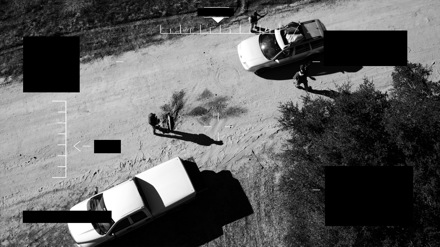
How I see the gaze of the drone is not through relief, technological regimes, or even traditional paradigms of Mulvey’s acquisitiveness of the male gaze (Mulvey), but of a Latourian network of objects (actors) in a network (Latour) that reconfigures the definition of the viewed object that the line of flight that the drone-gaze confers. In my model, the operator-node views the ‘sighted’ object through a framing of the drone camera, part of which is controlled by pattern-acquisition algorithms. What results is an augmented ‘cyborg’ sight in which the mise en scene is given the illusion of being sharpened by the technological regime of the drone’s technological systems. It is a line of flight that travels along of three nodes in a network of gaze; the operations site, the programmatic framing node of the drone-object which then redirects the gaze to the objective, transforming it from a house, person, or loved one to a target or objective. This is the problem of the cyborg gaze of the drone.
Another read of the drone gaze can be found in James Cameron’s movie, Avatar(ibid.) In it, disabled soldier Jake Sully operates a bioengineered clone of one of the native species, the Na’vi, to infiltrate their culture. While many have likened Avatar to a criticism of the Iraq and Afghanistan engagements, I posit that Jake’s avatar, is in fact a drone in biomorphic form. The difference here is not merely the optic (and haptic) immediacy of the avatar and its less destructive mission, but the avatar’s mission to win the “hearts and minds” of the native population, similar to that of the Afghanistan conflict. The drone-dream of Avatar is experience and agency without presence, although Jake does end up ‘going native’ when his human body is killed and his soul transfers into his Na’vi body. This echoes many films in which the colonizing body becomes part of the colonized demographic after spending time with them, like Dances with Wolves. It’s safe to say that a drone pilot might not want to ‘go native’ until such a biomorphic agent is invented, but Avatar problematizes the notion of remote engagement in terms of Fast’s affective gaze of the drone and its context to human relationships in addition to Cameron’s romanticization of the avatar-drone.
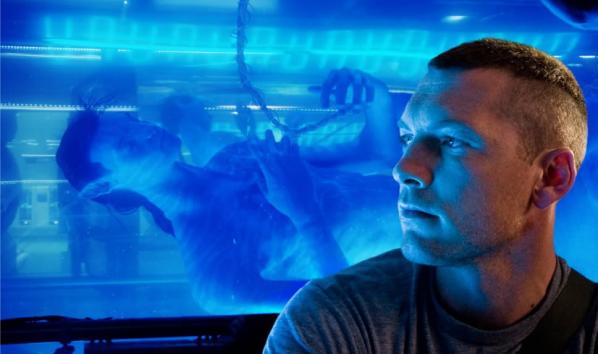
The second aspect of remote engagement that Avatar brings into focus is the lack of distinction between the technologically enabled person of disability versus the able-bodied person placed into a state of paralysis by being tied to the workstation or network-connected device. In The Third Interval, (Virilio) Paul Virilio posits this liminal (dis)abled state as an effect of the technological collapse of space through networked technology, but as Raunig states, a Deleuzian line of flight and invention appropriated by the state apparatus as a tool for the institution of war. Jake becomes freed by his cyborg existence, only to be trapped by the war machine of the corporate state until he is freed by the elimination of his techno-duality. It appears that true freedom can only come from the severance from remote control and cognitive integration with the drone itself. To experience the ontology of a drone, you must become one, not merely control it. (Bogost)
“There are eyes everywhere. No blind spot left. What shall we dream of when everything becomes visible? We’ll dream of being blind.” – Paul Virilio
Setting aside the idea of becoming drones, I want to share a cognitive dissonance that I experienced at the end of 2012. While reading descriptions of the dark spectacle of “The Light of God” (what the laser homing beam used for the Hellfire missile has been called) in the Middle East, over Christmas 2013 I was horrified to see stacks of drones for sale at the local Costco (a regional US wholesale big-box chain) in a picture posted on Facebook by scholar Richard Grusin. I had been working with devices like the ARDrone for a couple years, but to see stacks of them for holiday sale was a grim fantasy made real. It is not that, as Paul Virilio said, there are just more eyes in the panoptic First World (in addition to police cameras, phones, ATM machines and the like), but these particular eyes that are being used as extensions of state power are being sold as infantilized versions at holiday retailers. The ARDrone was the early techno-adopter’s fetish of the 2012 shopping season, military technology commodified as completely as any iPad (which it uses as a controller, by the way). As Laurie Anderson said in the film, McLuhan’s Wake, “if you want to get the job done, you‘re gonna want the latest thing…”(McLaughlin, et al), and in this case, the thing is the ARDrone. Or it could be any of the products promoted by Chris Anderson’s new project, DIYDrones.com, a start-up he left WIRED Magazine in part to create.
The connecting conversation between the military Predator and our “pet” predator (i.e. the videodrone; and there is an irony that many of our pets are predators, such as dogs, cats, and ferrets) is that I was communicating with artist Art Jones in Karachi, Pakistan who was doing an art project with the US State Department. He called it The Pakistani Playlist(), where US artists would send media and links to him in Karachi as a form of intercultural dialogue. I sent links to devices like the ARDrone and videos of children playing with these infantilized versions of military technologies that were zipping around the outer tribal lands. My aim, and Jones understood this, was that technoculture and the military-industrial complex sells a dark dichotomy between remote hunter-killers abroad and sexy flying eyes at home that one woman even asked me to use to see if her landlord had successfully removed the bird nest from her rafters. How can something so fun and useful, because it’s little more than a radio-controlled plane with a camera, be that dangerous? What’s the worst that could happen, except for perhaps having your teenage son spying on the sunbathing girl next door? As a point of note, that scenario was one illustrated briefly in a PBS documentary called The Rise of the Drones.

The cultural effect of the domesticated drone is that of banalization and aestheticization of military technology and its products that elide the stark reality that the ARDrone at the Costco is not a General Atomics Predator. The swarms of synchronized quadricopters being developed at Penn State in videos on YouTube are not seen in the context of their potential applications for the violation of personal privacy. In addition, Parrot (the maker of the ARDrone) offers tools to dynamically upload your flight videos to YouTube without vetting, and another app allows you to create snazzy dance numbers by creating aerial ballets for your drone on your iPad. Those who have always dreamt of flight, like me, can now share our dreams of flight through the social nets. Given this, drone flight logs have the potential of having the banality of funny cat videos and hipster Tumblr sites, while eliding the social issues these devices raise. What is the meaning of a domestic commons when Foucault’s panoptic vision is merely intensified by the number of Virilio’s public eyes? Is the fact that public eyes are now nearly universal, justifying the installation of more of them? And who are the operators, and what is the intent of the gaze of the domestic drone? And what of the configuration of the drone as fetishized object itself, such as Antoine Catala’s objectified drone exhibition (Kirsch) or Burt Jensen’s Orvillecopter(Netburn), the merger of taxidermied cat and quadridrone?
The emergence of the drone in all its configurations, fixed-wing, quadricopter, or rover, how they represent the detached gaze and how they are depicted in the media, call into the question the ethics of remote warfare, new forms of objectification, commodification, and aestheticization of intrusive technologies and their mediated production. The use of drone strikes by the CIA around the world, the intersection of these practices through critical artmaking sectors of The New Aesthetic and its obsession with the machine eye, as well as the proliferation of domestic drones (at least in North America) show the complexities of the cultural impact of this ‘dark’ technology. Furthermore, where technology is in one place a weapon, in another a toy, and yet in another a fetishized object brings us to a complex discursive locus where the extension of military power, McLuhanist body augmentation, and cultural production are all brought into question. Where the military-industrial complex has given technological apparatuses with multivalent uses such as the Internet, drones complicate the concept of the remote eye in ways that are in no way even close to resolution.
Opening Event: Seeds Underground Party – Sat 31 August, 2-5pm
Contact: info@furtherfield.org
Visiting Information
ABOUT THE EXHIBITION
ABOUT THE ARTWORKS
ABOUT THE ARTISTS
EVENT: SEEDS UNDERGROUND PARTY
TALK: SHU LEA CHEANG – ART, QUEER TECHNOLOGIES AND SOCIAL INTERFERENCE
LOCATION
SEE IMAGES FROM THE PRIVATE VIEW
WATCH VIDEO OF THE OPENING
This exhibition by Mark Amerika (US) and Shu Lea Cheang (US/FR) at Furtherfield Gallery marks a significant moment for contemporary art. Amerika and Cheang are both ‘net native’ artists. They share many of the obsessions of the growing multitude of artists who have grown up with the net since the early 1990s.
They are also big “names” – internationally established artists who regularly show their work, to critical acclaim, at contemporary art galleries around the world. They have crossed over into the mainstream art world whilst maintaining a critical edge.
Amerika is a media artist, novelist, and theorist of Internet and remix culture, named a “Time Magazine 100 Innovator” in their continuing series of features on the most influential artists, scientists, entertainers and philosophers into the 21st Century.
Cheang is a multimedia artist who works with net-based installation, social interface and film production. She has been a member of the Paper Tiger Television collective since 1981 and BRANDON, a project exploring issues of gender fusion and techno-body, was an early web-based artwork commissioned by the Guggenheim Museum (NY) in 1998.
Both artists continue to shape and be shaped by contemporary networked media art cultures of remix, glitch, social and environmental encounters.
Shu Lea Cheang and Mark Amerika at Furtherfield Gallery provides a physical interface in a local setting in the heart of a North London park to the thriving, international, networked art scene.
The exhibition features Cheang’s UKI viral love installation and Composting the Net. These are shown alongside pieces from The Museum of Glitch Aesthetics (MOGA), Amerika’s latest work in his collaborative series of transmedia narratives.
The exhibition features large stills from two performance installations. UKI viral love is the sequel to Cheang’s acclaimed cyberpunk movie I.K.U. (premiered at Sundance Film Festival, 2000) conceived in two parts – a viral performance and a viral game. The story is about coders dispatched by the Internet porn enterprise, GENOM Corp, to collect human orgasm data for mobile phone plug-ins and consumption. In a post-net crash era they become data deprived and these coders are suddenly dumped into an e-trashscape environment where coders, twitters, networkers are forced to scavenge from techno-waste.
![UKI – Trash Mistress [Radíe Manssour] (2009) by Shu Lea Cheang – Photo by Rocio Campana](http://www.furtherfield.org/wp-content/uploads/2013/05/radie.jpg)
In 2009, Cheang moved into the art studio at Barcelona’s Hangar medialab with 4 tons of E-trash, collected in Barcelona’s city recycling plant in one day. Amidst the rubble of wires, cables, boards, keyboards and computers, along with the coders and the hackers, UKI the defunct replicants are part of the e-trashscape seeking parts and codes to resurrect themselves.
UKI viral love is developed with collaborations and residencies at HangarBCN [artistas residentes] (Barcelona, Spain), Medialab Prado [Playlab] & [Desvisulizar] (Madrid, Spain) and, LABoral Centro de Arte y Creación Industrial [Plataforma Cero] (Gijón, Spain). The work presented at Furtherfield Gallery is the first physical installation of UKI in a gallery setting.
Composting the Net sources Internet net cultures’ accumulated data. It appropriates open (un)moderated mailing list communities, used for collaboration, sharing information and dialogue, and reprocesses the information into a virtual compost. For this exhibition Cheang composts the Spectre mailing list, a channel for practical information and exchange for media art and culture in “Deep Europe”, initiated in August 2001. The abundant info-data is reused and given extra life – an artistic legacy beyond its original purpose. It is also a celebration of the independent spirit of net culture that exists outside of corporate dominated Web 2.0 platforms such as Facebook.
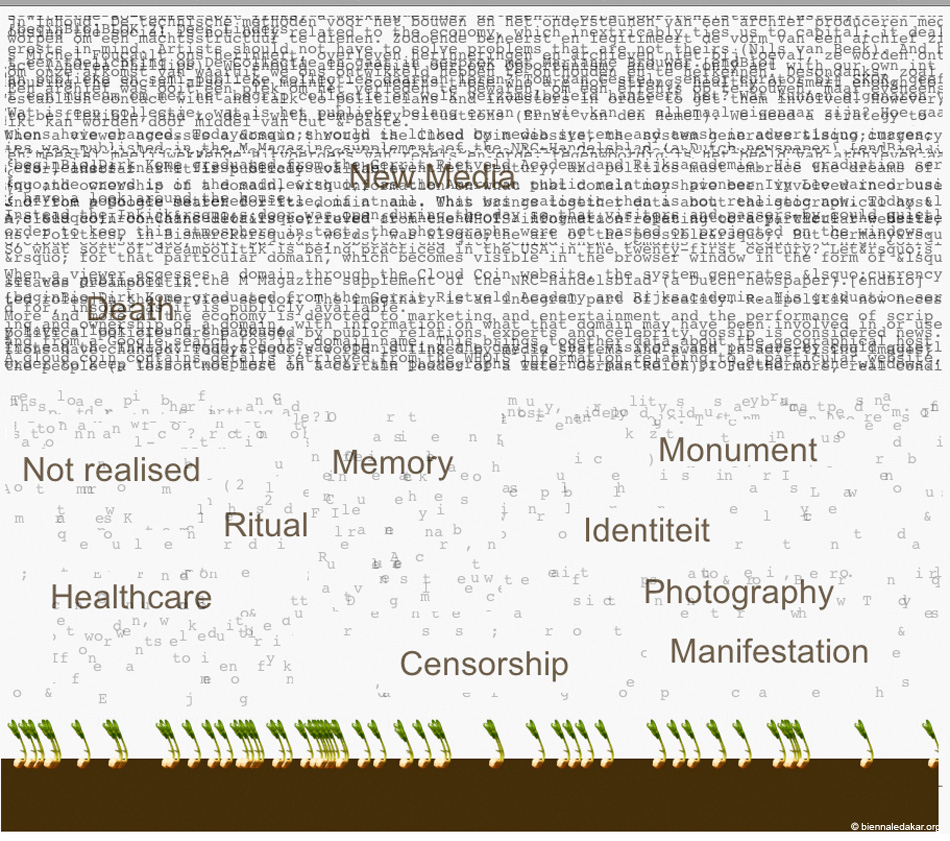
Amerika’s The Museum of Glitch Aesthetics (MOGA) features the work of The Artist 2.0, an online persona whose personal mythology and body of digital artworks are rapidly being canonized into the annals of art history. The narrative traces the life of the artist and his ongoing commitment to a practice of ‘glitch aesthetics’. MOGA features a wide array of artworks intentionally corrupted by technological processes, including net art, digital video art, digitally manipulated still images, game design, stand-up comedy, sound art, and electronic literature.
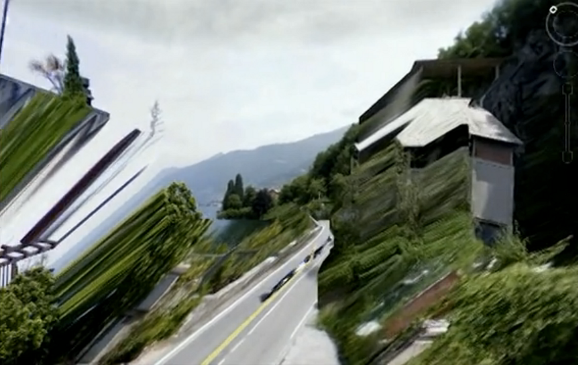
Featured in the Furtherfield Gallery exhibition are three works from the MOGA series: Lake Como Remix, The Comedy of Errors and 8-Bit Heaven.
Museum of Glitch Aesthetics was commissioned by Abandon Normal Devices for the 2012 AND Festival.

In conjunction with Shu Lea Cheang and Mark Amerika exhibition opening, Furtherfield is pleased to host Shu Lea Cheang’s Seeds Underground Party on Saturday 31 August, 2-5pm. Join us for a seed exchange party where packets of seeds change hands and go underground in the fields around Finsbury Park.
+ More information about the Seeds Underground Party.
To coincide with the exhibition, on Monday 02 September The White Building hosts a special talk by Shu Lea Cheang who will be in conversation with curator and writer Omar Kholeif.
+ More information about the Event.
Mark Amerika
Mark Amerika’s work has been exhibited internationally at venues such as the Whitney Biennial of American Art, the Denver Art Museum, the Institute of Contemporary Arts in London, and the Walker Art Center. In 2009-2010, The National Museum of Contemporary Art in Athens, Greece, hosted Amerika’s comprehensive retrospective exhibition entitled UNREALTIME. He is the author of many books including remixthebook (University of Minnesota Press, 2011) and his collection of artist writings entitled META/DATA: A Digital Poetics (The MIT Press, 2007). Amerika is a Professor of Art and Art History at the University of Colorado at Boulder and Principal Research Fellow in the Faculty of Humanities and Social Science at La Trobe University.
Shu Lea Cheang
As an artist, conceptualist, filmmaker, networker, Shu Lea Cheang (USA/France) constructs networked installation and multi-player performance in participatory impromptu mode. She drafts sci-fi narratives in her film scenario and artwork imagination. She builds social interface and open network that permits public participation. Engaged in media activism with transgressive plots for two decades (the 80s and 90s) in New York City, Cheang concluded her NYC period with the first Guggenheim Museum web art commission/collection BRANDON (1998-1999). Cheang has expanded her cross-genre-gender borderhack performative works since relocating in Eurozone in 2000. Currently situated in post-net BioNet zone, Cheang is composting the city, the net while mutating virus and hosting seeds underground parties.
Furtherfield Gallery
McKenzie Pavilion, Finsbury Park
London N4 2NQ
T: +44 (0)20 8802 2827
E: info@furtherfield.org
Furtherfield Gallery is supported by Haringey Council and Arts Council England.
This exhibition is sponsored by Rowans Tenpin Bowl, Carroll/Fletcher and Arts Catalyst.
Roger Malina is a physicist and astronomer, Executive Editor of Leonardo Publications (The M.I.T. Press), and Distinguished Chair of Arts and Technology at the University of Texas at Dallas. Dr. Malina helped found IMéRA (Institut méditerranéen de recherches avancées), a Marseille-based institution nurturing collaboration between the arts and sciences.
Mariateresa Sartori and Bryan Connell are two artists recently based at IMéRA. Their work connects with human movement through the city, and addresses the intersection between technology and perception. Recent work by Venice-based Mariateresa Sartori has encompassed drawing and video. Bryan Connell, Exhibit/Project Developer at San Francisco’s Exploratorium, works especially with landscape observation devices and mapping.
Lawrence Bird interviewed Roger Malina, Mariateresa Sartori, and Bryan Connell about the intersection of their work with the city. Images above courtesy: Roger Malina, Rita Gambardella, Bryan Connell.
Lawrence Bird: Roger Malina, in your recent writing you make the case that science is no longer just a field of positive knowledge. Scientists are increasingly open to engagement with the arts — for example artists’ residencies at CERN. You’ve even argued that we’re in a crisis of representation as profound as that of the Renaissance or the 19th century, and this is “driving a new theatricalisation of science.”
Urban life has often been understood as performative – display, performance of social roles, presentation of oneself before others are all part of the public life in cities. How would you say that crisis of representation plays out with regards to this performative dimension of urban life? How is science implicated alongside art in the city, in these conditions?
Roger Malina: One of my arguments for the ‘crisis of representation’ really looks at Renaissance systems of representation — first driven by what the eye could see, and then the eye extended by microscopes and telescopes. These systems of representation were developed that led to a deep contextualising of the viewer in the world.
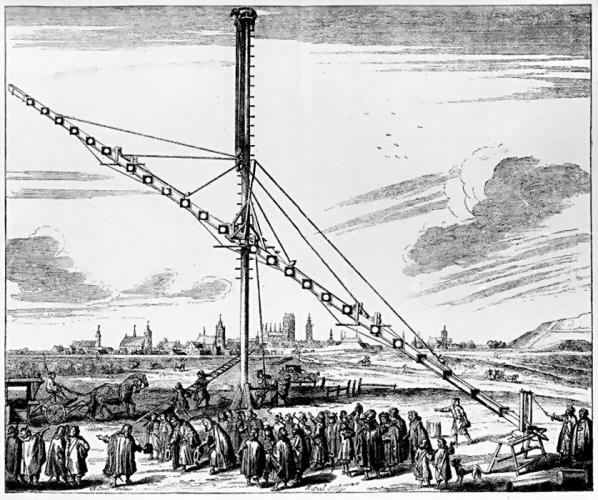
Today we are in a new situation because so much of our perception of the world comes not through extended senses but, in a real way, through new senses. This has been happening over a number of decades; the first wave of this was at the end of the 19th century when there was a cultural shock with the introduction of x-ray images, infra-red and later radio — which didn’t extend existing senses but augmented them.The most recent series of triggers maybe comes from the nano-sciences and synthetic biology — we now perceive phenomena of which we have no daily experience of (eg quantum phenomena). Field emission microsopy or MRI or some of the other new forms of imaging really don’t build on our existing experience — there are discontinuities and dislocations. Another element is of course the hand held device that leads to techniques for ‘augmented reality’ — I have a phone app that I can point at an aeroplane overhead and it tells me what the plane is, where it came from, and where it is going.
Coming to your question about the city — there is clearly a shift in map construction and reading — from the Cartesian map that we have been acculturated to. The ability to toggle between the bird’s eye view and the “street view”, and the ability to view maps that have multiple layers simultaneously are driving artists and others to develop new forms of representation.
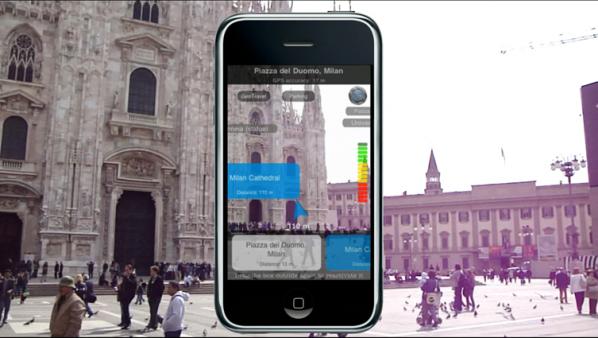
Someone whose work is interesting in this regard is Bryan Connell in San Francisco, he just finished an art science residency at IMéRA in Marseille. He was working on a large urban trail project called GR13 — 300 miles through industrial, urban, sub urban, and wild landscapes (the city had a hell of a time getting right of way through these areas). Bryan is currently working on a web site for the Marseille European City of Culture events, where he’s working on some of these questions of representation. The project involves a collective of ‘artist-walkers’ that I think fits right into this question of performativity.

LB: There’s currently a great deal of interest in the connections between representation, digital technology, and politics, for example the current Hybrid City II conference in Athens. As you’ve pointed out, these often underline the connections between what digital media mean for artists and what they can contribute to citizens — what’s emancipatory about them. What can art offer civil life in this context? Are there any conflicts or contradictions in that relationship?
RM: One pertinent example is the work of Bruno Giorgini, a physicist, and Mariateresa Sartori (visual artist) who work on the “physics of the city.” They were recently in residence in the IMéRA Mediterranean Institute of Advanced Study which hosts artists and scientists in residence who want to work with each other. We now have access to incredible amounts of data on human mobility (pedestrian and various forms of transportation) so it is now possible to study human behaviour quantitatively. Sartori discovered that she could tell many things about a person just through the morphology or topology of their movements through the city. Girogini discovered that people’s movements could be predicted at the 80% level, but 20% of the time he had to introduce what he called ‘social temperature’; in discussions he also referred to this as a ‘free will’ parameter. Barabasi has found similar results analysing cell phone GPS data of individuals. So its interesting to think of the development of cities as 80% predictable and 20% serendipitous. This of course then highlights the role of the arts and culture in making cities part of the cultural imaginary that drives people to make choices. Recently Max Schich here at the University of Texas has analysed very large data bases looking at where prominent people are born and where they die over the last 500 years. Immediately you can see how suddenly certain cities become cultural ‘attractors,’ say the way Berlin or Hong Kong are now. And of course cities are now trying to ‘design’ this into the development of cities. Here in Dallas there has been a huge investment in the ‘arts district’ and in institutions of higher learning in the belief that healthy cities require such investments. See for instance the US National Endowment for the Arts Program; there are many similar programs in Europe.
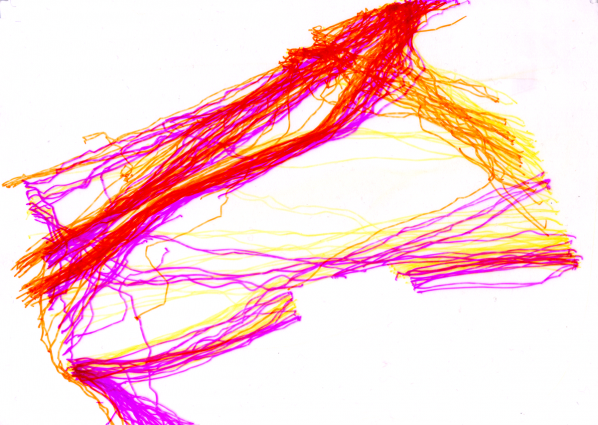
This doesn’t yet address your ’emancipation’ question. One of the things that is happening is that we are becoming a data taking culture (see the recent literature on ‘big data”). The cell phone has transformed every citizen (that has one) into a data taker. Of course much of this data is used by companies for marketing objectives. But many citizen groups are now able to take data for their social objectives. Some of this is captured by the ‘citizen science’ movement ( one example is here). There have been good examples of citizen’s taking data (on pollution, on illegal activities etc.) and then being in a position to challenge ‘authorities’ of various kinds whether scientific, political or economic (see for instance the way citizen groups have mobilised to collect data after man-made disasters such as oil spills, or illegal logging in forests).
A few years ago I wrote an open data manifesto which argued that I would like to advance a new human right and a human obligation:
1. Each of us has the right to the data that has been collected about ourselves and our own environment.
2. Each of must contribute to the knowledge construction by collecting and interpreting data about our own world.
Most scientific data collection is funded by public tax payer funding. The public has a fundamental right to all data collected and funded by public tax money.
LB: How do you imagine an artist’s training will change as these conditions evolve? And a scientist’s — could we foresee any kind of convergence?
RM: One interesting development is a cohort of hybrids, who have one degree in science or engineering and one in art and design ( for example J.F. Lapointe, a researcher at the National Research Council of Canada with degrees in molecular biology and dance) or degrees in Science or engineering and employment in art or design (like myself or Paul Fishwick, a key figure in the field of aesthetic computing). There’s been an emergence of art/science Ph. D. programs that take students from art or design or science or engineering. I suspect this cohort will grow over the coming years.
LB: Mariateresa Sartori, your IMéRA research project with Bruno Giorgini focused on mobility in the city. Can you tell us a little bit about how your work and Dr. Giorgini’s work complemented each other? What kind of evidence did you bring to the table as an artist?
MS: The project I worked on with Bruno Giorgini developed an exploration that began with earlier work in Venice. There I created a series of drawings using a rudimentary, even crude procedure: I traced out the movements of each pedestrian in the Piazza San Marco, drawing their paths with a felt-tipped pen on a transparent sheet placed over the computer monitor. I then faithfully transferred the results onto ordinary large sheets of white paper. The lines thus drawn in different directions created a space, drawing a St. Mark’s Square that is actually not there. As well as the actual physical space, it is also a drawing of our individual and collective manner of relating to space. Each single path determines the route of others, in a continuous and reciprocal game of influences that makes our collective progress.
At IMERA we developed this method for a new environment, a city more ethnically and culturally plural than Venice. Together we set up procedures and tools for collecting data about mobility networks there: nodes, links, chronotopi. These drew on the work of Bruno Giogini’s Laboratorio di Fisica della Città of the University of Bologna. We shot videos focusing on specific behavioural patterns where strategies of shifting, approaching and distancing play a decisive role; and we were also attracted by the places and situations of pedestrian congestion. Using the same technique as in Venice, I translated these into drawings of movement. These again created a space that marks out squares and places which are actually not there, each synthesizing space, time and humanity in a single image.

LB: Is there an emancipatory or governance-related dimension to this work? Degrees of mobility have human rights implications. How does your work as an artist connect with these rights, especially the notion of the right to the city?
MS: The first goal when I work as an artist observing reality is observation, i.e. a way of observing that implies a new attention. The result is always instructive because I do not have particular expectations. After lines have been traced following my process, something always emerges and what emerges can be a useful and indicative element for the emancipatory dimension of the urban condition. I would say that Bruno Giorgini is more involved in that dimension than me, especially in the notion of the right to the city.
LB: There’s a current preoccupation among researchers in a number of fields with the relationship between representation, often engaged with/through technology, and urban life. How has your latest work connected with this relationship?
MS: My way of working with technological instruments such as computers is very particular and limited. I use the computer as a technical tool strongly mediated by the senses, i.e. by human perception. I am very interested in modalities of perception: they are so imperfect, yet sufficiently perfect to make our existence possible.
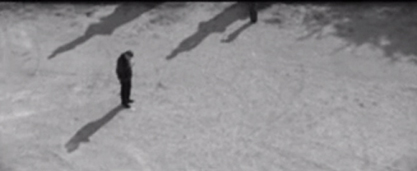
LB: You described the way you work with technological instruments as “particular and limited.” Another way to look at this is that you make the technological system slow down by inserting yourself into the process… and the result is your drawings, which still movement. Might this be one role for art — to insert the human into the machine? Much net art focuses on flows of information, virtual movement, and representing that. While not quite glitch art, do your representations of movement in some sense intentionally put a brake on the machinery?
MS: I find your words enlightening, you describe my way of working better than me….. Actually I insert myself into the technological process…..but this is not a statement of a position against technology.
I can say that what interests me the most (and art’s relation to science is just one instance of this) is the thread of connection between specific cases and general theory, between subjective and objective. Between, on the one hand, the singularity of events and, on the other, general theory. The individual’s experience is singular, unique; but there is always a thread, even if fine, that leads each individual case to a wider generalisation. What interests me is this incessant – indispensable as much as concealed – mental activity that every day leads us to search for generalisations and regulating principles. What interests me is the human tendency to comprehend phenomena, even the most complex, via schematic representation, via a generalisation that leads to the identification of organising principles. I mean “Comprehension” in very wide sense, where emotions and feelings participate too in embracing reality, including reality. Maybe in this sense I put the human in the machine…
There is a discrepancy between how we perceive reality, mediated by our senses, and the truth decreed by science. On a rational level we recognize the truth, but we cannot internalize in a deep way this knowledge; this is beyond our human capabilities. I think that in my artistic research I find myself in this deep discrepancy.
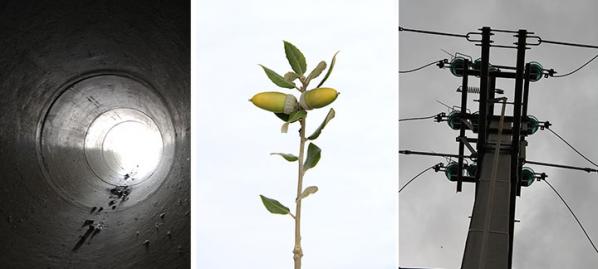
LB: Bryan Connell, your work in Marseille addresses, among other concerns, technology and its relationship to nature. Do you see the urban environment as playing any particular role in that relationship — of having a particular status in our negotiation of it?
Bryan Connell: One of the things that intrigued me about the metropolitan hiking trail in Marseille is the way it plays with our sense of meaning and value in the exploration of contemporary landscapes. Most long distance hiking trails are designed to lead out of urban environments, not into them. We don’t usually think of carrying a field guide that illustrates the taxonomy of fire hydrants, electrical pylons, or urban weeds on an extended city or suburban walk. That kind of engaged, systematic attention is usually reserved for wild natural terrains. From a traditional environmental perspective, the less altered a place is by human technology, the more scientifically interesting, ecologically exemplary, and aesthetically rich it’s going to be. Without undermining the validity of ever-present environmental concerns, the trail functions as an invitation into a more challenging and complex relationship to the emerging para-wilds and novel ecosystems that are arising at the intersection of the natural world and the technological infrastructure of the built environment.
Similarly, the Marseille trail doesn’t really focus on the kinds of urban sites that are traditionally thought of as having significant historic, architectural, or cultural interest. Instead, the trail route incites visitors into an exploration of the everyday environments and working landscapes of the contemporary urban transect – a world of parking lots, freeway overpasses, suburban developments, abandoned railways, and semi-rural wildlands.

Landscape ecologist Earl Ellis argues that to better navigate our way through the current geohistorical epoch, the Anthropocence, we must expand the traditional ecological concept of regional biomes into the parallel notion of “anthromes” – biomes that are complex interconnected melds of human technology and natural systems. In a sense, the GR 2013 Marseille trail is a sketch or system of exploratory paths into what a publically accessible, anthrome based urban ecology observatory might look like.
LB: A similar question is in relation to the image, especially sequential images. What does it mean for our negotiation of the relationship between nature and technology? Between science and art?
BC: We increasingly live in a networked digital metropolis with an image and information density that both mirrors and exceeds the high population densities of the physical metropolis. One topic of particular interest to me is the role these images play in transfiguring the quality of our desire. To what extent do scientific or aesthetic images that increase our ability to find meaning and satisfaction in observing and understanding urban landscape phenomena mitigate our need to physically alter the landscape to conform to an idealized image of what it should or shouldn’t be?
For example, the Marseille metropolitan trail didn’t require much physical alteration of the terrain – it’s a conceptually designated network of pre-existing roads, paths, streets and highways. The trail’s function is not to alter place, but alter the cognitive landscape of trail users so they have a richer sense of place. If you are fascinated by the diversity of ways a para-wild plant population has adapted to a technologically modified environment, do you need to engage in an energy and material intensive re-landscaping of that environment with a palette of conventional horticultural plantings to make it more “beautiful”? In this sense, constructing interpretive images of landscape is more than a way of augmenting a recreational hiking experience, it’s a way of shifting and re-configuring what we think we have to consume and alter to find meaning and vitality in contemporary landscapes.
http://uranus.media.uoa.gr/hc2/
Hybrid City is an international biennial event dedicated to exploring the emergent character of the city and the potential transformative shift of the urban condition, as a result of ongoing developments in information and communication technologies (ICTs) and of their integration in the urban physical context. After the successful homonymous symposium in 2011, the second edition of Hybrid City has grown into a peer reviewed conference, aiming to promote dialogue and knowledge exchange among experts drawn from academia, as well as artists, designers, researchers, advocates, stakeholders and decision makers, actively involved in addressing questions on the nature of the technologically mediated urban activity and experience.
The Hybrid City 2013 events also include an online exhibition and workshops, relevant to the theme
Hybrid City Conference 2013: Subtle rEvolutions will take place on 23-25 of May 2013.
The Hybrid City II events will take place at the central building of the National and Kapodistrian University of Athens.
This document was edited with the instant web content composer. Use the online HTML editor tools to convert the documents for your website.
Erica Scourti’s work addresses the mediation of personal and collective experience through language and technology in the net-worked regime of contemporary culture. Using autobiographical source material, as well as found text collected from the internet displaced into social space, her work explores communication, and particularly the mediated intimacy engendered by a digital paradigm.
The variable status and job of the artist is humorously fore-grounded in her work, assuming alternating between the role activist, ‘always-on’ freelancer, healer of social bonds and a self-obsessed documenter of quotidian experience.
Millions are blissfully unaware of the technological forces at work behind the scenes when we use social network platforms, mobile phones and search engines. The Web is bulging with information. What lies behind the content of the systems we use everyday are algorithms, designed to mine and sort through all the influx of diverse data. The byproduct of this mass online activity is described by marketing companies as data exhaust and seen as a deluge of passively produced data. All kinds of groups have vested interests in the collection and analysis of the this data quietly collected while users pursue their online activities and interests; with companies wanting to gain more insight into our web behaviours so that they can sell more products, government agencies observing attitudes around austerity cuts, and carrying out anti-terrorism surveillance.
Felix Stalder and Konrad Becker, editors of Deep Search: The Politics of Search Beyond Google,[1] ask whether our autonomies are at risk as we constantly adapt and tailor our interactions to the demands of surveillance and manipulation through social sorting. We consciously and unconsciously collide with the algorithm as it affects every field of human endeavour. Deep Search illuminates the politics and power play that surround the development and use of search engines.
But, what can we learn from other explorers and their own real-life adventures in a world where a battle of consciousness between human and machine is fought out daily?
Artist Erica Scourti spent months of her life in this hazy twilight zone. I was intrigued to know more about her strange adventure and the chronicling of a life within the ad-triggering keywords of the “free” Internet marketing economy.
Marc Garrett: In March 2012, you began the long Internet based, networked art project called Life in AdWords, in which you wrote and emailed a daily diary to your Gmail account and performed regular webcams where you read out to the video lists suggested keywords. These links as you say are “clusters of relevant ads, making visible the way we and our personal information are the product in the ‘free’ Internet economy.”
Firstly, what were the reasons behind what seems to be a very demanding project?
Erica Scourti: Simply put, I wanted to make visible in a literal and banal way how algorithms are being deployed by Google to translate our personal information – in this case, the private correspondence of email content – into consumer profiles, which advertisers pay to access. It’s pretty widespread knowledge by now that this data ends up refining the profile marketers have of us, hence being able to target us more effectively and efficiently; just as in Carlotta Schoolman and Richard Serra’s 1973 video TV Delivers People,[2] which argues that the function of TV is to deliver viewers to advertisers, we could say the same about at least parts of the internet; we are the commodities delivered to the advertisers, which keep the Web 2.0 economy ‘free’. The self as commodity is foregrounded in this project, a notion eerily echoed by the authors who coined the term ‘experience economy’, who are now promoting the idea of the transformation economy in which, as they gleefully state, “the customer is the product!”, whose essential desire is to be changed. The notion of transformation and self-betterment, and how it relates to female experience especially within our networked paradigm is something I’m really interested in.
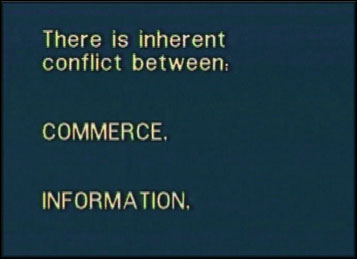
As Eli Pariser has pointed out with his notion of filter bubbles, the increasingly personalised web employs algorithms to invisibly edit what we see, so that our Google searches and Facebook news feeds reflect back what we are already interested in, creating a kind of solipsistic feedback loop. Life in AdWords plays on this solipsism, since it’s based on me talking to myself (writing a diary), then emailing it to myself and then repeating to the mirror-like webcam a Gmail version of me. This mirror-fascination also implies a highly narcissistic aspect, which echoes the preoccupation with self-performance that the social media stage seems to engender; but narcissism is also one of the accusations often leveled at women’s mediated self-presentation in particular, despite, as Sarah Gram notes in a great piece on the selfie, [3] it being nothing less than what capital requires of them.
![Girl with a Pearl Earring and a Silver Camera. Digital mashup after Johannes Vermeer, attributed to Mitchell Grafton. c.2012. [4]](http://www.furtherfield.org/wp-content/uploads/2013/05/vermeer_selfie.jpg)
And as this project is a form of autobiography and diary-writing, it could also be seen as both narcissistic and as asserting the importance of personal experience and emotions in the construction of a humanist, unified subject. Instead, I wanted to experiment with a way of writing a life story that operated somewhere between software and self, so that, as Donna Harraway says “it is not clear who makes and who is made in the relation between human and machine”. Part of the humour of the project arises from the dissonance between the staged realism of the webcam (and my real cat/ hangover/ bad hair) with the syntactically awkward, machinic language, which undermines any notion that this diary is the expression of any authentic subject.
The demanding aspect of it is something I was interested in too, since it calls up the notion of endurance as a virtue, and therefore as a value-enhancer, which many artworks – from mind-boggingly labour intensive supercut-style videos to sculptures made from millions of pins (or whatever) – trade on. You just can’t help but ask ‘wow…how long did that take?!’ – as if the time, labour and effort, i.e. the endurance, necessarily confer value. So there is a parallel between a certain kind of ‘age of austerity’ rhetoric that valorises resilience and endurance and artworks that trade on a similar kind of doggedness – like Life in AdWords does.
And finally – it made me laugh. Some of the text was so dumb, and funny, it amused me to think of these algorithms dutifully labouring away to come up with key-phrases like ‘Yo Mamma jokes’ and ‘weird pants’.
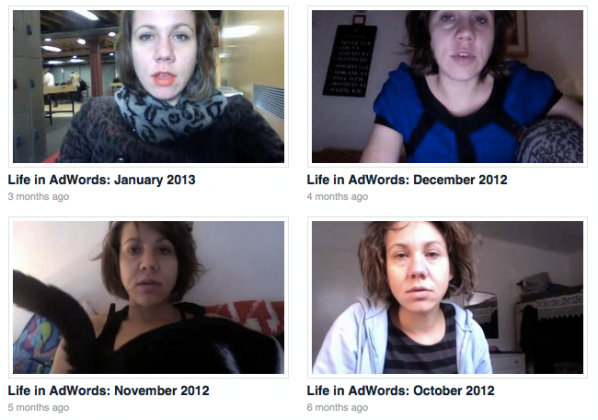
MG: It ran until 20th January 2013, and ended due to system changes in the Gmail ad settings. How many videos did you produce and were you glad when it all had finally ended?
ES: Not sure how many I made – but I was 6 weeks short of the intended year, so definitely over 300. Actually I was infuriated and somewhat depressed when it ended without warning and in a moment of panic I even thought about somehow cheating it out to the end; but working with a system that is beyond your control (i.e. Google) necessarily involves handing over some of your authorial agency. So instead I embraced the unexpected ending and threw a kind of send-off party plus performance in my bedroom/ studio to mark it.
But this question of agency is obviously crucial in the discussion of technology and runs through the project in various ways, beyond its unintended termination. At the level of the overall structure, it involves following a simple instruction (to write and process the diaries every day and do the webcam recording) which could be seen as the enactment of a procedure that echoes the operation of a software program carrying out automated scripts. And on the level of the texts, while all the language used in the project was generated and created by the software, I also was exercising a certain amount of control over which sections of the diary I favoured and editing the resulting lists, a move which seemingly reasserts my own authorial agency.
Thus the texts are more composed and manipulated than they first appear, but of course the viewer has no way of knowing what was edited out and why; they have to take it on faith that the texts they hear are the ‘real’ ones for that diary.
MG: During this period you recorded daily interactions of the ongoing experience onto webcam. As you went through the process of viewing the constant Google algorithms, I am wondering what kind of effect it had on your state of mind as you directly experienced thousands of different brands being promoted whilst handing over the content once again, verbally to the live camera?
ES: I’m not sure what effect it had on my state of mind, though considering the amount of concerned friends that got in touch after viewing the videos, Google certainly thought I was mostly stressed, anxious and depressed. Maybe it’s just easier to market things to a negative mind state.
But also, the recurrence of these terms was no coincidence; early film theorist Tom Gunning has argued that Charlie Chaplin’s bodily movement in Modern Times [5] ‘makes it clear that the modern body is one subject to nervous breakdown when the efficiency demanded of it fails,’ and compares his jerky, mechanical gestures with the machines of his era.
So I was interested in if and how you could do something similar for the contemporary body; how can we envisage it and its efficiency failures in relation to the technology of today when our machines are opaque and unreadable, if we can see them at all. Maybe what they ‘look like’ is code (a type of language), so it would entail some kind of breakdown communicated through language rather than bodily gestures – though the deadpan delivery certainly evokes a machinic ‘computer says no’ type of affectlessness.
Also, Franco Berardi has spoken of the super-speedy fatigued denizen of today’s infoworld, for whom “acceleration is the beginning of panic and panic is the beginning of depression”. In a sense this recurrent theme of stress and anxiety disavows the idea of the efficient, ever-ready, always-on subject of neo-liberalism – and yet the project as a whole kind of sneakily joins the club too, since it obeys the imperative of productivity by turning a diary (personal life, non-work) into a ‘project’ (i.e. work).
As mentioned earlier in terms of the ‘transformation economy’, I’m really interested in this idea of efficiency also as it manifests in rhetorics of self-betterment, and its relation to the neo-liberal promotion of self-responsibility (if you’re poor, it’s your fault….). Diaries and journal writing – as well as meditation, yoga, therapy, self-help etc – are often championed in everything from cognitive fitness to management literature as excellent ways of becoming more ‘efficient’. The underlying belief seems to be that by unloading all the crap that weighs you down, from emotional blockages to unhelpful romantic attachments to an overly-busy mind, you’d get an ‘optimised you’. Why this is necessarily a good thing – apart from the elusive promise of ‘happiness’ of course – is never really discussed.
Tiqquun’s notion of the Young Girl, the model consumer-citizen, is interesting in this regard – taking good care of oneself reframed as a form of subservience which maintains the value and usefulness of our bodies and minds to capital. Their idea that the Young Girl (not actually a gendered concept in their estimation) “advances like a living engine, directed by, and directing herself toward the Spectacle” also points to the irony beneath what appears to be a very humanist/ individualist inflection to these discourses of self-realisation: they could also be read as a latent desire to become somehow more ‘machine-like’, as if we could therapise/ meditate/ journal/ jog away our mind-junk with the swiftness and ease of emptying the computer’s trash, thereby becoming more productive.
And yet I’m clearly complicit in this, as I write diaries, meditate, do yoga and obsess over my bad time management, as Life in AdWords makes clear both in the recurrence of all these activities in the texts and obviously in its structure as a daily journal project.
MG: Robert Jackson in his article Algorithms and Control discusses in his conclusion that even though “use of dominant representations to control and exploit the energies of a population is, of course, nothing new”, when masses of people respond and say yes to this “particular reduced/reductive version of reality”, as an act of investment it “is the first step in a loss of autonomy and an abdication of what I would posit is a human obligation to retain a higher degree of idiosyncratic self-developed world-view.” Alex Galloway also explores this issue in his book Protocol: How Control Exists after Decentralization, where he argues that the Internet is riddled with controls and that what Foucault termed as “political technologies” as well as his concepts around biopower and biopolitics are significant.
Life in AdWords, seems to express the above contexts with a personal approach on the matter. Drawing upon an artistic narrative as the audience views your gradual decline into boredom and feelings of banality. The viewer can relate to these conditions and perhaps ask themselves similar questions as they go through the similar experiences. Thus, through performance and a play on personal sacrifice on a human level, it elucidates the frustrations on the constant, noise and domination of these protocols and algorithms and how they may effect our behaviours.
With this in mind, what have you learnt from your own experience, and how do you see others regaining some form of conscious independence from this state of sublimation?
ES: I found Galloways’ explanation of Foucault’s notions of biopower to be some of the most interesting parts of that book – as he puts it “demographics and user statistics are more important than real names and real identities”, so it’s not ‘you’ according to your Amazon purchase history, but more ‘you’ according to Amazon’s ‘suggestions’ (often scarily accurate in my experience). Which is where the algorithms come in; they do the number-crunching to be able to predict what you might buy, and hence who you are, not because anyone cares about you particularly, but because where you fit in a demographic (a person who is interested in art, technology, etc..) is useful information and creates new possibilities for control.
Regaining conscious independence… hmm. I found it interesting that during the project, the people I explained it to would often report back to me on what keywords their emails had produced, and what adverts came up on Facebook, as they hadn’t really noticed before – so perhaps in these cases it made people more conscious of the exchange taking place in the ‘free’ web economy. Others took up AdBlocker in response, which is one way of gaining distance – by opting out. However, the info each of us generates is still useful, since even if you aren’t seeing the ads, your choices and interactions are still being parsed and thus help delineate a particular user group of citizen-consumers.
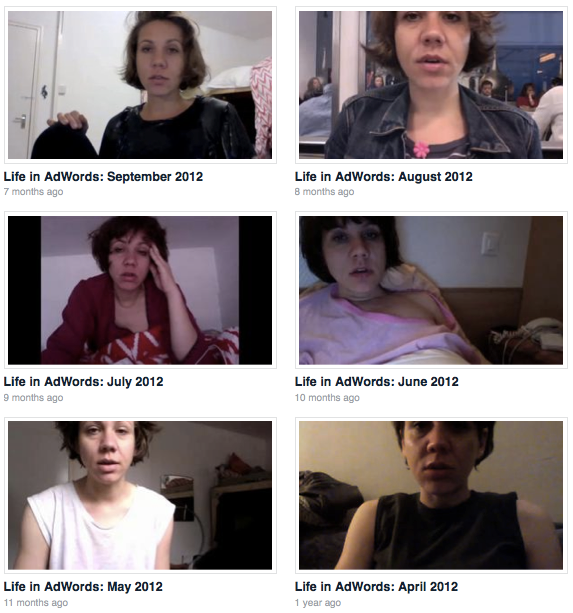
Despite this, my feeling is that opting out – if it’s even possible – can be a way of pretending none of this stuff is happening. I’m generally more interested in finding ways of working with the logic of the system, in this case the use of algorithms to sell things back to us, and making it overly obvious or visible. Geert Lovink asked whether its possible for artists to adopt an “amoral position and see control as an environment one can navigate through instead of merely condemn it as a tool in the hands of authorities” and his suggestion of using Google to do the ‘work’ of dissemination for you, in spreading your meme/ word/ image, is one I’ve thought about, particularly in other works (especially Woman Nature Alone). This approach entails hijacking the process by which Google’s algorithms organise the hierarchy of visibility to one’s own ends – a ‘natural language’ hack, as Lovink puts it.
In contrast, Life in AdWords makes visible the working of the algorithmic system more on the level of the language it produces. It also employs humour, and laughter has been one of the main responses people have had when watching the videos, for a number of reasons. The frequent dumbness of the language and/ or the juxtapositions (‘Where is God?’, ‘Eating Disorder Program’); the flattening out of all difference between objects/ feelings/ places (e.g. work-related stress, cat food, God, Krakow); and the lack of shame the software exhibits in enumerating bodily and mental malfunctions (blood in poop, wet bed, fear of vomiting) are all quite amusing in and of themselves.
That shameless aspect also echoes the over-sharing and ‘too much information’ tendencies the web (especially social media) seems to encourage, which Rob Horning has written about in his excellent blog, Marginal Utility. It also foregrounds that whatever the algorithms can do, what they still can’t do is emulate the codes of behaviour governing human interaction – including knowing when to shut up about your ‘issues’.
The frequent allusions to these bodily and mental blockages also point to the limits of the productivity imperative – a refusal to perform enacted through minor breakdowns – while bringing it back to an embodied subject, who despite her immersion in networked space is still a body with messy, inefficient feelings, needs and urges. And the comically limited portrait the keywords paint maybe suggests that despite the best efforts of Web 2.0 companies, we still are not quite reducible to a list of consumer preferences and lifestyles.
MG: What are you up to at the monment?
ES: Amongst other things I’m doing a residency with Field Broadcast (artists Rebecca Birch and Rob Smith) called Domestic Pursuits, a project which ‘considers the domestic contexts of broadcast reception and the infrastructure that enables its transmission.’
And I’m working on some drawings plus a video involving Skype meditation with members of the Insight Timer meditation app community, for A Small Hiccup, curated by George Vasey and opening 24th May at Grand Union, Birmingham- the video is being shown online tommorrow.
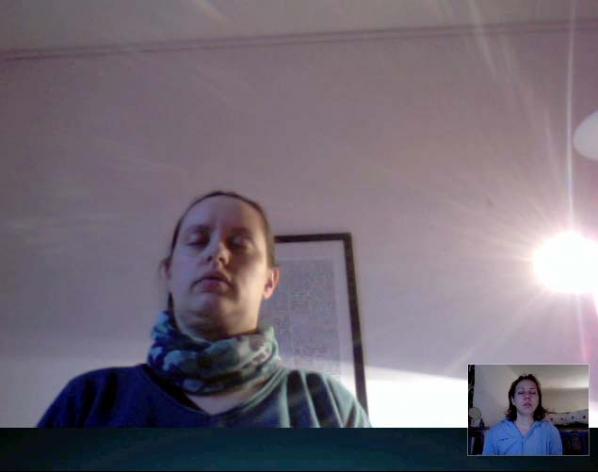
Also I’m attempting and mostly failing at the moment to write my dissertation for the MRes in Moving Image Art I’m doing at Central St Martins and LUX.
Personal Web searching in the age of semantic capitalism: Diagnosing the mechanisms of personalisation. Martin Feuz, Matthew Fuller, and Felix Stalder.
http://firstmonday.org/article/view/3344/2766
Live Performance. KONRAD BECKER (aka Monoton) featuring SELA 3 themes from “OPERATIONS” (15 min.). Published on Jul 9, 2012. YouTube.
http://www.youtube.com/watch?v=HMscYTAF4wY
Erica Scourti was born in Athens, Greece in 1980 and now lives in London. After a year studying Chemistry at UCL, an art and fashion foundation and a year of Fine Art Textiles at Goldsmiths, she completed her BA in Fine Art at Middlesex University in 2003 and is currently enrolled on a Research degree (Masters) in Moving Image Art at Central Saint Martin’s College of Art & Design, run in conjunction with LUX. Her area of research is the figure of the female fool in performative video works.
She works with video, drawing and text, and her work has been screened internationally at museums like the Museo Reine Sofia, Kunstmuseum Bonn and Jeu de Paume Museum, as well as festivals such as the Recontres Internationales, interfilm Berlin, ZEBRA Film Festival, Antimatter, Impakt, MediaArt Friesland, 700IS as well as extensively in the UK, where she won Best Video at Radical Reels Film Competition; recent screenings include Video Salon Art Prize, Exeter Phoenix, Bureau Gallery, Tyneside Cinema and Sheffield Fringe Festival.
Her work has also been published in anthologies of moving image work like Best of Purescreen (vols 1, 2 and 3) and The Centre of Attention Biannual magazine.
more info – http://www.ericascourti.com/art_pages/biography.html
Creativeworks London PhD in Residence at Furtherfield
Download a pdf of the research here
Furtherfield believe that through creative and critical engagement with practices in art and technology people are inspired and enabled to become active co-creators of their cultures and societies.
VisitorsStudio, first developed in 2003 with artist programmer Neil Jenkins, is multi-media co-creation software which aims to work towards Furtherfield’s wider goals by providing a site for real-time collaborative creation, dialogue, polemic and networked performance and play.
A new 3 month residency project at Furtherfield in partnership with Creativeworks London has invited Alex Reynolds, an AHRC funded PhD student from Kingston University, to help conceptually redesign VisitorsStudio according to contemporary developments in software and changes in social interaction and exchange associated with ubiquitous mobile technologies; and to inform the rebuild of the site as a Free and Open Source project.
The project, entitled ‘Reviewing and Open-Sourcing VisitorsStudio’ will principally involve analysing other projects similar to VisitorsStudio and consulting with its users to help identify new features for design and interaction which could help productively rethink the online creation space. The project will also mean considering ways VisitorsStudio can most effectively provoke artistic engagement with contemporary social and cultural questions.
Through her research, Alex will be working to rethink the design and functionality of VisitorsStudio and will be producing ideas for a possible new site model by the end of the project in mid-June 2013.
Your opinions are important to this project! If you would like to offer your ideas about how we can best redesign VisitorsStudio for 2013 please feel free to get in touch by emailing Alex at alexandra.reynolds@kingston.ac.uk.
http://www.visitorsstudio.org
http://www.creativeworkslondon.org.uk/cw-news/phd-in-residence-round-one-awards/
http://fada.kingston.ac.uk/research/degrees/research_students.php
Some have proposed Jennifer Chan to be part of what has been termed as the post-internet era. But, this is an inadequate representation of the spirit, criticality and adventure at play in her work. Chan’s awareness and use of the Internet reflects a way of life, that situates its networks as a primary resource. Chan lives amongst various worlds and engages in different shades of being; a self-described ‘amateur cultural critic’, a net artist, a media artist, and academic. Her work exists both online and in physical realms, it is always present and contemporary. This is because her work lives in a world where the scripting of official art definitions loses its power. People have exploited technology to facilitate new behaviours where the artist or art amateur redefine what art is on their own terms. We are now in a post-art context. It reflects a very real, societal shift. Mainstream art culture no longer owns the consciousness of art, Chan and others like her are pulling it apart.
Marc Garrett: In your video Interpassivity a kind of docu-performance made for the exhibition REALCORE, you’re in a park spraying a brown cardboard box, silver. As you go through the process of walking around the box whilst spraying it, you comment on the object’s formal aspects. But, what you mainly discuss are your own personal views about contemporary art. It then becomes apparent that the box is a prop for the performance, enabling the subject to be explored.
Alongside your interpretations of the work my own thoughts on the subject feel as though they are included in the conversation. I know as a viewer, that the artist is not aware of my thoughts on the matter. However, it feels like there is space for me to be a part of the conversation. Not literally through a feedback system or interaction, but as an individual considering your personal questions. The artwork knows I am experiencing it, it knows that a consciousness out there is somehow engaging with its dialogue.
It is clear you are in tune with the feeling of dysfunction. You say, “I need to spit out some creative truth”. On hearing this, I was not sure whether this was a parady, irony or an expression of despair, or all these. You also say “contemporary art is removed from our everyday feelings”. As you express these words I begin the view the box as a symbol of contemporary art as a centralized, institutional monolith? So, before I unwittingly place my own meanings onto the work could you tell us what it means to you?
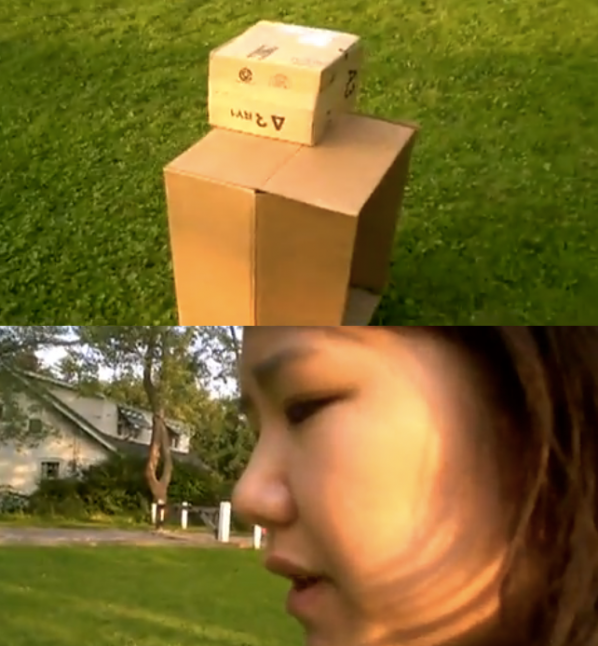
Jennifer Chan: Interpassivity is the instance of something cueing an audience to feel a certain way, such as canned laughter to stand in for humoured social reaction to jokes in a sitcom– even when it’s not funny. I titled it that because I felt like another art student trying to convince herself or the viewer what she made is art. I feel embarrassed about this self-aware but privileged complaining. A few people have found this work online and screened it, but I’m still mortified to watch it with them.
I made that video because I think a lot of contemporary art is sterile, mannered and removed from emotion. I wasn’t thinking of Donald Judd at that point but I could see the box standing in as a poor attempt at work, like his work. What I was working on (or seven years of art education) had little to do with what was happening in my life. (So to answer your question, yes, it is despair) Using my flipcam and talking over it was immediate for recording those ideas. It’s also a big trope of Canadian video art… a breathy voiceover conveys something serious and personal.
re: REALCORE. The title came about as a play on the idea of “real life”, or face-to-face life away from keyboard. Likewise, users would say “irl”(in real life), or “so real~” in Facebook comment threads to joke about the divide between online/offline contexts. The curator David Hanes felt the video was important to contextualize my use of sincerity and clichés, I was not being ironic in my intention. Arielle Gavin and Jaakko Pallasvuo thought it was questionably ironic and an emotive perspective on the Internet as a form of new sincerity.
I later found that someone wrote a paper by someone who coined “realcore” as a kind of amateur user-generated porn, which is a cool double-meaning. The “interpassivity” video was used to promote the show online but I showed my kitschy found footage videos on twisted pizza box plinths for the show. This was my fuck-you to geometric minimalism and boring white plinths, but I suppose it resulted in a different take of it…
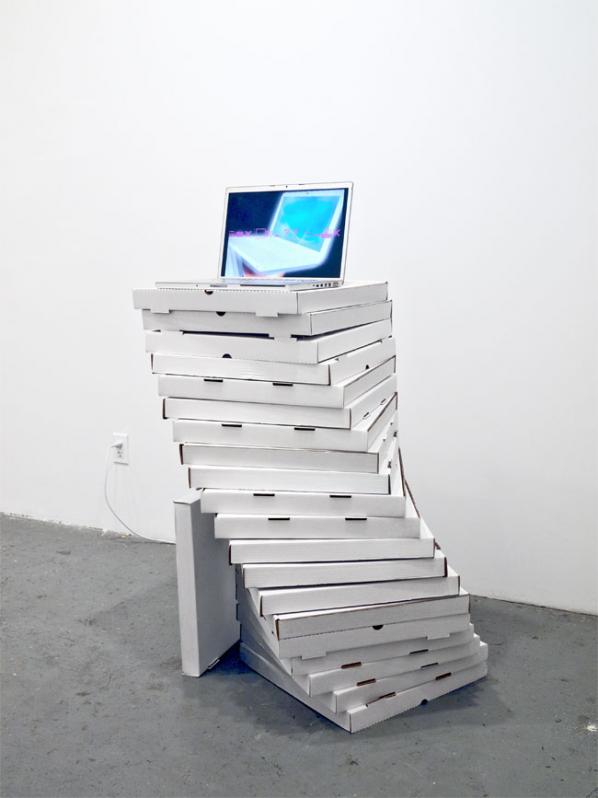
MG: In one of your recent videos “Grey Matter” when watching it felt like I was immediately pulled into a remixed world of teenage celebrity, products and brands, dripping in an orgasmic noise of techno-capitalism. Most of it is found footage, images, video and sound remixed into an edited compilation. Running through the video in between the high octane fuelled cuts and glitches, are messages to the Internet user who chances upon the video. These messages feel like they are from an individual voice but also of a multitude – caught up in a constant state of mediated folk hedonism.
What intentions lie behind this work as an artistic explorer of the entertainment culture you have remixed?
JC: Grey Matter is a first person account on feeling politically inactive online while having access to a wealth of information. I wanted to use remix in a confessional manner, so I combined obscure nostalgic media with embarrassing statements. The video begins with sped up footage of early 3D simulator ride called “Millennium Bug”. Y2K was the first technological “crisis” I recalled with clarity when I was growing up. The rest of the video includes cynical commentary on online spaces I’ve engaged with in the past year. (shopping on aliexpress.com and lurking people on OkCupid) “Little Prince” is compressed 25 times and sped up by 400%. I included old profile pics and some summary text from my OkCupid profile–I thought it was quite telling about how I wanted to be seen online and irl. I think it’s possible to feel mutually exclusive feelings at the same time, or maybe the experience of being active on different social networks produces a kind of schizophrenia. Collaging Internet pop culture is a way to appreciate it-as artifacts-in a complex light, and to be critical of it by acting out within its language.
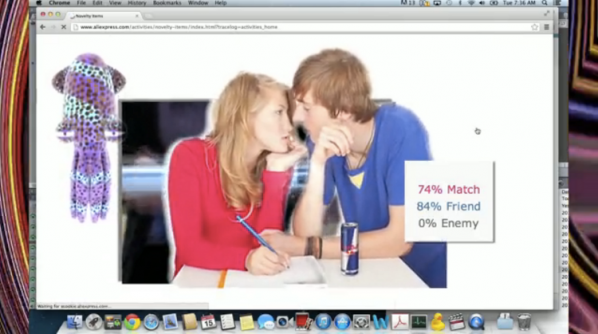
MG: What do you find fascinating about popular culture on the Internet?
JC: Anything minuscule has the potential to be popular amongst disparate users and they form vernaculars to talk about their interest in that. I find that desire relatable. That is what I think of as “community” online. It’s based on human interest and media fandom. Justin Bieber is made into something of a scapegoat for the first world’s shortcomings; people who like his image/music idolize him, and people who hate him are waiting for him to crack. Both are forms of fanaticism (one based on affinity; the other on hate-watching something.) Supercuts of Justin Bieber hairflips, object crushing fetishists, disease forums, long threads debating a detail…etc. I like the solipsism and intensity of all that.
MG: Can you share with us some of your critical insights and personal pleasures on this subject?
JC: Pop culture is paradoxical and audiences selectively enjoy it. (like teens dancing to hip hop with irreverence to its violent or sexist content.) Consuming and sampling pop allows people to indulge into its meanings, and through this there is a reconsideration of what “the masses” find important. Like the use of “users”, “masses” is what cultural studies calls everyone or everyone except-you. But every “user” has a specific relationship with interfaces and platforms, so they aren’t so homogenous.
Pop culture is also political. There was a time when more people voted for American Idol than the US elections, and if 10,000 people showed up to the 2012 cat video festival, entertainment is generally more seductive than current affairs–until there is a gatekeeping emergency (like mainstream media not covering the early days of Occupy). In terms of “internet pop culture”, perhaps traffic with social networking has overtaken porn and gambling online, but social news is also a kind of entertainment.

MG: Olia Lialina and Dragan Espenschied in their book Digital Folklore they celebrate everyday people’s use of personal computers with “glittering star backgrounds, photos of cute kittens and rainbow gradients”. They value the non-professionalism and amateur spirit that has come about from millions of people enjoying the Internet since it started. There is a difference now, the Internet masses have been shifted and prodded into large web 2.0 frameworks such as Facebook, and an abundance of personal web projects have been lost since.
And, like them do you find reassurance or a personal connection with the Internet Amateurs of the world?
JC: In context of new media art, it’s probably more accurate to think of amateurs as people who don’t self-identify as artists or technicians. What non-artists do with software and video appears facile, sincere, and intuitive. I make amateur-looking work to dialogue with that.. I like to say something dumb to say something serious. Something that’s made simplistically and filled with kitschy references can be packaged as critique that also appeals to non-art audiences.
I caught the tail end of the homepage-o-sphere/webring 1.0 period. Non-artists made personal websites out of a genuine interest in something. tumblr and pinterest is used in a same way today–to collect indiscriminately. Like 2.0 frameworks, the early internet also had free webpage hosting that users relied on (Geocities and Lycos). Personal website design isn’t over either; net artists still make them or bind together to create their own sites (like tightartists.com). I think I have an idea of what you mean though; it was less commercial and there weren’t as many distinct “most-visited” places online.
I made a lot of gothy dark art on DeviantArt before I knew about contemporary art, and my sensibility towards Photoshop was more romantic and impulsive without the baggage of art education. Maybe this “revival” cult of amateur-looking digital folklore happened because I/we exoticize that kind of amateur production. Web vernaculars have also become stylized and this aesthetic is shared with seapunks and filmmakers. Artists need to adapt to that.
MG: What do you feel is still alive and open for everyday online expression and play, in respect of what Lialina and Espenschied perceive as Digital Folklore?
JC: I think a lot of emerging artists have a greater awareness of obsolescence and upgrade culture than we give them credit for–while still complacent to the socialization structures on Facebook. Many seem more interested in navigating these networks to question their inner control mechanisms than overthrowing them or innovating new ones. It can be simple things like friending as many users as possible, looping webcam feeds, archiving and re-uploading banned content on different platforms, having an anonymous/alternate personas/using multiple accounts…etc. People like glitchr and Ian Aleksander Adams are always looking for ways to use a system against its intended functions in the same way jodi did all the cheat moves in max payne CHEATS ONLY. I admire glitch practices for that.
There’s also the possibility for re-appropriating anything to rebrand or critique particular communities. I think Angela Washko and Jaakko Pallasvuo are doing this in a compelling way that covers a large territory between art and Internet culture.
MG: So, what are you working on at the moment?
JC: <–for some reason this sounds less perverted than if I were an old guy doing this to teen girls but its really just as perverse–>
I’m observing what young adult/teen boys do on YouTube: bulking up, performing dares, talking about how to pick up a White/Asian girls etc. I’m also making a video about Asian guys (both diasporic, Asian American, and more specifically, Korean and Taiwanese men) and their interpretations of mediated masculinity. There is something disturbingly tantalizing in terms of how they have learned to look at the webcam as if they are boy band stars yet they are not fully grown men. A lot of this is informed by growing up in Hong Kong, and knowing that fashion and romance, is inspired by many “neighbouring” cultural media from Japan, Korea and Taiwan even though American/British influence is also prominent in the club scene.
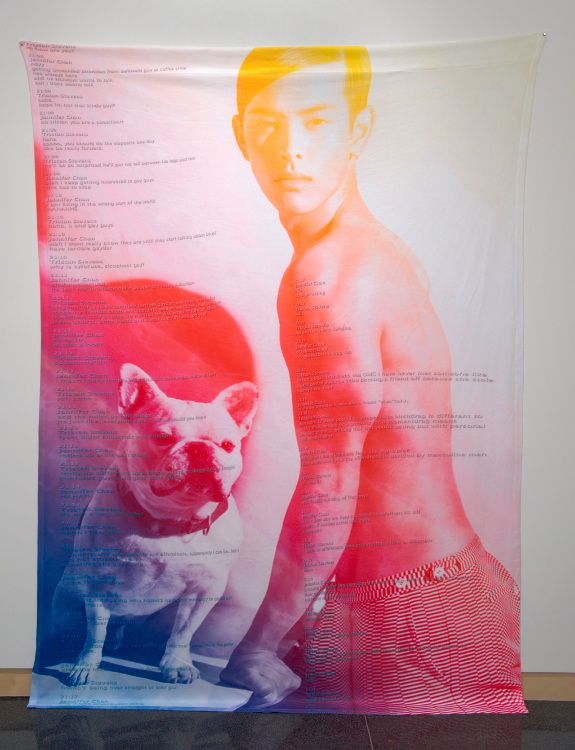
Here are two images from my late installation that will foreshadow this interest. It’s chat text over layered on modified fashion and makeup adverts targeted at Korean and Chinese men, and printed onto micro-fibred bedding. I feel like they’re treated as pleasant freak shows on tumblr but this imagery is a banal, idealized kind of masculinity in Asia. I think western facial features are really common amongst these popular images of Asian-ness, and most would tend to read it as aspiring to western culture, though the hyperfemme “doll” look or metro-masculinity has been a regional style since the 90s.
Chan’s work reflects an emerging condition described by Zizek as “interpassivity” in which our engagement with interactive experience has lost traction and is replaced with “its shadowy and much more uncanny supplement/double “interpassivity””[1], a “Fetish between structure and humanism”[ibid]. We are pulled into a paradox, where ‘interaction and passivity’ are joined together as spectacle of constant mediation. Millions have joined online centralized, megastructures such as Facebook, and this is not a black and white situation. Many are coerced from social and consumer pressures into the state of being seen as interacting. As the futuristic time machine streams onwards at high-speed, agency slouches into a spurious and distant dream. Others and the same are enjoying the flow for the sake of self expression within these scripted frameworks.
Chan’s work critiques, plays with, and exploits this networked, social intervention, as well as her viewers’ desires. Her imaginative palette revivifies questions about agency, passivity, sexuality, privacy, individuality, behaviour, networked consumption and its production. These remixed artworks have much material to work with, as the endless ether of everyday noise is uploaded and distributed through blogs and social networking sites; then returned into the ether as cut-ups where a transforming culture is engaged in its own mutation.
Its noise engages us whether we enjoy it or not, in the medium of “interpassivity”, and we all find ourselves caught within this spectacular enticement driven by the Netopticon. “On a holiday trip, it is quite common to feel a superego compulsion to enjoy, one “must have fun” — one feels guilty if one doesn’t enjoy it.”[ibid]
Jennifer Chan – http://www.jennifer-chan.com/
Heavy MetaVernacular video after the popularization of the internet
http://jennifer-chan.com/index.php?/curatorial/heavy-meta/
SELF-LOVE A non-consensual exhibition of emerging net art
http://jennifer-chan.com/index.php?/curatorial/self-love/
New Insularity Peer backpatting. A screening of works by friends and users whose works I admire.
http://jennifer-chan.com/newinsularity.html
Feeling VideoThe affective appeal of antisocial video
http://jennifer-chan.com/index.php?/curatorial/feeling-video/
Trivial Pursuits Distracting “new media art”
http://jennifer-chan.com/index.php?/curatorial/trivial-pursuits/
MOVABLE BORDERS: THE REPOSITION MATRIX workshop
organised by Dave Young
Saturday 18 May 2013, 1-5pm
BOOKING ESSENTIAL. Please register with Alessandra.
The devices that once populated the creepy dystopian futures of science fiction have broken through into our daily reality.
Drones of dozens of different types are becoming a part of everyday life. They scout our public (and private) spaces, carrying out surveillance or reconnaissance in the service of nation states and as unmanned robotic tools, armed with missiles and bombs, acting in defence of “national security”.
According to a European commission document drones will be commonplace in the skies within a decade. There are already many companies building these airborne, robotic spies for military and police use and this has “prompted concerns from civil liberties groups, who fear that the unmanned aircraft will result in more forms of surveillance.” [1]
During the three weeks of Movable Borders: Here Come the Drones! people are invited to view artworks and join a workshop by artists who are contemplating how drones are changing the way we see and relate to each other and the world around us.
Artworks and projects by Bureau of Inverse Technology (US & AU), Lawrence Bird (US), Patrick Lichty (US), Dave Miller & Gavin Stewart (UK), The Force of Freedom (NL) and Dave Young (NL).
Bit Plane by Bureau of Inverse Technology (Natalie Jeremijenko and Kate Rich) is an early artistic reflection on the relation between technology and surveillance and, as such it can be seen as a precursor to the emerging DIY surveillance video enabled by the new availability of drones. The bit plane is a radio-controlled model airplane, designed by the Bureau and equipped with a micro-video camera and transmitter. In 1997 it was launched on a series of sorties over the Silicon Valley to capture an aerial rendering. Guided by the live control-view video feed from
the plane, the pilot on the ground was able to steer the unit deep into the glittering heartlands of the Information Age.
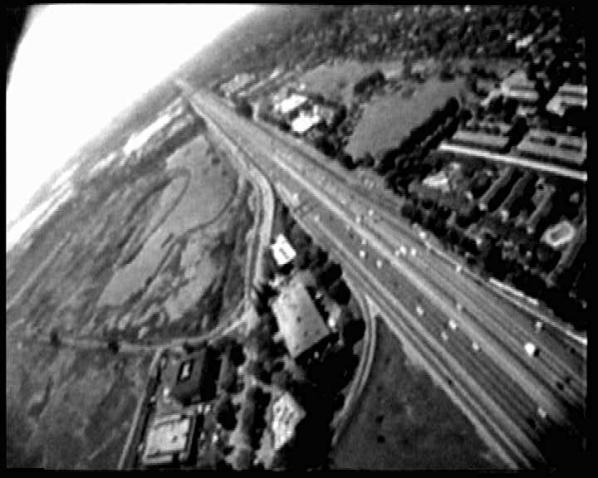
Parallel by Lawrence Bird uses Google Earth to track the 49th parallel, i.e. the prairie border between Canada and the United States. The digital projection invites open interpretations: it is a film about parallel countries; parallel modes of imaging and imagining; parallels between political, technical and visual territories. Obvious digital anomalies in the video, caused by satellite interference, allow for further speculation and imaginative readings.
The Private Life of a Drone by Patrick Lichty is a video travelogue recorded by flying video drones, exploring the area surrounding the Virginia Center for the Creative Arts in Amherst, Virginia (US).
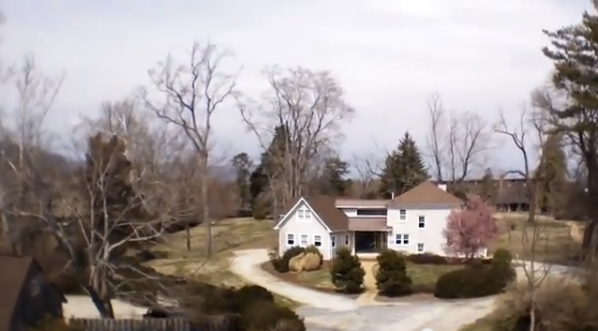
Lines by Dave Miller and Gavin Stewart draws on an emergent cultural interest in drones to explore related issues around privacy, mediation, power, security, morality, legality and others in all aspects of contemporary life. Lines aims to encourage and affect public debate.
TELEWAR is a book and video collaboration between Dave Young and The Force Of Freedom collective. The project tries to make some sense of the uses, effects and developments of the new warfare technologies, like military drones, through the analysis of news reports, military drone culture, drone speak and network theory.
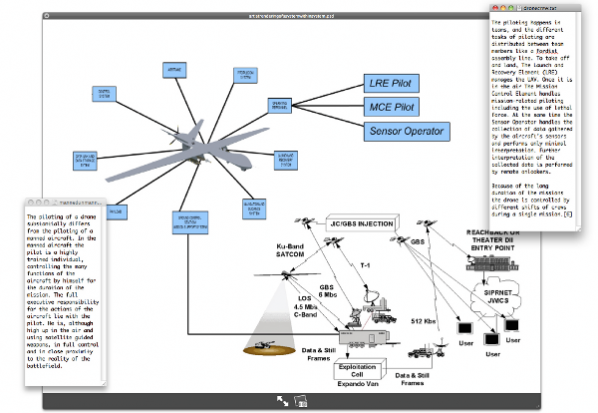
Movable Borders – The Reposition Matrix by Dave Young provides the central installation and information resource of the exhibition.
In a post-national age, where “territorial and political boundaries are increasingly permeable”[2], what has become of the borderline? How is it defined, and what technologies are used to control it?
Movable Borders is an ongoing research project that begins to explore possible answers to these questions through facilitating discussions around the ‘reterritorialisation’ of the borderline in the information age.
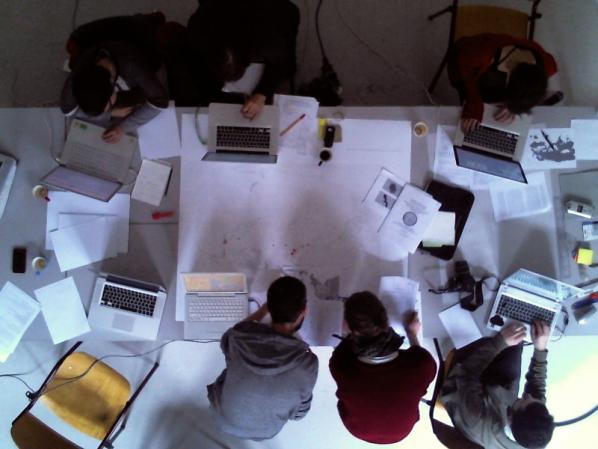
The Reposition Matrix aims to reterritorialise the drone as a physical, industrially-produced technology of war through the creation of an open-access database: a ‘reposition matrix’ that geopolitically situates the organisations, locations, and trading networks that play a role in the production of military drone technologies.
Alongside the installation Dave Young will be holding a workshop on the subject of drones on Saturday 18 May, 1-5pm – BOOKING ESSENTIAL. More info here.
Lawrence Bird
Lawrence Bird is a designer, instructor and writer with an interest in cities and their image. He has trained in architecture (B.Arch), social sciences and urban design (MSc), and history and theory of architecture (PhD). He has recently completed the SSHRC-funded postdoctoral project Beyond the Desert of the Real, based in Winnipeg, Canada. The project focused on desolate urban sites, elicited visual narratives from city residents and graduate students of architecture in response to them, experimented with representations of the city based on these narratives, and used these strategies as points of departure for urban design and urban landscape proposals. Lawrence also makes films, and is currently developing a hybrid film and animation project WPG_POV.
Bureau of Inverse Technology
The Bureau of Inverse Technology (aka BIT) is an organisation of artist-engineers whose stated aim is to be an information agency servicing the “Information Age”. Bureau engineers are involved from design to deployment and documentation of radical products based on commercially available electronic entertainment components such as cameras, radios, networks, robots, sensors, etc. Though its work has long been publicly available, the composition of the Bureau itself is shrouded in some mystery, for some years cloaking its identity in anonymity. In 2004 the Bureau initiated a “retreat from anonymity” when radio journalist and BIT co-founder Kate Rich took up a three month Research Fellowship at Piet Zwart Institute for Media Design Research, Rotterdam in 2004. Current Bureau products include BIT Radio, Feral Robotic Dogs and the Despondency Index.
Patrick Lichty
is a technologically-based conceptual artist, writer, independent curator, animator for the activist group The Yes Men, and Executive Editor of Intelligent Agent Magazine. He began showing technological media art in 1989, and deals with works and writing that explore the social relations between us and media. Venues in which Lichty has been involved with solo and collaborative works include the Whitney & Turin Biennials, Maribor Triennial, Performa Performance Biennial, Ars Electronica, and the International Symposium on the Electronic Arts (ISEA). Patrick also works extensively with virtual worlds, including Second Life, and his work, both solo and with his performance art group Second Front, has been featured in Flash Art, Eikon Milan and ArtNews. He is also an Assistant Professor of Interactive Arts & Media at Columbia College Chicago, and resides in Baton Rouge, LA.
Dave Miller
Dave Miller is a South London based artist and currently a Research Fellow in Augmented Reality at the University of Bedfordshire. Through his art practice Dave draws out the invisible forces that make life difficult. His work is about caring and being angry as an artist. His art enables him to express feelings about the world, to attempt to explain things in a meaningful, yet subjective way, and make complex information accessible. Recurrent themes in his work are: human stories, injustices, contentious issues and campaigning. Recently he has been very bothered by the financial crisis.
Gavin Stewart
Gavin Stewart is Lecturer in Digital Media at the University of Bedfordshire, poet and writer. He is the current convener of the Interactive Media Group. His research interests are the aesthetics of digital texts and the impact of corporate digital media on our understanding of community. Gavin is course leader in BA Media Production and currently teaches units in Media and Cyberculture and Print, Culture and Technology at MA Level. Gavin is is also the co-organiser of the Playful Paradox mini-festival, the End of Journalism conference and the Under the Mask: Perspective on the Gamer conference series.
The Force Of Freedom
The Force Of Freedom is a Rotterdam based collective founded by Micha Prinsen and Roel Roscam Abbing in 2009. In their work they react critically but playfully to new emerging technologies and developments on the internet.
Dave Young
Dave Young is an artist, musician and researcher currently studying the Networked Media course at the Piet Zwart Institute in Rotterdam (NL). His research deals with the Cold War history of networked culture, exploring the emergence of cybernetic theory as an ideology of the information age and the influence of military technologies on popular culture.
Furtherfield Gallery
McKenzie Pavilion, Finsbury Park
London N4 2NQ
T: +44 (0)20 8802 2827
E: info@furtherfield.org
Furtherfield Gallery is supported by Haringey Council and Arts Council England.
Drake Music launches a making day to inspire the creation of more accessible musical instruments.
On Sunday 21 April Drake Music will run a hackday to create and share new instruments that break down disabling barriers to music making. Run in partnership with Furtherfield and Music Hackspace, makers will have the opportunity to work towards one of two prizes for the most innovative work.
Hacking To Make Music Accessible Day is part of Drake Music’s new R&D programme, which aims to:
As of January 2013, there are only 6 widely available solutions for accessible music making. In contrast an orchestra is made up of at least 19 instrument types; rock and pop frequently use 4 or more types; and the instruments used in world, electronic, jazz and folk music add up to a rich and diverse pallet of choice for most aspiring musicians. This disparity needs to be bridged, in particular with the development of more expressive musical instruments for those facing barriers to music making.

Hacking To Make Music Accessible is developed with and supported by Music Hackspace and Furtherfield. This event is also a precursor to a series of projects and initiatives which will be hosted at the WeShare Lab later this year.
“I have been bowled over by the enthusiasm and seriousness of the hacking community when faced with the question of how we can create and develop new tools to make music making accessible. This event is the first of many, and allows us to collaborate with the widest range of talent in creating the most innovative tools for a sector that desperately needs them. “ – Gawain Hewitt
For further information please contact Gawain Hewitt, Drake Music Associate Musician and Associate National Manager – Research and Development.
Drake Music breaks down disabling barriers to music through innovative approaches to making, learning and teaching music. Now in its 25th year, Drake Music continues to play a pioneering role in the development and imaginative use of Assistive Music Technology (AMT) to make music accessible. Drake Music is the only organisation in England specialising in the use of AMT to break down (physical/societal) barriers to participation.
Our focus is on nurturing creativity through exploring music and technology in imaginative ways. We put quality music making at the heart of everything we do, connecting disabled and non-disabled people locally, nationally and internationally. Drake Music is an Arts Council NPO.
The London Music Hackspace originated as a subgroup of the London Hackspace as a place to share thoughts, knowledge, technologies, processes and aesthetics on music and audio. We foster innovation by gathering skilled professionals and facilitating exchanges between disciplines, from software development to music installations and production. The Music Hackspace organises weekly events, including presentations and talks by artists and musicians, workshops, performances and unexpected collaborations. Music Hackspace are member of London Hackspace.
Drake Music and Furtherfield have come together to create WeShare, a new initiative building on the combined creative assets, specialisms and strengths of both our organisations. In a series of projects in the first phase of WeShare, supported by an organisational development grant from Arts Council England, we tested and piloted new ways of working and collaborating through projects such as Pecha Kucha Beta and Deconstructing Pecha Kucha. This year will see the launch of the WeShare Lab, which will support and host events similar to Hacking to Make Music Accessible.
WeShare has emerged from three years of successful partnership-working between Drake Music and Furtherfield who share a critical and creative engagement with art, music and technology with a focus on participation and collaboration. It aims to amplify the existing quality, reach and value of our organisations’ work, finding new ways to share knowledge, ideas, resources and opportunities; creating new ways of producing and sustaining socially engaged art and culture.
Furtherfield Gallery
McKenzie Pavilion, Finsbury Park
London N4 2NQ
T: +44 (0)20 8802 2827
E: info@furtherfield.org
Furtherfield Gallery is supported by Haringey Council and Arts Council England
Featured image: Journey to Ard al Amal (The Land of Hope). Screenshot box & video installation. Impakt festival & exhibition. Image Pieter Kers
Foundland, Ghalia Elsrakbi (SY) and Lauren Alexander (SA), is a multi-disciplinary art and design practice based in Amsterdam. With backgrounds in graphic design, art and writing Foundland’s approach focuses on research based, critical responses to current issues. While moving around in advertising, printed matter, the Internet, and off line art spaces they dig up interesting stories about Disney, SpongeBob and defected soldiers.
Annet Dekker: Where does the name Foundland come from, or what does it mean?
Lauren Alexander: We started working together in 2009 and at the time we had worked on a project about being stateless, so Foundland seemed fitting. It is quite literally a way of thinking about how to found a land and to create a space that we could use as a platform for thinking about ideas with some kind of visual output. For us, space is related to political scenarios, and also to something virtual, online, all these different places that we inhabit.
Ghalia Elsrakbi: Foundland relates also to finding and discovering something new, looking behind something. We are very interested in speculation, we speculate about images and their meaning, in order to find something unexpected.
AD: What is your focus, what are you trying to find and tell?
LA: We want to tell stories in new ways, because by telling a story in a different way, especially related to subjects which are often seen in the media, you are offering an alternative perspective.
GE: The exhibition we just did for Impakt festival is a good example. With the installation Journey to Ard al Amal (The Land of Hope) we speculated how popular characters and animations, dubbed from Japanese to Arabic, or adapted from Walt Disney, play a valuable role in imagining heroes and villains. We were looking at a history of cartoons. This isn’t obviously political, but when seeing how cartoons are used in Syria and other places, interesting issues came up and we constructed a story that reflected on the current situation. We looked for connections between the way people see cartoon characters now and how they are embedded in childhood memories. In the end what we present is a kind of imagined picture of how things could be, maybe as an alternative to watching the news.
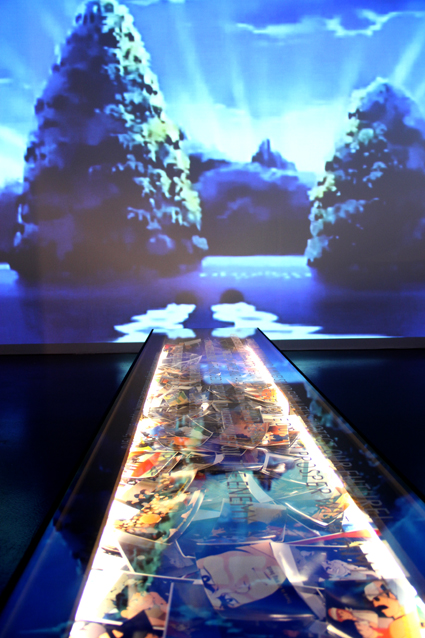
AD: Can you elaborate a bit, what images did you see and how did you (re)use them?
LA: In the installation we focused on this specific case study of the apocalypse scenario which is sketched in a cartoon series called Adnan and Leena in Arabic. In an earlier research essay Simba, the last Prince of Ba’ath country, we extracted images and characters from Arabic websites and speculate on appropriation by showing original images, before they were photoshopped. In a talk we did, we were also drawing connections to the way that Western cartoon characters are suddenly popping up in news footage, and how activists use cartoon identities on the Internet.
GE: Currently there is a full swing of the way Western stories are adapted. For example images of Mickey Mouse or SpongeBob are painted on walls in Syria. In the talk we question whether it is still Mickey Mouse that we see, the one that we remember from our children books, or if it means something else? We compared and related these images to the way such iconography is appropriated and used by both activists and ruling parties. The reuse of symbols and images and how sometimes historical moments are turned into something completely different is very interesting. Such findings are what we are really focusing on.
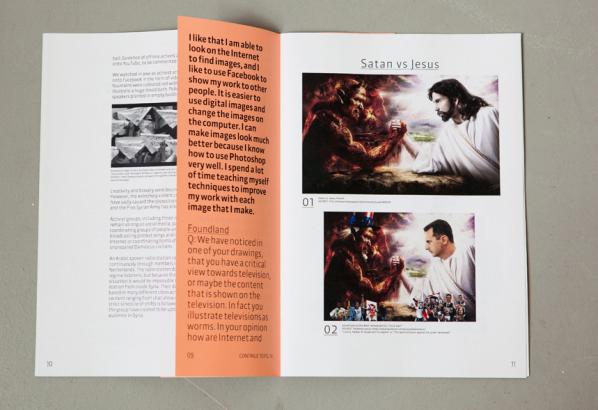
AD: There is also a long and popular tradition of autonomous animation in middle east, how does that relate to what you’ve been researching?
LA: Cartoons are very differently perceived in Syria, and also in South Africa, unlike in the Netherlands, they pose a huge threat to those in charge. For example the government is continuously suing political cartoonists like Ali Farzat in Syria and Zapiro in South Africa because their cartoons undermine existing power structures.
GE: There are indeed many artists who create political cartoons or satirical statements but with these Disney cartoons it was about finding the hidden story of an image. We recognise the cartoons from a Western perspective and the local one. By making connections and telling a different story we want to give a different perspective and a better understanding of what is really happening. Actually I grew up with Japanese Manga, but today Disney is everywhere. This is also political because in the time that Hafez Al-Assad was running Syria there was no American culture at all, when he died his son opened the country a bit for the Western market and you started to see American programmes. Nevertheless, everything is dubbed to Arabic so children don’t necessarily view it as an American production because it speaks their own language and sometimes stories and words are changed in order to better relate to Arabic countries.
LA: The connection to America is not obvious, what we found is that characters like SpongeBob and Mickey Mouse are simply friendly characters. They are your buddy, they help and like you.
GE: That is why they are used in this process of freedom fighting. ‘Your friends’ carrying the freedom flag and are used to create a kind of identification with the message that they want you to see. I mean, it is difficult to hate or not to trust these images because they are icons of friendliness. Whereas the image of a politician or some other hero who is telling a personal story can easily be damaged, a cartoon image is unbreakable. It appeals to children involved in the revolution. So, these images consist of many layers and bring up interesting questions. We aren’t looking for the true answer, because in the end we create our own story.
AD: Could you speak of a sort of universal populism or at least a continuing iconography?
GE: There are many different images, from the Lion and the Father and the Son, to things you see in public space, or images that people grew up with. These are all reused in a digital form and become part of the revolution. People tend to think of them as new images, but when you compare them to older ones, the original, it reflects very much the ideology of the regime. By putting them in a different context we try to force people to question the images and the stories.
LA: I remember that I was in South Africa when we were working on the fiction interview with a propaganda makers text and I had asked my mother to read it. She commented that ‘This is what the government used to say during apartheid, I recognize this’. I guess this shows quite a universal context. We are so used to advertisement and iconography that we don’t question it and tend to ignore the meaning.
GE: Yes, it’s not so different at all, propaganda still uses the same techniques, they have not changed and people fall for it. I think it’s very good to expose propaganda makers.
AD: What new context are you giving it?
LA: Up till now our work has been presented in a western context within the framework of festivals or art spaces.
GE: We wanted to show it to a Western audience, but now we also want to see how it will work when we go to Syria or the Middle East. This will be a challenge because we need to find a way to make that translation back again. We tried already a few times to publish texts for example, but the expectation is very different, stories are more direct and literal, you say exactly what you mean, not the way that we do it here which is reading between the lines.
AD: Is that also why you work in so many ways, from installations, to print, to presentation, to video?
LA: Yes, a lot of this is about experimentation with how things work. We often start from something that we have found online. We find a lot of information, which can be confusing, and then it is about finding the right moment, time and place to present it. Giving it all your attention to dig into an issue, know more and tell more.
GE: Each time we try to define the best way to present what we want to say. It is interesting to open and use the whole research process, it is not just about an end result that is presented. For example, now we are collecting a lot of defection movies from soldiers who are leaving the official army Syrian and joining the free army. What we notice is that the visibility of this free army is that it is only online, on YouTube. We are interested in how an identity of an army that exists on the ground and performs all kinds of operations, primarily takes place on YouTube. The videos of the defectors are almost like a physical performance of defection. We want to collect the story of it, to help people appreciate this image, why it was made, and think about what this means for us.
AD: Digging up memories and confronting people?
GE: When we started the cartoon project we noticed that people were hiding their identity online behind popular cartoon masks. It was really about how people used the Internet.
LA: We discovered that using the Internet is not always about the technical functions of connectivity, distribution, uploading and liking.
GE: If you look for example at how Syrians use the Internet, it’s really for emotional support. A few months ago there was no Internet in the whole of Syria, which was emotionally a big thing because people abroad couldn’t connect to people online and read their contributions. The revolution is nothing without these contacts. All of a sudden a Facebook campaign started called ‘Here is Damascus’. At first I didn’t understand it, but it turned out to be a reference to an event that happened in the 60’s in Cairo, while at war with Israel, the radios were cut off and there was no communication in the city. At that point the city of Damascus changed the name of their radio to ‘Cairo radio’. A political statement, like a re-enactment, happened now on Facebook. The Internet has all these different kinds of layers, of reflecting on history and bringing events to life.
See more Foundland work and updates at www.foundland.info
Featured image: Image from Fab Lab (fabrication laboratory), small-scale workshop offering digital fabrication
There is currently a significant amount of interest in the relationship between free and Open Source practices in art and the aim of this report is to map out some of these shifting relationships in contemporary models of education both online and offline. The recent expansion of so-called ‘free culture’ has contributed to placing the debate over authorship, ownership and licensing of the artwork at the centre of artistic production. Crucially, the transformation of art in the age of global culture and the consequent move from autonomous art objects into cultural artworks and services, has resulted in the emergence of three visible tendencies: 1) free/Open/Source software as artistic-pedagogical method, 2) the critical emancipation of the self-education movement and 3) the digitisation of art education practices into Open Source packages of cognitive labour.
One possible way to navigate this complex ideological terrain is the conciliatory term free/libre/Open Source software (floss), seeing it as “part of an emerging transdisciplinary field that deals with different forms of openness.” [1] At the heart of the debate is the political distinction between the Free Software Foundation[2] and the Open Source Initiative.[3] The ‘copyleft’ attitude (free software movement) asserts four freedoms for software: free from restriction, free to share and copy, free to learn and adapt, free to work with others.[4] The Open Source definition,[5] on the other hand, in spite of apparent similarities, has developed into flexible arrangements such as the Creative Commons licenses[vi][6], some of which restrict these freedoms when applied to media/cultural works and publications, not allowing for derivative artwork or its commercial use under specific license combinations.[7]
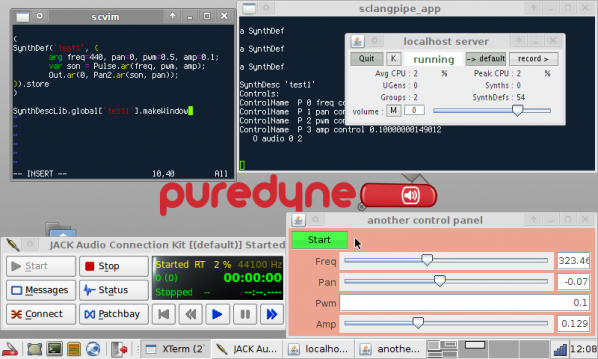
A number of projects, such as the pure:dyne[8] – GNU/Linux operating system for live audio visual processing and teaching – are, however, fully identified with the principles of free software. They have emerged from artists’ collectives whose relationship to art education is informally associated with sharing spaces, the hacklabs and free media labs where they run workshops and introduce participants to the use of free digital art tools. [9] Their mode of production is centred on ‘live code’ and feature two essential characteristics: 1) collaborative- relying on large-scale public participation and 2) distributive- offering the tools and the process notes (notation) to empower the others to carry on the work on their own.[10] This philosophy implies that the artistic performance of the work is complemented by a set of pedagogical approaches associated with the enabling of production by others. [11]

The movement for free education has gained greater relevance as a result of the global financial crisis and the battle for control of university fees.[12] In this context, art education has been developing into an artistic project while also providing an emancipatory movement reacting against dominant forms of institutionalised knowledge production. Within this movement, the role of free/open technology has been central in the mediation of self-education as a social movement.
On the one hand, artists –freelancers, sometimes temporarily/precariously plugged into educational institutions whilst working as teachers, others times as workshop facilitators in free access spaces– have opened up their classrooms to the environment of the read/write web, and with their students-collaborators, have produced and shared in wikis, blogs and Second Life, art and education resources that make an increasingly significant contribution to a larger body of knowledge that is the web. [13] Wikiversity is a model of this confluence of self-education movements and open online education.[14]
In parallel with the above-mentioned tendencies of online systems, numerous critical projects have appeared that are associated with the reclamation of space that occurs as artists have found themselves at the forefront of self-organised and self-managed self-education projects.[15] Some have happened side-by-side with the reclamation and occupation of spaces such as the Temporary School of Thought[16] and the Really Free School.[17] Part of these groups activity is the establishment of a free programme of workshops on topics that can range from free software tools to Ivan Illich and Deschooling Society.[18] Others that make opportunistic incursions into the artworld such as the Bruce High Quality Foundation University,[19] the Future Academy[20] or Unitednationsplaza,[21] are platforms for experimental art as research, investigating the production of knowledge that occurs when art education itself becomes artwork or exhibition.[22]
While the debate on free education has been enjoying significant visibility, the Higher Education sector has also joined in. A few recent initiatives have supported universities of the arts developing virtual learning environments and providing access to open education resources (OERs). This is the case with the JISC Practising Open Education Project (2010-2011)[23] with six art, design and media departments in UK universities. A number of these OERs include art work (photographs, drawings and videos), but the majority are art theory, mostly research papers, dissertations and art education research documents produced by artists-teachers-researchers as part of their continuing professional development. These are distributed with Creative Commons licenses with varying degrees of freedom, but rarely have the ‘copyleft’ attitude that has been associated with the free software.
Such an enterprise can be interpreted in the light of current debates in the fields of immaterial labour and cognitive capitalism revealing that whilst (digital) art becomes postproduction, art education is being packaged into open resources that circulate as part of the capitalist system, and become central to the new eLearning/networked economies. In addition to filling a gap in subject-specific open resources, this raises the question: why is the free and the open so popular in contemporary art education? A cynical hypothesis is that art education, by declaring itself as a type of production of knowledge, attempts to gain a new legitimacy, in the bureaucratised global knowledge market. The other possibility is that in the face of such a doomed scenario, art education searches for new possibilities beyond pure commercialism, reclaiming access through “contingencies of opening and mobility of cognitive packages beyond confines of ownership.” [24]
1. Floss as artistic –pedagogical method
The Digital Artists Handbook
The digital handbook, published by the arts organisation folly and artists’ collective GOTO10 in 2008, aims to give artists information about the available tools and the practicalities related to Free/Libre Open Source Software and Content such as collaborative development and licenses.
FLOSS+Art
This book edited by Aymeric Mansoux and Marloes de Valk in 2008 reflects critically on the growing relationship between Free Software ideology, open content and digital art. With contributions by: Fabianne Balvedi, Florian Cramer, Sher Doruff, Nancy Mauro Flude, Olga Goriunova, Dave Griffiths, Ross Harley, Martin Howse, Shahee Ilyas, Ricardo Lafuente, Ivan Monroy Lopez, Thor Magnusson, Alex McLean, Rhea Myers, Alejandra Maria Perez Nuñez, Eleonora Oreggia, oRx-qX, Julien Ottavi, Michael van Schaik, Femke Snelting, Pedro Soler, Hans Christoph Steiner, Prodromos Tsiavos, Simon Yuill. Available both in print and as torrent download
Technology Will Save Us
The project by Daniel Hirschman & Bethany Koby is a haberdashery for technology and alternative education space dedicated to helping people to produce and not just consume technology.
Openlab
Openlab Workshops was started by artist and educator Evan Raskob in mid-2009 to fulfil the need for practical education about digital art and technology. Floss workshops are developed and taught by working artists and media practitioners, giving participants direct access to practical experience.
GOTO10
GOTO10 is an artists’ collective that organises floss workshops on subjects such as Pure Data, Linux audio tools, physical computing, SuperCollider, puredyne, RFID, Audio Signal Processing, and other related areas of practice.
UpStage
UpStage is an Open Source platform for cyberformance and education: remote performers combine images, animations, audio, web cams, text and drawing in real-time for an online audience. Initiated by the globally dispersed performance troupe Avatar Body Collision, it runs the annual Upstage festival, open to proposals.
2. Self-organised and self-managed art education
Really Free School
Free school based in a squatted London pub. “Amidst the rising fees and mounting pressure for ‘success’, we value knowledge in a different currency; one that everyone can afford to trade. In this school, skills are swapped and information shared, culture cannot be bought or sold. Here is an autonomous space to find each other, to gain momentum, to cross-pollinate ideas and actions.” (Communiqué #1)
Bruce High Quality Foundation University
A free university project set up by NY-based artists’ collective The Bruce High Quality Foundation. “We believe in the artistically educational possibilities of collaboration. Collaboration, as we mean it, means a group of concerned people come together to hash out ideas, try to figure out the world around them, and try to take some agency within its future. That’s the why and how of The Bruce High Quality Foundation. BHQFU is an attempt to extend the benefits of this collaborative model to a wider number of people.”
Unitednationsplaza
A temporary, experimental school in Berlin, initiated by Anton Vidokle following the cancellation of Manifesta 6 on Cyprus, in 2006. Developed in collaboration with Boris Groys, Liam Gillick, Hatasha Sadr Haghighian, Nikolaus Hirsch, Martha Rosler, Walid Raad, Jalal Toufic and Tirdad Zolghadr, the project travelled to Mexico City (2008) and, eventually, to New York City under the name Night School (2008-2009) at the New Museum. Its program was organized around a number of public seminars, most of which are now available in their entirety online.
FOSSter creative Learning
Lesson plans that can be used in the art classroom, developed by The FOSSter Creativity Team, a group of students of the University of the Arts (USA)
3. Open Source Repositories
University of the Arts institutional OER repository
University for the Creative Arts institutional OER repository
VADS (Visual Arts Data Service) A collection of over 100,000 art and design images that are freely available and copyright cleared for use in learning, teaching and research in the UK.
OER Commons A repository of materials about teaching, technology, research in the emerging field of Open Education. Art materials at OER commons.
You can find paula’s original article on Collaboration and Freedom – The World of Free and Open Source Art http://p2pfoundation.net/World_of_Free_and_Open_Source_Art
This article is part of the Furtherfield collection commissioned by Arts Council England for Thinking Digital. 2011
Cyposium
an online symposium on cyberformance
Friday 12th October 2012
http://www.cyposium.net/
We all perform on the Internet. The social media profiles that we are contractually obliged to give our real names to are just as much performances as our World Of Warcraft or Minecraft avatars. Yet these impromptu performances of our socialised and fantasy selves lack the literary quality of drama. Not drama in the sense of a Usenet or Tumblr flamewar, but in the sense of theatre.
The 1993 New Yorker cartoon captioned “On the Internet, nobody knows you’re a dog” identifies two important features of the early public Internet. Firstly it’s a place, somewhere you can get onto. Secondly that place has limited bandwidth for establishing identity and communicating affect. This meant that the Cyberspace of the net became a site for identity play and imagined realities.
As the text-based virtual reality of MOOs gave way to the image-based Palace Chat and then three dimensional AlphaWorld the available bandwidth increased and with it the available ambiguity decreased. Describing a character or a scene or an action with a few words leaves the members of the audience much freer to exercise their own imaginations than seeing it in full motion animation with a high polygon count.
The visual, social and even economic order of virtual worlds and social media have become a more fixed and uncritical embodiment of mass media and the established social order. This has reduced their potential for alterity but it has made them useful representations both of shared reality and shared fantasy that can be used as a stage on which to perform critically, reintroducing the literay against the grain of their unreflective consumption of identity and spectacle.
Throughout this history, from the early 1990s to today, the Internet’s affordances have been used to produce dramatic performance in Cyberspace, “cyberformance”. The problem is we don’t remember this, at least not as clearly as we should. Individually, institutionally, and technologically we have lost our memories of artistically groundbreaking and important performances.
This problem is not unique to cyberformance. All digital art suffers from the decay of digital media and the creeping obsolescence of the hardware that it runs on. Internet art suffers from bitrot, software obsolescence, linkrot, the loss of web pages and sites elsewhere on the net that are connected to the work, and netrot, changes in the protocols used to distribute it.
Above and beyond those problems, cyberformance involves live perfomance. Unique events produced by historical communities at a particular moment using media that will rapidly become obsolete need to be recorded in order to be remembered or at least to be critically re-evaluated later. This creates a second layer of conservation and archiving problems.
Take the example (outside of Cyposium) of Judy Malloy’s “Brown House Kitchen”, a narrative environment created in the LambdaMOO text-based virtual reality. Despite being mentioned in surveys of virtual art in the 1990s, despite being produced with institutional support, and despite being stored on one of the longest-running textual virtual world servers the software objects that made up the work were recycled as part of the normal running of LambdaMOO and are now lost. Many other text-based virtual realities, some specifically designed for dramatic works, are not even online any more. And the protocols used to access them are old, with software to connect to them increasingly not installed by default on newer operating systems. Even those created after the Internet Archive started will not appear in it, as they are not web-based.
I mention LambdaMOO as by chance I was researching text based virtual worlds and performance in the months before Cyposium was announced. One work that was described in the literature but untraceable online was Stephen A. Schrum’s “NetSeduction”. Which Schrum presented and discussed at Cyposium. And the script of the original performance was made available through the Cyposium website. Without Cyposium, these resources would not have been made available.
These contrasting examples drive home just how badly needed Cyposium was. The Internet does enable us to digitise and experience more culture than ever before, but it also erases our memories of the culture that is native to it. And the often highly experimental nature of cyberformance makes it harder to record and remember than almost any other kind of technologically enabled art.
As well as addressing a specific need to recover the history of net performance, Cyposium is an exemplary model for a new kind of online event in the era of Massively Online Open College courses. It performs the function of a symposium or convention online, reducing barriers to access and increasing reach for institutions, speakers and audience members. The Waterwheel Tap software used for most of Cyposium allows side-channels of audience communication, which help to build a sense of place and community and allow the audience to ask (and answer) questions and share knowledge among themselves and with the speakers.
The panel discussions that Waterwheel enabled meant that old and new net performers could discuss each others work in the light of new developments or freshly reconsidered history. And we, the audience, wheoever we were and wherever we were, could watch and learn from this discussion and join in. I am often wary of the word “open”, but there was an intellectual and social generosity and inclusiveness to Cyposium that made it feel like a very open event.
A ripple of excitement went through the mailing lists I subscribe to when Cyposium was announced. Its organizers and line up promised something special, and the event itself didn’t disappoint. To be part of the audience, chatting in text alongside the live streaming video presentations, was to be part of both a welcoming ad hoc conversational community of interest and participating in a key moment in a larger historical conversation.
Cyposium went beyond recovering and presenting the history of online performance. It brought together net performers old and new in productive dialogue in front of an engaged audience and served as an example of a new kind of net native event. Now that the event itself has finished the Cyposium web site serves as an important record of an important aspect of online creativity.
This essay will appear in the forthcoming Cyposium book.
The text of this review is licenced under the Creative Commons BY-SA 3.0 Licence.
First published in Remediating the Social 2012. Editor: Simon Biggs University of Edinburgh. Pages 69-74
—-
The acceleration of technological development in contemporary society has a direct impact on our everyday lives as our behaviours and relationships are modified via our interactions with digital technology. As artists, we have adapted to the complexities of contemporary information and communication systems, initiating different forms of creative, network production. At the same time we live with and respond to concerns about anthropogenic climate change and the economic crisis. As we explore the possibilities of creative agency that digital networks and social media offer, we need to ask ourselves about the role of artists in the larger conversation. What part do we play in the evolving techno-consumerist landscape which is shown to play on our desire for intimacy and community while actually isolating us from each other. (Turkle 2011) Commercial interests control our channels of communication through their interfaces, infrastructures and contracts. As Geert Lovink says ‘We see social media further accelerating the McLifestyle, while at the same time presenting itself as a channel to relieve the tension piling up in our comfort prisons.’ (2012: 44)
Many contemporary artists who take the networks of the digital information age as their medium, work directly with the hardware, algorithms and databases of digital networks themselves and the systems of power that engage them. Inspired by network metaphors and processes, they also craft new forms of intervention, collaboration, participation and interaction (between human and other living beings, systems and machines) in the development of the meaning and aesthetics of their work. This develops in them a sensitivity or alertness to the diverse, world-forming properties of the art-tech imaginary: material, social and political. By sharing their processes and tools with artists, and audiences alike they hack and reclaim the contexts in which culture is created.
This essay draws on programmes initiated by Furtherfield, an online community, co-founded by the authors in 1997. Furtherfield also runs a public gallery and social space in the heart of Finsbury Park, North London. The authors are both artists and curators who have worked with others in networks since the mid 90s, as the Internet developed as a public space you could publish to; a platform for creation, distribution, remix, critique and resistance.
Here we outline two Furtherfield programmes in order to reflect on the ways in which collaborative networked practices are especially suited to engage these questions. Firstly the DIWO (Do It With Others) series (since 2007) of Email Art and co-curation projects that explored how de-centralised, co-creation processes in digital networks could (at once) facilitate artistic collaboration and disrupt dominant and constricting art-world systems. Secondly the Media Art Ecologies programme (since 2009) which, in the context of economic and environmental collapse, sets out to contribute to the construction of alternative infrastructures and visions of prosperity. We aim to show how collaboration and the distribution of creative capital was modeled through DIWO and underpinned the development of a series of projects, exhibitions and interventions that explore what form an ecological art might take in the network age.
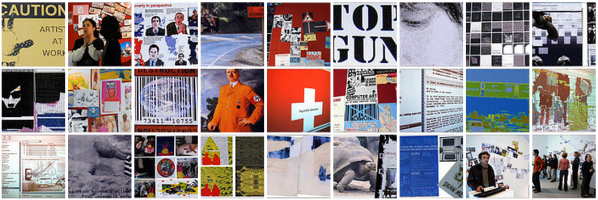
In common with many other network-aware artists the authors are both originators and participants in experimental platforms and infrastructures through processes of collaboration, participation, remix and context hacking. As artists working in network culture we work between individual, coordinated, collaborative and collective practices of expression, transmission and reception. These resonate with political and ethical questions about how people can best organise themselves now and in the future in the context of contemporary economic and environmental crisis.
Though this essay draws primarily on artistic and curatorial practices it also makes connections with the histories and theories that have informed its development: attending to the nature of co-evolving, interdependent entities (human and non-human) and conditions, for the healthy evolution and survival of our species (Bateson 1972); producing diverse (hierarchy dissolving) social ecologies that disarm systems of dominance (Bookchin 1991, 2004); and seeking new forms of prosperity, building social and community capital and resilience as an alternative to unsustainable economic growth. (Bauwens 2005) (Jackson 2009)
Furtherfield’s mission is to explore, through creative and critical engagement, practices in art and technology where people are inspired and enabled to become active co-creators of their cultures and societies. We aim to co-create critical art contexts which connect with contemporary audiences providing innovative, engaging and inclusive digital and physical spaces for appreciating and participating in practices in art, technology and social change.
The following artworks, researched, commissioned and exhibited by Furtherfield this year, offer a range of practices exemplifying this approach. A Crowded Apocalypse [1] by IOCOSE deploys crowd-sourced workers in the production of staged, one-person protests (around the world) against collectively produced, but fictional, conspiracies. This is a net art project that exploits crowd sourcing tools to simulate a global conspiracy. The work exploits the fertility of network culture as a ground for conspiracy theories which, in common with many advertisements, are persuasive but are neither ultimately provable or irrefutable (Garrett 2012).
A series of distributed performances called Make-Shift, by Helen Varley Jamieson and Paula Crutchlow, is a collective narrative about the human role in environmental stresses, developed with participants who build props for the ‘show’ using all the plastic waste they have produced that day. Makeshift is an ‘intimate networked performance that speaks about the fragile connectivity of human and ecological relationships. The performance takes place simultaneously in two separate houses that are connected through a specially designed online interface.’ [2]
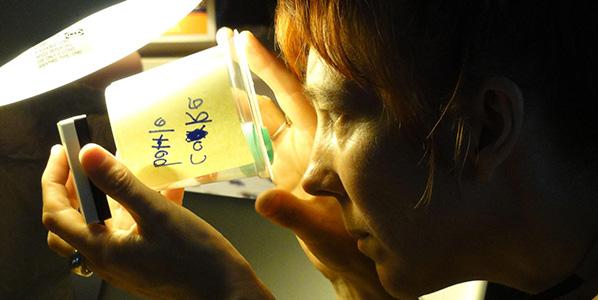
Moving Forest London 2012 [3], initiated by AKA the Castle (coordinated by Shu Lea Cheang), employs the city of London as it prepares for the grand spectacle of the 2012 Olympic Games, expanding the last 12 minutes of Kurosawa’s adaptation of Shakespeare’s Macbeth “Throne of Blood” (1957), with a prelude of 12 days, and durational performance of 6 acts in 12 hours. The Hexists (artists Rachel Baker and Kayle Brandon) perform Act 0 of this sonic performance saga, with 3 Keys – The River Oracle, a game of chance and divination [4].
Other notable works in this vein include Embroidered Digital Commons [5] by Ele Carpenter; Invisible Airs and Data Entry [6] by Yoha; Web2.0 Suicide Machine [7] by _moddr_ and Fresco Gamba; The Status Project [8] by Heath Bunting; and Tate a Tate [9], an interventionist sound work by Platform, infiltrating one of the largest art brands of the nation using a series of audio artworks distributed to passengers on Thames River boats, to protest the ongoing sponsorship of Tate Modern exhibitions by British Petroleum. Also relevant is the realm of ludic digital art practices that facilitate new socially engaged aesthetics and values such as Germination X [10] by FO.AM and Naked on Pluto [11] by Dave Griffiths, Marloes de Valk, Aymeric Mansoux.
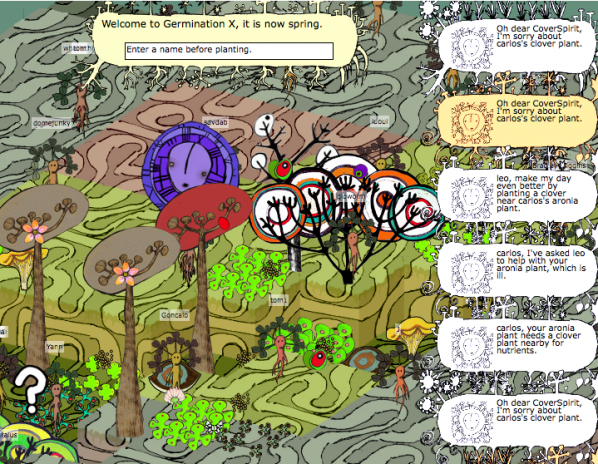
The term “DIWO (Do It With Others)” was first defined in 2006 on Furtherfield’s collaborative project Rosalind – Upstart New Media Art Lexicon (since 2004) [12]. It extended the DIY (Do It Yourself) ethos of early (self-proclaimed) ‘net art heroes’, who taught themselves to navigate the web and develop tactics that intervened in its developing cultures.
The word “art” can conjure up a vision of objects in an art gallery, showroom or museum, that can be perceived as reinforcing the values and machinations of the victors of history as leisure objects for elite entertainment, distraction and/or decoration – or the narcissistic expression of an isolated self-regarding individual. DIWO was proposed as a contemporary way of collaborating and exploiting the advantages of living in the Internet age that connected with the many art worlds that diverge from the market of commoditised objects – a network enabled art practice, drawing on everyday experience of many connected, open and distributed creative beings.
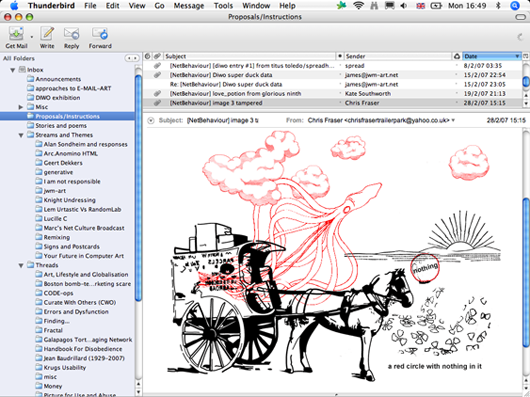
Mail box showing Netbehaviour contributions to DIWO Email Art project 2007
DIWO formed as an Email Art project with an open-call to the email list Netbehaviour, on the 1st of February 2007. In an art world largely dominated by elite, closed networks and gatekeeping curators and gallerists, Mail Art has long been used by artists to bypass curatorial restrictions for an imaginative exchange on their own terms.
Peers connect, communicate and collaborate, creating controversies, structures and a shared grass roots culture, through both digital online networks and physical environments. Strongly influenced by Mail Art projects of the 60s, 70s and 80s demonstrated by Fluxus artists’ with a common disregard for the distinctions of ‘high’ and ‘low’ art and a disdain for what they saw as the elitist gate-keeping of the ‘high’ art world…’ [13]
The co-curated exhibition of every contribution opened at the beginning of March at HTTP Gallery [14] and every post to the list, until 1st April, was considered an artwork – or part of a larger, collective artwork – for the DIWO project. Participants worked ‘across time zones and geographic and cultural distances with digital images, audio, text, code and software. They worked to create streams of art-data, art-surveillance, instructions and proposals in relay, producing multiple threads and mash-ups. (Catlow and Garrett, 2008)
‘The purpose of mail art, an activity shared by many artists throughout the world, is to establish an aesthetical communication between artists and common people in every corner of the globe, to divulge their work outside the structures of the art market and outside the traditional venues and institutions: a free communication in which words and signs, texts and colours act like instruments for a direct and immediate interaction.’ (Parmesani 1977)
So it made sense that the first DIWO project should be a mail art project that utilised email, enabled by the Internet; a public space with which anyone with access to a computer and a telephone line could use to publish. Because an email could be distributed (with attachments or links) to the inboxes of anyone subscribed to the Netbehaviour email list, subscribers’ inboxes became a distributed site of exhibition and collaborative art activity: such as correspondence, instruction, code poetry, software experiments, remote choreography, remixing and tool sharing.
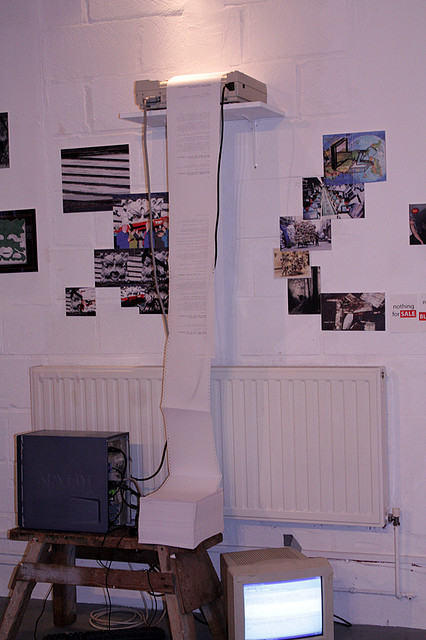
This and later DIWO projects used both email and snail-mail and (in line with the Mail Art tradition) undertook the challenge of exhibiting every contribution in a gallery setting.
The DIWO Email art project was liberally interspersed with off-topic discussions, tangents and conversational splurges, so one challenge for the co-curators was to reveal the currents of meaning and the emerging themes within the torrents of different kinds of data, processes and behaviour. Another challenge was to find a way to convey the insider’s – that is the sender’s and the recipient’s – experience of the work. These works were made with a collective recipient in mind; subscribers to the Netbehaviour mailing list. This is a diverse group of people; artists, musicians, poets, thinkers and programmers (ranging from new-comers to old-hands) with varying familiarity with and interest in different aspects of netiquette and the rules of exchange and collaboration. This is reflected in the range of approaches, interactions and content produced.
In a number of important ways the email inbox guarantees a particular kind of freedom for the DIWO art context, as distinct from the exchange facilitated by the ubiquitous sociability, ‘sharing’ and ‘friendship’ offered by contemporary social media. Facebook, Myspace, Google+, etc, provide interfaces that are designed to elicit commercially valuable meta-data from their users. They are centrally controlled, designed to attract and gather the attention of its users in one place in order to monitor, process and interpret social behaviour and feed it to advertisers. As demonstrated during the disturbances of the Summer of 2011, these social media are an extension of the Panoptican and can also become tools of state surveillance and punishment as Terry Balson discovered on being detained for 2 years after being found guilty of setting up a Facebook page in order to encourage people to riot. (BBC News, 2012)
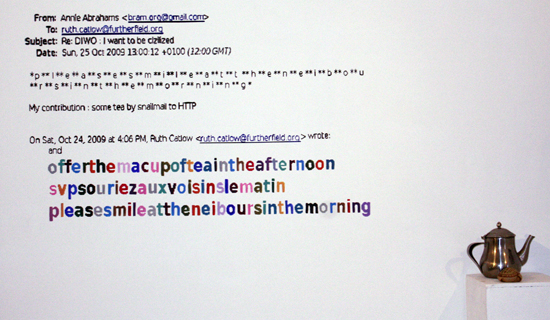
The DIWO Email Art and co-curation project is fully described and documented elsewhere [15] but it is outlined here as it gives an example of how our networked communities may intersect with everyday experience and with mainstream art worlds while also creating their own art contexts. We may be playful, critical, political and may work as possible co-creators with all the materials (stuff, ideas, processes, entities – beings and institutions – and environments) of life. This DIWO approach provides the fundamental ethos for the Furtherfield Media Art Ecologies programme.
Furtherfield’s Media Art Ecologies programme (since 2009) brings together artists and activists, thinkers and doers from a wider community, whose practices address the interrelation of technological and natural processes: beings and things, individuals and multitudes, matter and patterns. These people take an ecological approach that challenges growth economics and techno-consumerism and attends to the nature of co-evolving, interdependent entities and conditions. They activate networks (digital, social, physical) to work with ecological themes and free and open processes.
The programme has included exhibitions such as Feral Trade Café by Kate Rich and If Not You Not Me by Annie Abrahams, an art world intervention by the authors We Won’t Fly For Art and workshop programmes such as Zero Dollar Laptop workshops (in partnership with Access Space in Sheffield). It has supported research projects such as Telematic Dining by Pollie Barden and developmental artist residencies, such as Make-Shift by Helen Varley Jamieson and Paula Crutchlow.
These projects and practices have a number of things in common:
Through the Internet we all now have access to data about historic and contemporary carbon emissions. We also find visualisations of this data that provide concise and accessible graphical arguments for thinking, feeling and acting in a coordinated way at this historical moment [17] [18].
Data shows an exponential rise in global carbon emissions since the 1850s, starting with the UK. UK carbon emissions have dropped as a percentage of global emissions by region (CDIAC 2010). At the same time the quantity of carbon dioxide emitted by the UK has steadily increased since the start of the industrial revolution to annual levels now higher than 500 million tonnes (Marland, Boden and Andres 2008). This data shows how successful the UK was, during the industrial revolution, at spreading the production methods that would turn out to promote a model of sole reliance on economic growth and fossil fuels. The logic and infrastructures of capitalism are now collapsing in tandem with the environment (Jackson 2009). At the same time networked technologies and behaviours are proliferating. Social and economic transactions take place at increased speed but our existing economic and social models are unsustainable and the consequences of continuing along the current path appear catastrophic for the human species (Jackson 2009). This is a critical moment to reflect on how the technologies we invent and distribute will form our future world.
Michel Bauwens, of the Foundation for Peer to Peer Alternatives, works with a network of theorists, activists, scientists and philosophers to develop ideas and processes to move beyond the pure logic of economic growth [19]. He observes that by transposing what has been learned by sharing the production and use of immaterial goods, such as software, with strategies for developing sharing in other productive modes, the community comes to own its own innovations, rather than corporations. This puts peer production at the core of civil society. The fabrication laboratory or ‘fab lab’ system, developed at MIT in collaboration with the Grassroots Invention Group and the Center for Bits and Atoms, offers an example; a small-scale workshop that facilitates personal fabrication of objects including technology-enabled products normally associated with mass production. The lab comprises a collection of computer controlled tools that can work at different scales with various materials. Early work on the Open Source car shows how open, distributed design and manufacturing points to a possible end of patenting and built in obsolescence; constituent principles of our unsustainable consumer-based society. (Bauwens 2012)
‘[Bauwens] recognises that peer to peer production is currently dependent on capitalism (companies such as IBM invest huge percentages of their budgets into the development of Free and Open Source Software) but observes that history suggests a process whereby it might be possible to break free from this embrace. He suggests that by breaking the Free Software orthodoxy it would be possible to build a system of guild communities to support the expansion of mission oriented, benefit-driven co-ops whose innovations are only shared freely with people contributing to the commons. In the transition to intrinsically motivated, mass production of the commons, for-profit companies would pay to benefit from these innovations.’ (Catlow 2011)
A peer to peer infrastructure requires the following set of political, practical, social, ethical and cultural qualities: distribution of governance and access to the productive tools that comprise the ‘fixed’ capital of the age (e.g. computing devices); information and communication systems which allow for autonomous communication in many media (text, image, sound) between cooperating agents; software for autonomous global cooperation (wikis, blogs etc); legal infrastructure that enables the creation and protection of use value and, crucially to Bauwens’s P2P alternatives project, protects it from private appropriation; and, finally, the mass diffusion of human intellect through interaction with different ways of feeling, being, knowing and exposure to different value constellations. (Bauwens 2005)
These developments in peer to peer culture provide a backdrop to the projects presented as part of the Media Art Ecologies programme which, in turn, proposes that a focus on the networked cultures in which the work is produced, supports ecological ways of thinking, privileging attention to complex and dynamic interaction, connectedness and interplay between artist viewer/participant and distributed materials. Its projects have been developed within independent communities of artists, technologists and activists, theorists and practitioners centered around Furtherfield in London (and internationally, online), Cube Microplex in Bristol and Access Space in Sheffield. They identify the simultaneous collapse of the financial markets and the natural environment as intrinsically linked with human uses of, and relationships with, technology. They take contemporary cultural infrastructures (institutional and technical), their systems and protocols, as the materials and context for artistic production in the form of critical play, investigation and manipulation. This work, at the intersection of artistic and technical cultures, generates alternative spaces and new perspectives; alternative to those produced by (on the one hand) established ‘high’ art-world markets and institutions and (on the other) the network of ubiquitous user owned devices and social apps. These practices play within and across contemporary networks (digital, social and physical), disrupting business as usual and the embedded habits and attitudes of techno-consumerism.
We will end this essay by describing an early project developed as part of this programme, Feral Trade Café [20] by Kate Rich, an exhibition that was also a working café. Feral Trade Café served food and drink traded over social networks for 8 weeks in the Summer of 2009 and exhibited a retrospective display of Feral Trade goods alongside ingredient transit maps, video, bespoke food packaging and other artifacts from the Feral Trade network. Since 2003 participants in the project (usually travelling artists and curators) have acted as couriers, carrying edible produce around the world with them on trips they are taking anyway and delivering them to depots (friends’ and colleagues’ flats or workplaces), mostly independent art venues in Europe and North America. Rich has crafted a database through which couriers can log their journeys, tracking the details of sources, shipping and handling for all groceries in the network ‘with a micro-attention usually paid to ingredient listings’ (Catlow 2009). This database [21] is at the heart of the artwork, with special attention given to the day to day challenges and obstacles met in its distribution – tracking the on-the-fly street level tactics employed, out of necessity, by a distribution network with no staff, vehicles, storage facilities or business plan.
‘Courier Report FER-1491 DISPATCHED: 13/05/09 DELIVERED: 15/05/09 – ali jones spent a few hours trying to start a car using various techniques. eventually got it moving with a push start with the help of a stranger who was leaving behind a night of print-making.convoyed to cube where friend took parcel in her van while i parked dubious car at garage for fixing.’ [21] (Feral Trade Courier, 2009)

The café stocked and served a selection of Feral Trade products from a menu including coffee from El Salvador, hot chocolate from Mexico and sweets from Montenegro, as well as locally sourced bread, cake, vegetables and herbs. Diverse diners – local residents and long-distance lorry drivers (from Poland and Germany) – were served their food along with waybills (drawing information from the database) documenting the socially facilitated transit of goods to their plate.
The invitation to the exhibition promised visitors a convivial setting from which to “contemplate broader changes to our climate and economies, where conventional supply chains (for food delivery and cultural funding) could go belly up.” The café provided a local trading station and depot for the Feral Trade network, and a meeting place for local community food activists for research and discussion. It’s worth noting that a year later a Government Spending Review announced a cut of nearly 30% to the Arts Council of England’s budget. (BBC News 2010) Two years later global food prices were up by over 40% and set to rise another 30% in the next 10 years. (Neate 2011). A number of small new projects continue to develop from meetings between the gallery community and local community activist groups working on sustainability issues.
The materials and methods employed by this artwork, that is also a functioning café, are diverse and non-standard. The café is not scaleable and generates no jobs or surplus, let alone profit. It may build ‘social capital’, what Bordieu defines as a form of capital ‘made up of social obligations (‘connections’) which is convertible in certain conditions into economic capital and may be institutionalised in the form of a title of nobility.’ (Bordieu1986) However, it is uncertain whether this will apply to Rich as any ‘nobility’ she might acquire is undermined by her purposeful maintenance of the project’s ambiguous status as an artistic project.
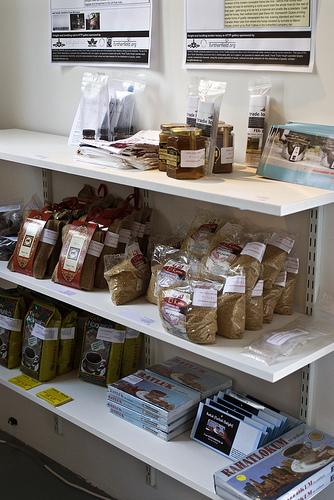
For this essay we present Feral Trade Café alongside Bauwens’ proposal for alternative P2P infrastructures. We propose that while the work is not a design, formula or practical, alternative business model (either for an artwork or a café) for mass adoption, it can be considered an ecological system for ‘mass diffusion of intellect’ (Bauwens 2005). Interaction with the project engages participants in different ways of sensing, operating and valuing the world. It is a most inefficient way of trading.
The work poses strange questions as it oscillates between artwork (sensual, expressive, rhetorical) and catering (utilitarian, literally nourishing) and to consider the meaning of our lives and vocations in local communities and a functional future society. ‘Understanding that prosperity consists in part in our capabilities to participate in the life of society demands that attention is paid to the underlying human and social resources required for this task.’ (Jackson 2009: 182) Feral Trade focuses our attention on the truly pleasurable aspects of social exchange that are lost in our quest for affluence. ‘Creating resilient social communities is particularly important in the face of economic shocks.[…] The strength of a community can make the difference between disaster and triumph in the face of economic collapse.’ (Jackson 2009: 182)
Feral Trade is both art and a lived, alternative co-created system for trading and serving food that refuses commercial exploitation, contributes meaning and strengthens bonds across an existing community. A distinctive, memorable and sensual way for people to interact, to socialise and savour the socio-political ingredients of a meal eaten while discussing strategies for avoiding ethical discomfort. Most powerfully, it is a lived critique and reinvention of a fundamental aspect of everyday life (feeding ourselves) through the subtle tactics of manipulation and play (by its many participants).
It is our contention that by engaging with these kinds of projects, the artists, viewers and participants involved become less efficient users and consumers of given informational and material domains as they turn their efforts to new playful forms of exchange. These projects make real decentralised, growth-resistant infrastructures in which alternative worlds start to be articulated and produced as participants share and exchange new knowledge and subjective experiences provoked by the work.
Conclusion – Ecological Media Art promotes participation in social ecology
Social scientist Tim Jackson has shown that the establishment of ever more efficient and productive systems of control and growth, owned by fewer, more centralised agents, is both unjust and environmentally unsustainable (2009). The reverse also applies; that the distribution of freedoms and access to sustenance, knowledge, tools, diverse experience and values improves the resilience of both our social and environmental ecologies. (Bateson 1972) (Bookchin 1991) (Jackson 2009)
Ecological media artworks turn our attention as creators, viewers and participants to connectedness and free interplay between (human and non-human) entities and conditions. It builds on the DIWO ethos. On the one hand we resist the elitist values and infrastructures of the mainstream art world and develop our own art context, on our own terms, according to the priorities of a collaborating community of creative producers (which may include diverse participants and audiences). On the other, we deal critically with the monitored and centrally deployed and controlled interfaces of corporate owned social media; wherever possible working with Free and Open Source Software to privilege commons-based peer produced artworks, tools, media and infrastructure.
Humanity needs new strategies for social and material renewal and to develop more diverse and lively ecologies of ideas, occupations and values. For this to happen more of us need to be able to freely participate more deeply in diverse artistic or poetic and technical world-forming processes and to exchange what we create and learn.
‘Those who share our ‘analysis of the contemporary political moment may also perceive a possible role for themselves in the generation of mutual commons-based interfaces for engagement that go beyond solely textual formats to arrays of performance, narrative (fact and fiction), image, sound, database, algorithm, music, theory, sculpture – to explicitly re-conceive inalienable social relations’ (Catlow 2011)[23].
Remediating the Social 2012. Editor: Simon Biggs University of Edinburgh. Published by Electronic Literature as a Model for Creativity and Innovation in Practice, University of Bergen, Department of Linguistic, Literary and Aesthetic Studies PO Box 7805, 5020 Bergen, Norway.
Book is available for download as PDF in a full version suitable for print or screen reading (14mb) and a somewhat smaller file size screen-only version (11mb) http://www.elmcip.net/story/remediating-social-e-book-released
Bateson, G., 1972. Steps to an Ecology of Mind University of Chicago and London: Chicago Press
Bauwens, 2005. The political economy of peer production. Available [online] at http://www.informatik.uni-leipzig.de/~graebe/Texte/Bauwens-06.pdf [Accessed 28th June 2012]
Bauwens, 2012. Blueprint for P2P Society: The Partner State & Ethical Economy. Shareable. Available [online] at http://www.shareable.net/blog/a-blueprint-for-p2p-institutions-the-partner-state-and-the-ethical-economy-0 [Accessed 28th June 2012]
BBC News, 2010. Arts Council’s budget cut by 30%. 20 October 2010 Last updated at 17:40. Available [online] at: http://www.bbc.co.uk/news/entertainment-arts-11582070 [Accessed 20th December 2011]
BBC News, 2012. Facebook riots page man Terry Balson detained. 8 May 2012 Last updated at 19:57. Available [online] at: http://www.bbc.co.uk/news/entertainment-arts-11582070 [Accessed 28th June 2012]
Bookchin, M., 1991. The Ecology of Freedom. The emergence and dissolution of hierarchy. Montreal, New York: Black Rose Books.
Bookchin, M., 2004. Post- Scarcity Anarchism. Edinburgh, Oakland, West Virginia: AK Press.
Bordieu, P., 1986. The Forms of Capital. English version first published in Richardson J.G., 1986. Handbook for Theory and Research for the Sociology of Education, pp. 241–258. Available [online] at http://www.marxists.org/reference/subject/philosophy/works/fr/bourdieu-forms-capital.htm [Accessed 29th June 2012]
Catlow, R., and Garrett, G., 2008. Do It With Others (DIWO) – E-Mail Art in Context. Vague Terrain. Available [online] at http://vagueterrain.net/journal11/furtherfield/01 [Accessed 26th June 2011]
Catlow, R., 2009. Ecologies of Sustenance. Catalogue essay for Feral Trade Café – an exhibition that was also a working café by Kate Rich. 13 June – 2 Aug 2009, HTTP Gallery. Furtherfield, London.
Catlow, R., 2011. Re-rooting digital culture at ISEA 2011. Available [online] at http://www.furtherfield.org/blog/ruth-catlow/re-rooting-digital-culture-isea-2011 [Accessed 28th June 2012]
Catlow, R., 2012. We Won’t Fly For Art: Media Art Ecologies. Culture Machine, Paying Attention, July 2012
CDIAC, Carbon Dioxide Information Analysis Center, 2010. Fossil Fuel CO2 Emissions. Columbia University. Available [online] at http://www.columbia.edu/~mhs119/Emissions/Emis_moreFigs [Accessed 26th June 2012].
Feral Trade Courier, 2009. Import, export database created by artist Kate Rich. Available [online] at http://www.feraltrade.org [Accessed 26th June 2012]
Garrett M., 2012. CROWDSOURCING A CONSPIRACY an Interview with IOCOSE. Available [online] at http://www.andfestival.org.uk/blog/iocose-garrett-interview-furtherfield [Accessed 28th June 2012]
Garrett M., 2012. Heath Bunting, The Status Project & The Netopticon Available [online] at http://www.furtherfield.org/features/articles/heath-bunting-status-project-netopticon [Accessed 28th June 2012]
Jackson, T., 2009. Prosperity Without Growth, Economics for a Finite Planet. London: Earthscan
Lovink, G., 2012. Networks Without a Cause. A Critique of Social Media. University of Amsterdam, The Netherlands.
Marland, G., T.A. Boden, and R.J. Andres. 2008. Global, Regional, and National Fossil Fuel CO2 Emissions. In Trends: A Compendium of Data on Global Change. Carbon Dioxide Information Analysis Center, Oak Ridge National Laboratory, U.S. Department of Energy, Oak Ridge, Tenn., U.S.A.
Neate, R., 2011. Food price explosion ‘will devastate the world’s poor’. Guardian, Friday 17 June 2011 18.42 BST. Available [online] at http://www.guardian.co.uk/environment/2011/jun/17/global-food-prices-increase-united-nations [Accessed 20th December 2011]
Parmesani, L., 1997. Poesia visiva, in L’arte del secolo – Movimenti, teorie, scuole e tendenze 1900-2000 . Giò Marconi – Skira, Milan 1997
Turkle, S., 2011. Alone Together: Why We Expect More from Technology and Less from Each Other. Basic Books
It has been almost five years since Roger Bernat, a renowned artist of the experimental theatre scene of Barcelona, premiered ‘Public Domain’. The piece, still on tour, has been performed in public spaces around the world. This audience-centred show invites individuals to participate in this engaging experience that emerges as a sociological choreography. The audience gathers in a public square and they are given a pair of headphones. Nothing warns that a performance is about to take place despite the two signs located at the edges of the square that mark the right and the left. Through this simple but effective setting the piece starts. Welcoming words and introductory instructions are broadcasted to the audiences that immediately understand that the action will be mediated by the voice that is talking to them through the headphones. ‘Would you mind if I ask you some questions’― inquiries the voice. ‘Did you come alone because someone recommended the piece to you? If so go right. Did you come on your own initiative? Go left. Did you go to the play due to work related reasons? Go to the centre. Do you think there are questions that should never be asked? Put your hand in your mouth. Do you call home the place where you live? Put your hands together on your head.’ Through this mechanism, wrapped in the relative anonymity that the group offers, the audience reveals details of their intimacy or of their fictionalized intimacy. Are there supermarkets stealers among the audience members? Have they ever followed strangers? Did they study in public or private schools? Thus, the piece explores bodily narratives playing with the sociological aspects that the audience reveals through their answers.
The development of the piece is constructed through questions that trigger the actions and drag participants into an immersive experience. Groups among the audience members are created and what starts as an entertaining proposal turns into a reflective exercise that interrogates our opinions, beliefs and experiences. Some members of the audience are on our side while others become our enemies; and then war bursts. The piece never loses its playful side although participants become aware of how the categorised distribution of individuals, without nuances, leads to a situation of confrontation. This is of course a simulation, but is this piece a transduction of reality? The theorist Shannon Jackson calls these pieces ‘social works’[i]. From her point of view, these pieces state some of the paradoxes of our systems and as experiments they contribute to discuss the nature of our public engagement. They unfold some of the contradictions of the agencies that operate in our systems while they give evidence of the relational parameters that we assume and accept to construct our social beings. In this case, the sample of audience members is taken as a small sociological study that through continuous dichotomies performs organisation and operation.
The emergence participatory theatre and performance has brought significant changes that basically related to the fact that the audience members have become the raw material of the piece. This change clearly alludes to the aim of artists to incorporate innovate disruptive actions to discuss the matters affecting the current social arena. As Claire Bishop states, there are also tensions that emerge within the performance of these works; ‘quality and equality, singular and collective authorship, and the ongoing struggle to find artistic equivalents for political positions’[ii]. From my point of view, most of these tensions appear due to the game-work nature of these pieces. In a way, labour structures are enacted through instructions that often reproduce some of the basic rules of capitalism; the use bodies to make the system work. To which extent these practices subvert the traditional working relations? Is participation a necessary tyranny for creators to produce social changes? What are the affects and effects of these practices?
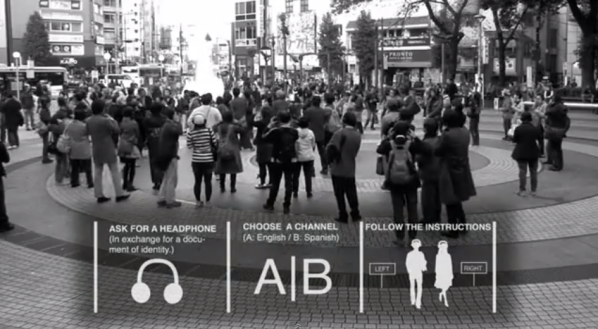
‘Public Domain’ also creates an appealing mobile bodily landscape. It is interesting to think about the relationship between the show and reality. The theatricality of the piece interacts with the social reality blurring boundaries, as one is part of the other. The piece is a social event that occurs outside the convention of a gallery, exhibition space or theatre. Thus, the citizens that are not part of the show assume this theatrical intervention as part of their reality, as part of the current social matters. The integration of technologies into the arts have widely contributed to perform new experiential practices. In this regard, technology plays an important role in triggering participation. Technology helps to distribute and operate instructions but also produce a specific aesthetics that appears thanks to the creation of hybrid practices.
The interaction among disciplines and fields has given birth to fruitful collaborations and cutting-edge practices in the arts. The current convergence of the fields of nanotechnology, cognitive science, biotechnology and communications (ITC) has given birth to the most prolific period of inventions and findings in the history of science. The possible intersections between the arts and sciences are gaining day by day a bigger interest but most of its potential is yet to be imagined. In which ways will these practices will contribute to social change? Is participation the key for a major public commitment in matters that affect our daily lives? ‘Public Domain’ proves that through a rather simple system significant concerns can be addressed in a playful but effective manner in a project that has already engaged audiences from over the world.
Roger Bernat – After studying architecture, he discovered theatre and at the age of 25 he entered the Institut del Teatre in Barcelona to study directing and dramaturgy. Soon after, he founded and directed, with Tomàs Aragay, the company General Elèctrica. Well known in Catalonia for their daring and engaged projects, General Elèctrica (1997-2001) created a dozen remarkable productions. Roger Bernat often concentrates on a variety of social groups (heroes, transsexuals, cab drivers, etc.) in his ongoing search for new theatrical forms. His best-known plays include Que algú em tapi la boca (2001), Bona gent (2003) in collaboration with Juan Navarro, Amnèsia de fuga (2004), LA LA LA LA (2004), Tot és perfecte (2005) and Das Paradies Experiment (2007). Apart from his stage work, Roger Bernat also directs videos. http://rogerbernat.info/en/
I met Eugenio Tisselli in Edinburgh at the Remediating the Social conference in November 2012. Eugenio gave a presentation on the project Sauti ya wakulima, “The voice of the farmers”: A collaborative knowledge base created by farmers from the Chambezi region of the Bagamoyo District in Tanzania, and “by gathering audiovisual evidence of their practices they use smartphones to publish images and voice recordings on the Internet”, documenting and sharing their daily practices.
I was struck by his sensitivity to the social contexts and political questions around this type of project engagement. This interview explores the challenges we all face in connecting to a deeper understanding of what technology can succeed in doing beyond the usual hype of the ‘New’ and its entwined consumerist diversions. Not only does the conversation highlight how communities can work together in collaborating with technology on their own terms. But, it also discusses the artists’ role in the age of climate change and the economic crisis, locally and globally.
Marc Garrett: Can you explain how and why the Sauti ya wakulima, “The voice of the farmers” project came about?
Eugenio Tisselli: Sauti ya wakulima is the fruit of my collaboration in the megafone project, started in 2004 by Catalan artist Antoni Abad. During six years, we worked with different groups at risk of social exclusion, such as disabled people, immigrants or refugees. The idea was to provide these groups with the tools to make their voices heard: smartphones with a special application that made it easy to capture images, sound recordings or short videos, and a web page where these contents could be directly uploaded. Using these tools, the participants of each project were able to create a collaborative, online “community memory”, in which they could include whatever they considered to be relevant. Although megafone was relatively successful and, in some cases, made a positive impact on the people who participated, I was worried that the project was becoming too dispersive. We worked in six countries, with extremely different groups. So, in 2011, I decided to follow my own path and apply a similar methodology into more focused projects, related with sustainable agriculture and environmental issues. I realized that the projects which sought to increase the empowerment of a community could become too complex for a single artist to handle. That’s why, in Sauti ya wakulima, I’m not “the artist”, but a member of a transdisciplinary team which includes biologists, agricultural scientists and technicians. Such a team came together after my PhD advisor Angelika Hilbeck, my colleague Juanita Sclaepfer-Miller and myself came across the possibility of working with farmers in Tanzania. The network formed by local researchers, farmers and ourselves was quickly formed, so we started the project on March, 2011.
MG: I find it interesting that you made the decision to put the role of artist aside. This reminds me of a discussion in Suzi Gablik’s book published in 1995 ‘Conversations before the end of time’; where James Hillman in an interview talks about learning to refocus our attention from ourselves and onto the world. Further into the conversation Gablik says “In our culture, the notion of art being a service to anything is an anathema. Service has been totally deleted from our view point. Aesthetics doesn’t serve anything but itself and its own ends”.[2]
So, I have two questions here. The first is how important was it for you to put aside your status as an ‘artist’, and what difference did it make?
And, where do you think you and others may fit when considering the discussion between Gablik and Hillman?
ET: It is important for me to make it clear that I didn’t abandon my role as an artist. Instead, I fully assumed my status, but only as a member of a transdisciplinary team. I believe that this may be a point of departure from the classical view of the artist as a “lone genius”, which is closely related to the discussion about service in art. So I’ll try to interweave both questions together. In a recent publication, Pablo Helguera aimed to set a curriculum for socially engaged art. He identified the new set of skills to be acquired by the artists, and the issues they must address when dealing with social interaction. But, as Helguera suggests, perhaps what’s most important is to overcome the “prevailing cult of the individual artist”, which becomes problematic for those whose goal is “to work with others, generally in collaborative projects with democratic ideals.” [3] To me, this implies that the artist must give up control of the work to a certain degree. I find myself in this scenario, and I think of my role in Sauti ya wakulima as that of an instigator and coordinator. Furthermore, all of us involved in Sauti ya wakulima aim to effect actual changes in the lives of the participating farmers, rather than obtaining purely symbolic results. Our project is a socially engaged artwork that wants to be useful, to deliver a service.
We are living in urgent times, beyond any doubt. Looming global challenges, such as climate change, radically cancel the luxury of being useless, of not doing anything. This includes the artist who, as any other citizen, is called to use his or her abilities to help in preventing a catastrophe. I especially like Franco “Bifo” Berardi’s proposal about the new task that the artist might assume: that of reconstructing the conditions for social solidarity. This work of reconstruction would oppose competition, a value often found in the markets that deal with self-referential, self-serving artworks. Solidarity, writes Berardi, is neither an ethical nor a political program, but a pure aesthetic pleasure [4]. In my opinion, the artists who still embrace the idea that art should only serve its own ends will become those who play the lyre while our world burns.

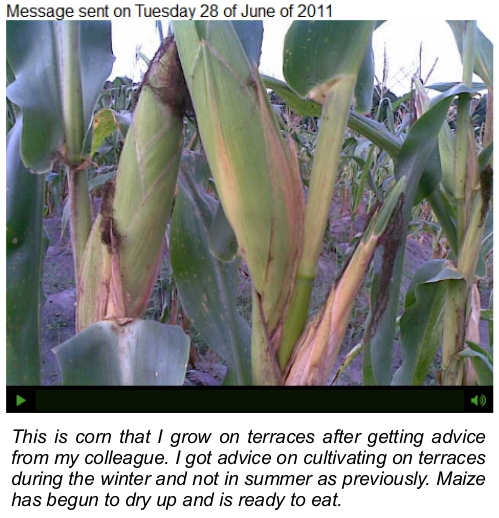
MG: What kind of behaviours began to emerge once the farmers took control of the smartphones supplied?
ET: It was quite interesting to see that the farmers started to use the phones for purposes which were different from those that we had originally proposed. This happened very soon after the project started. Only one month had passed, and the farmers had already started to go beyond merely documenting the effects of climate change. They interviewed other farmers, and asked them all sorts of questions about their crops and agricultural techniques, their opinions and views. In short, they slowly laid out a web of mutual learning. This was a real eye-opener for us. As we began to observe this, the environmental researchers in the team became worried that the farmers were deviating from the goals that we had set. I wanted to leave room for this deviation, as I was particularly interested in studying the process of technological appropriation. So I had to convince the researchers that we should leave enough room for the farmers to freely explore the potentials of the smartphones. It was not easy but, in the end, negotiating the tensions between a goal-oriented and an open-ended research turned out to be quite fruitful.
On one hand, the farmers found that they could shape the project to fit their interests which, as they said, were to “learn about what other farmers in remote areas were doing.” On the other, the researchers finally realized that the images and voice narrations posted by the farmers were an invaluable source of information about what was actually going on in the farms and within the communities. Sometimes, agricultural initiatives may be designed with an insufficient understanding of the social context in which they are applied. By allowing the farmers to publish a wide range of topics, Sauti ya wakulima became a “community memory” that reveals rich details about farming and the social life of rural communities in Bagamoyo.

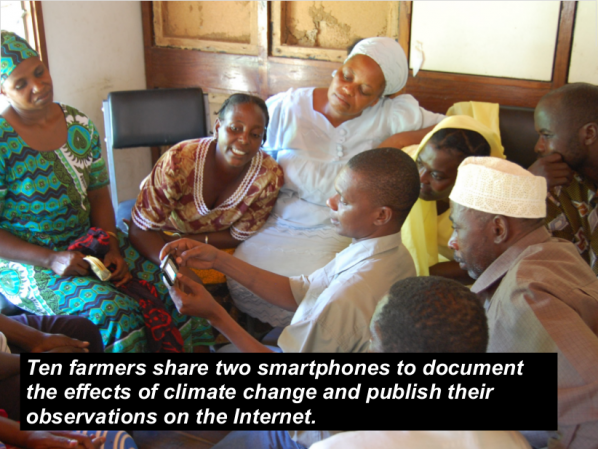
MG: In your presentation at Remediating the Social, I remember a quote from one of the farmers saying “The project helped me learn that phones can be used for other things besides calling people, and that computers can also be used to solve problems: they are not just a fancy thing for the rich people in towns.” What’s interesting here is, these words could be said any where. And that our consumer orientated culture could still learn a few things regarding uses of technology.
What lessons can the farmers teach ‘us’ in a culture where computers are part of the everyday life?
ET: I have interpreted this particular quote in two different ways. The first, most obvious one, is that the farmers discovered that the smartphones and the web can be useful tools, which may be shaped and adapted to meet their needs. For many of them, Sauti ya wakulima was their first chance at trying out these technologies. And, happily, the project showed us all that they can become an important ingredient in making farmers’ lives a little better.
However, my second interpretation is not as optimistic: in the quote, there is an explicit comparison between the (poor) farmers living in remote areas and “the rich people in towns.” Moreover, the fact that smartphones are explicitly considered as fancy devices points towards issues which need to be handled very carefully. In every part of the world, technological gadgets are quickly becoming symbols of social status. Currently, I am working in a rural zone in southern Mexico where cellphone coverage was nonexistent only two years ago. But as soon as the first antennas were installed, young people in those communities started buying smartphones, and now there is an open competition to see who has the fanciest one. A similar thing happens in Bagamoyo.
So, of course, smartphones can be useful tools, but they can also bring more consumerism into poor communities. This is very dangerous. I’d like to stress that, in our project, the smartphones are used as shared tools. This means that there is a limited number of devices available, and everyone must have a chance to use them at least once. I believe that this is a small but significant contribution towards diluting the extreme individualism and consumerism that are closely linked to these technologies.
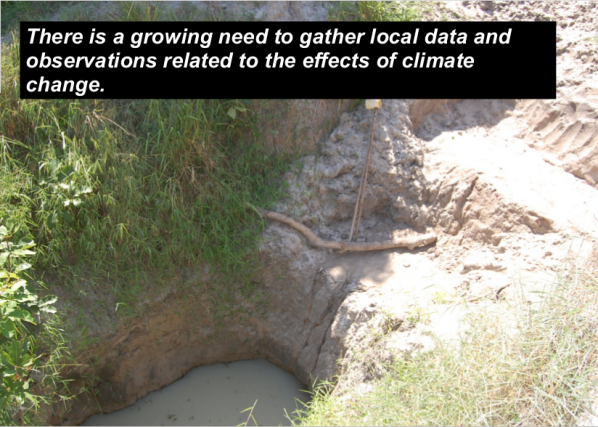
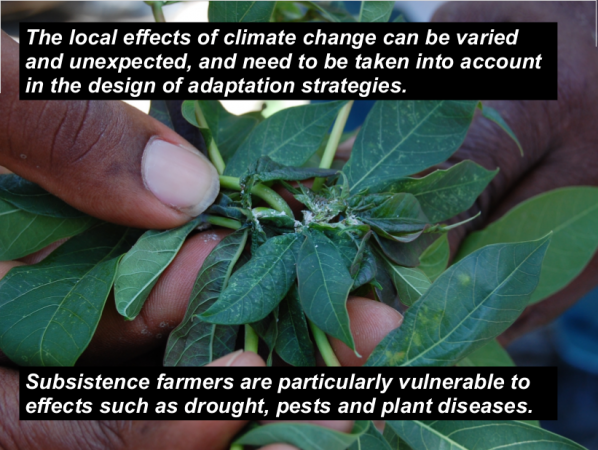
The farmers I have met in Bagamoyo have a very strong sense of community. Although their farms can be very far apart, sometimes with no roads between them, they still get together very often. They work together, learn together, have fun together. That’s the biggest lesson I’ve learned: we need each other’s presence. Quoting “Bifo” again, we are living in a time of precarization of the encounter of bodies in physical space. I agree with him that the most important poetic revolution has to be the re-activation of bodies. The farmers, with the great efforts they make to get together, and the great joy they find in doing so, have taught me a great deal: I need to get out of Facebook and step in to the “here and now”, together with others.
MG: What has this experience taught you. And how will it impact your future practice as an artist?
ET: I have partially replied to the first part of this question. But besides learning how to re-dimension the importance of computers in my life, I have also learnt a lot about agriculture. This is not a minor thing for me: after all these years of living in big cities, and realizing that I lack a basic connection to the earth, I believe I have found the best possible teachers. Of course, I’ve also learnt a lot about how to work with non-expert users of technology. This has made me better as a teacher. And, as you can imagine, many of the things we take for granted at home won’t necessarily work in Bagamoyo. So, doing projects in difficult environments has taught me to adapt, and to transform things that escape my control into opportunities. All of this changes me, not only as an artist but as a human being. My artistic practice is already quite different from what it was before Sauti ya wakulima. I have adopted a very critical position towards technology. Now, this is also a major shift: I started programming creatively when I was ten years old, and have been a media artist almost since then. But I feel I can’t go on with those artistic explorations, knowing what I know now. Consequently, last year I wrote and published a small note explaining why I stopped creating works of e-Literature, a field in which I was involved for more than ten years [5]. That was both a closure and a point of departure. Let’s see what the future brings.
Excerpt from ‘Why I have stopped creating e-Lit’ by Tisselli (November 25th, 2011)
Dear friends: this morning I went for a walk along the Naviglio Grande in Milan, and I entered a shop selling second-hand books. There I found a small book, “The Computer in Art”, by Jasia Reichardt, published in London in 1971. The book described the works of pioneers of Computer Art, such as Charles Csuri or Michael Noll, who were active at that time. A real gem. But the biggest surprise came when I turned to the last page, on which the previous owner had written: “I married on 23, November. I would like to be a man, not artist, not engineer, a man.”
I took the book with me.
Those involved in the Sauti ya wakulima / The voice of the farmers project.
The farmers: Abdallah Jumanne, Mwinyimvua Mohamedi, Fatuma Ngomero, Rehema Maganga, Haeshi Shabani, Renada Msaki, Hamisi Rajabu, Ali Isha Salum, Imani Mlooka, Sina
Rafael.
Group coordinator / extension officer: Mr. Hamza S. Suleyman
Scientific advisors: Dr. Angelika Hilbeck (ETHZ), Dr. Flora Ismail (UDSM)
Programming: Eugenio Tisselli, Lluís Gómez
Translation: Cecilia Leweri
Graphic design: Joana Moll, Eugenio Tisselli
Project by: Eugenio Tisselli, Angelika Hilbeck, Juanita Schläpfer-Miller
Sponsored by: The North-South Center, Swiss Federal Institute of Technology – Zürich
With the support of: The Department of Botany, University of Dar es Salaam (UDSM)
The activist initiatives of this art group from Vienna seem fascinating due to its art-tech philosophy, and it puts a smile on my face due to its pop attitude. In May 2011, Günther Friesinger, one of the creators of monochrom, gave a lecture to Media Art Histories students of the Donau Universität, which inspired me to arrange an interview with him. The first question I asked was about establishing monochrom. Günther explained that “monochrom came into being in 1993 as a fanzine for cyberculture, science, theory, cultural studies and the archaeology of pop culture in everyday life. Its collage format is reminiscent of both the early DIY fanzines of the punk and new wave underground and the art books of figures such as Dieter Roth, Martin Kippenberger and others. For a while now, monochrom has been venturing further than publishing alone and has been responsibly influencing people’s minds via film production, performances and festivals. If you are in Vienna in autumn by chance, look at the paraflows festival – one of the main projects run by monochrom.
Natascha Fuchs: How much has monochrom’s aims changed since 1993?
Günther Friesinger: We didn’t really develop a concept back then; monochrom has evolved. In the beginning, there was only the idea of publishing a fanzine – lots of other things resulted from that. At some point, we started doing performances. In the Internet’s primordial age, we developed a robot that could be controlled via the web, and so we began entering the art scene. Our first exhibition was in 1998 in the Secession, Vienna. Unfortunately, they didn’t have Internet access back then, so our little robot stood in a corner, immobile. The people visiting the exhibition back then still considered it interesting enough to some extent, but many things back then didn’t work the way we’d have liked them to work.
NF: Art, technology and philosophy – are they equal for monochrom? What is the starting point for monochrom’s particular initiatives?
GF: We are a political group that gives statements through different means, those of art in all its varieties. I think it is important for us to find a fitting medium for the right story. This is something that specifically characterises us as a group. There are many different actions implicated by that, such as writing plays, making a movie, producing a music CD or writing a book. Normally, people try to achieve excellence in one medium. With us, it’s the other way round. That’s why we’re active in so many different areas.
NF: Which historical background concerning the relationship of philosophy, art and technology is especially meaningful for you?
GF: A difficult question. I think that Guy Debord and the Situationists are those one could consider most fitting. Certainly also some parts of Fluxus are of relevance.
NF: To which media theoreticians do you refer in your practice?
GF: I think that as a theorist, artist and curator in media art, net art, digital art and culture, it is important to confront oneself with theorists like Kittler, Luhmann, Flusser, McLuhan, Rheingold and many more. However, it is not the case that we refer to one theorist or another in all our works. I think that this system of self-affirmation through referral is quite interesting – but I think that for myself, monochrom and for our audience, there is a value added by self-generated theories for our projects and the discourses they cause.
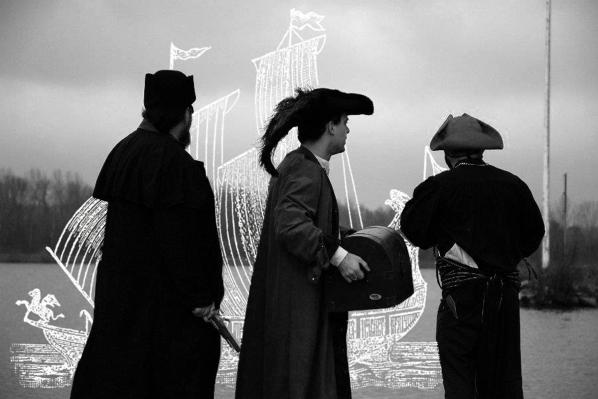
NF: What are international projects of monochrom? And what is the difference between monochrom audiences in Vienna and abroad?
GF: There are too many of those to be listed here. Since our big USA tour of 2005 we produce most of our projects bilingually in German and English, or only in English, in order to be able to have an international impact. Of course, many members of monchrom live and work in Vienna, and we also produce projects in Vienna, but our main focus is on our international presence. One of the big international projects, running since 2007 in San Francisco, is the Arse Elektronika: a conference on pornography, sci-fi, games and the development of technology. I would say that with the San Franciscans we’ve found the ideal community for such a conference.
NF: You call yourself “edu-hacker”. Why that and how is it connected with your studying and teaching experience?
GF: I have always loved reading, learning and continuing to further myself intellectually. I really enjoyed my studies and I enjoy sharing my knowledge and skills with my students. Universities are, in my book, places where it is possible to acquire knowledge, to reflect upon it, places of discussion and freedom. Because of the process of universities becoming more like schools, among other things caused by the Bologna Accords, those in my opinion are important areas that enable students to become self-reliant, critical people are struck from the curriculum. I’m trying to counteract this in my classes, trying to cause rifts in the school-like system, by using other methods of transmitting knowledge, using a great deal of humorous elements, and by always meeting the students eye to eye as equals.
NF: What is philosophical society in contemporary Austria now?
GF: Alive and kicking as always, I’d say 😉 One of the exciting things is that exactly now there are a lot of young, fascinating philosophers out there. The topics that I mostly concern myself with are, however, copyright, intellectual property, culture, art, media and technology.
NF: Is paraflows one of your biggest current projects? What’s the concept of this festival? Is it independent from monochrom activities?
GF: paraflows is surely one of the biggest projects that I am working on at the moment, apart from monochrom. monochrom helped to start and grow the festival in the first two years, as monochrom has done with many other projects worldwide. „paraflows – festival for digital art and culture“ has been established in the last seven years as a new annual festival situated between the Ars Elektronika and the Steirischer Herbst. It serves as both a platform for the young, local scene of digital art and culture and as an interface to international and renowned media art.
NF: How is monochrom activity is financed?
GF: We do get occasional subsidies for some projects, we get money from performances, the sale of our publications and sometimes the sale of a work of art, and recently we have also acquired crowdfunding. I’d say, however, that around 80% of the projects we do are not financed in any way and are purely done because we have fun doing them.
NF: Do your own curatorial projects serve in some way as a research method for you?
GF: I take the liberty that I only curate projects that I am very interested in myself. That is to say, projects where I have a very strong urge to explore the topic, to read, write and of course also to do research. That is probably the reason why I try to achieve a publication for each project that I curate, in order to give those who are interested in it some sort of preliminary report, a possibility to expand upon.
NF: Is activism capable to envision the future or does it just reflect, react on what is and has happened?
GF: It is getting increasingly difficult to be subversive. monochrom is fundamentally critical of the bourgeois world view. We examine it from a distance, dissociating ourselves from it. The question is: How do we get out? Our current late-capitalist aims for transgressions. That is to say that capitalism requires transgressions as a principle. Viennese Actionism, the most relevant cultural statement in Austria for the last hundred years, was doomed to fail at a certain point, because in the 60ies Austria still had a society based on discipline. One of the central strong points of monochrom: Finding the right story for the right medium could be a opportunity to deal with this situaltion.

NF: Which publications about monochrom you would recommend to read?
monochrom’s ISS. In space no one can hear you complain about your job. (2012)
monochrom’s Zeigerpointer. The wonderful world of absence (2011)
Urban Hacking. Cultural Jamming Strategies in the Risky Spaces of Modernity (2011)
monochrom #26-34: Ye Olde Self-Referentiality (2010)
Do Androids Sleep with Electric Sheep? (2009)
Pr0nnovation?: Pornography and Technological Innovation (2008)
monochrom: www.monochrom.at
paraflows festival: www.paraflows.at
(c) Natascha Fuchs is an independent expert in cultural projects management and international public relations, graduate of the University of Manchester (Cultural Management) in 2008. She has been living in Vienna, Austria, studying History of Media Arts at the Donau-Universität and collaborating with sound:frame Festival for audio:visual expressions, since her move from Moscow, Russia in 2011. In Russia she was related to MediaArtLab and Media Forum — the special program of the Moscow International Film festival dedicated to media arts, experimental films and digital context with more than 10 years history. As a researcher and practitioner, she works in a variety of topics and participates in different international projects focused on media arts, cinema and sound. Columnist and writer for several online magazines.